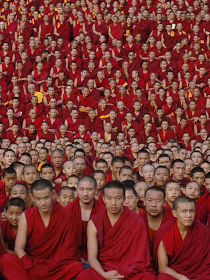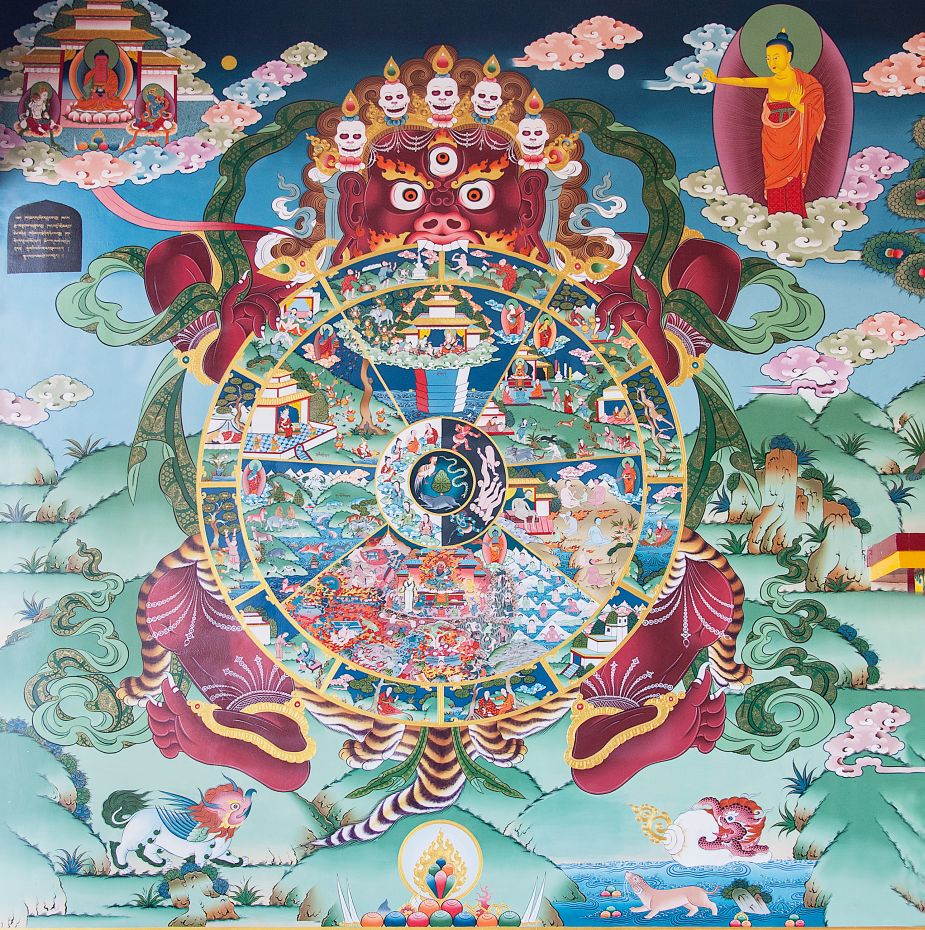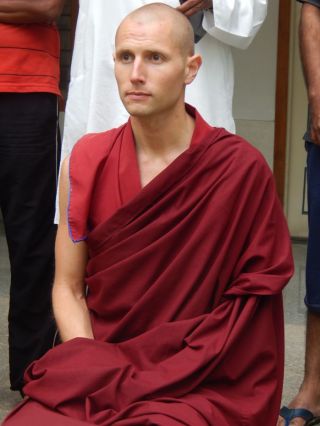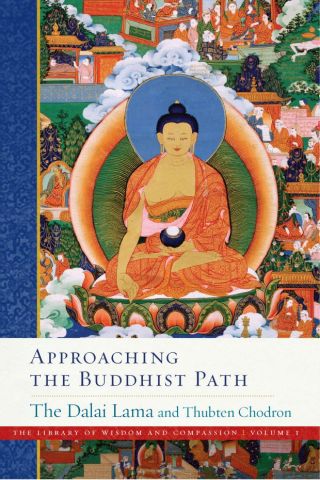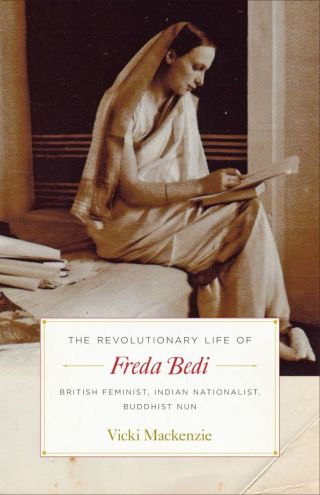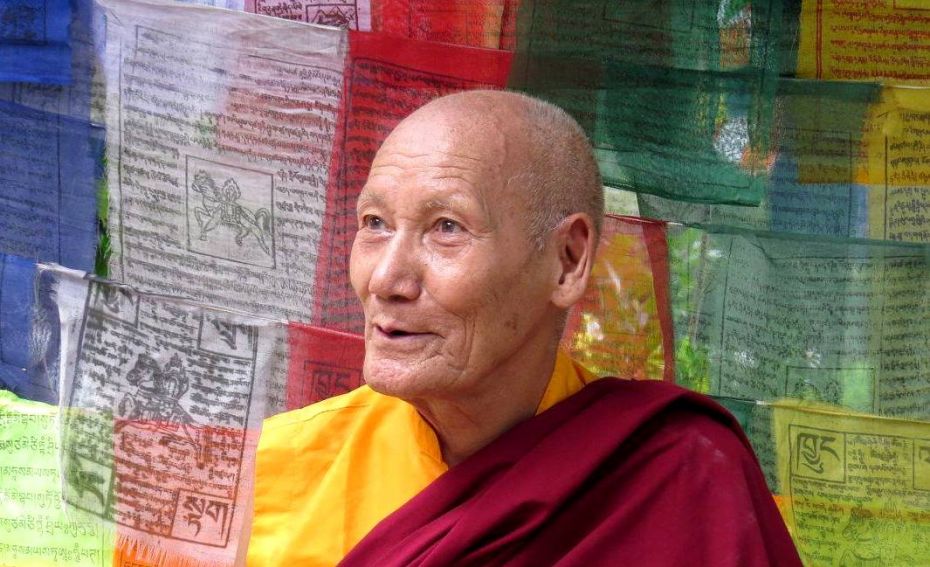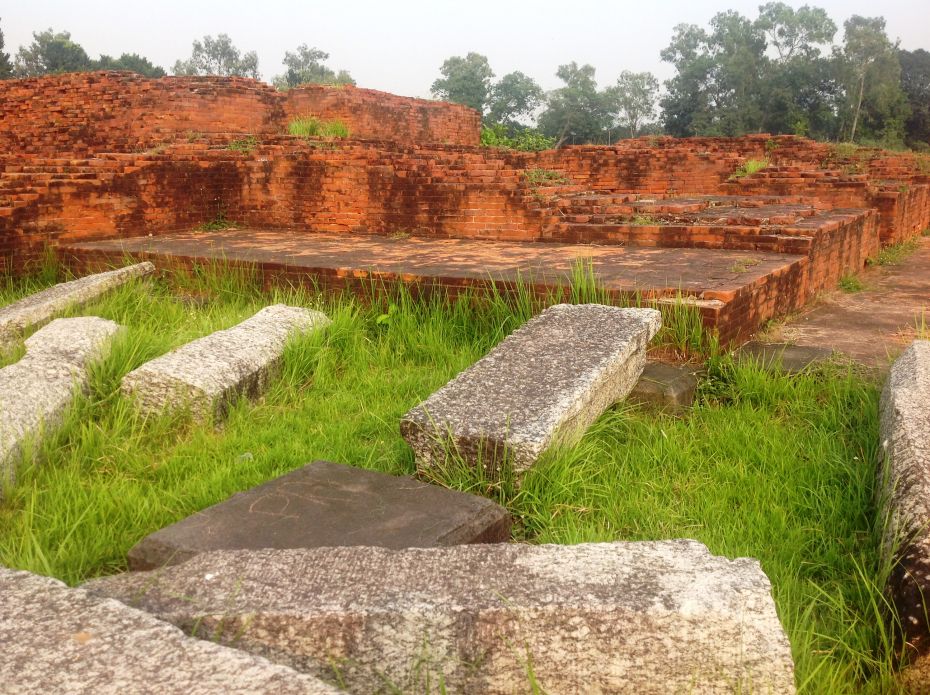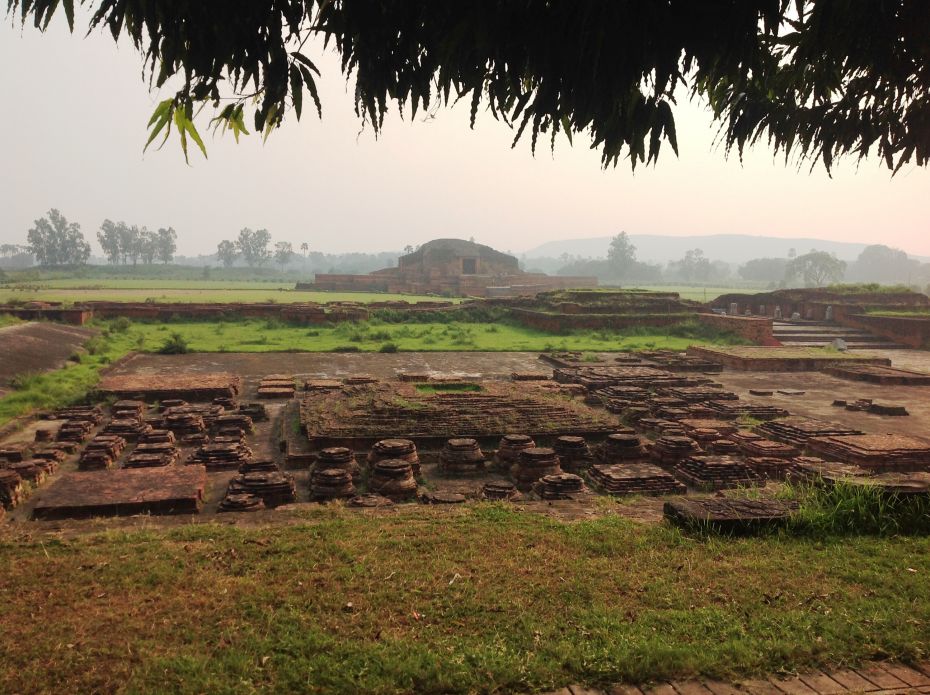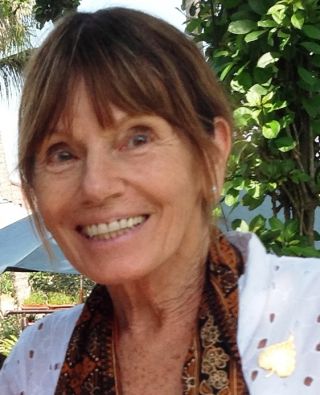- Home
- FPMT Homepage
Foundation for the Preservation of the Mahayana Tradition
The FPMT is an organization devoted to preserving and spreading Mahayana Buddhism worldwide by creating opportunities to listen, reflect, meditate, practice and actualize the unmistaken teachings of the Buddha and based on that experience spreading the Dharma to sentient beings. We provide integrated education through which people’s minds and hearts can be transformed into their highest potential for the benefit of others, inspired by an attitude of universal responsibility and service. We are committed to creating harmonious environments and helping all beings develop their full potential of infinite wisdom and compassion. Our organization is based on the Buddhist tradition of Lama Tsongkhapa of Tibet as taught to us by our founders Lama Thubten Yeshe and Lama Thubten Zopa Rinpoche.
- Willkommen
Die Stiftung zur Erhaltung der Mahayana Tradition (FPMT) ist eine Organisation, die sich weltweit für die Erhaltung und Verbreitung des Mahayana-Buddhismus einsetzt, indem sie Möglichkeiten schafft, den makellosen Lehren des Buddha zuzuhören, über sie zur reflektieren und zu meditieren und auf der Grundlage dieser Erfahrung das Dharma unter den Lebewesen zu verbreiten.
Wir bieten integrierte Schulungswege an, durch denen der Geist und das Herz der Menschen in ihr höchstes Potential verwandelt werden zum Wohl der anderen – inspiriert durch eine Haltung der universellen Verantwortung und dem Wunsch zu dienen. Wir haben uns verpflichtet, harmonische Umgebungen zu schaffen und allen Wesen zu helfen, ihr volles Potenzial unendlicher Weisheit und grenzenlosen Mitgefühls zu verwirklichen.
Unsere Organisation basiert auf der buddhistischen Tradition von Lama Tsongkhapa von Tibet, so wie sie uns von unseren Gründern Lama Thubten Yeshe und Lama Thubten Zopa Rinpoche gelehrt wird.
- Bienvenidos
La Fundación para la preservación de la tradición Mahayana (FPMT) es una organización que se dedica a preservar y difundir el budismo Mahayana en todo el mundo, creando oportunidades para escuchar, reflexionar, meditar, practicar y actualizar las enseñanzas inconfundibles de Buda y en base a esa experiencia difundir el Dharma a los seres.
Proporcionamos una educación integrada a través de la cual las mentes y los corazones de las personas se pueden transformar en su mayor potencial para el beneficio de los demás, inspirados por una actitud de responsabilidad y servicio universales. Estamos comprometidos a crear ambientes armoniosos y ayudar a todos los seres a desarrollar todo su potencial de infinita sabiduría y compasión.
Nuestra organización se basa en la tradición budista de Lama Tsongkhapa del Tíbet como nos lo enseñaron nuestros fundadores Lama Thubten Yeshe y Lama Zopa Rinpoche.
A continuación puede ver una lista de los centros y sus páginas web en su lengua preferida.
- Bienvenue
L’organisation de la FPMT a pour vocation la préservation et la diffusion du bouddhisme du mahayana dans le monde entier. Elle offre l’opportunité d’écouter, de réfléchir, de méditer, de pratiquer et de réaliser les enseignements excellents du Bouddha, pour ensuite transmettre le Dharma à tous les êtres. Nous proposons une formation intégrée grâce à laquelle le cœur et l’esprit de chacun peuvent accomplir leur potentiel le plus élevé pour le bien d’autrui, inspirés par le sens du service et une responsabilité universelle. Nous nous engageons à créer un environnement harmonieux et à aider tous les êtres à épanouir leur potentiel illimité de compassion et de sagesse. Notre organisation s’appuie sur la tradition guéloukpa de Lama Tsongkhapa du Tibet, telle qu’elle a été enseignée par nos fondateurs Lama Thoubtèn Yéshé et Lama Zopa Rinpoché.
Visitez le site de notre Editions Mahayana pour les traductions, conseils et nouvelles du Bureau international en français.
Voici une liste de centres et de leurs sites dans votre langue préférée
- Benvenuto
L’FPMT è un organizzazione il cui scopo è preservare e diffondere il Buddhismo Mahayana nel mondo, creando occasioni di ascolto, riflessione, meditazione e pratica dei perfetti insegnamenti del Buddha, al fine di attualizzare e diffondere il Dharma fra tutti gli esseri senzienti.
Offriamo un’educazione integrata, che può trasformare la mente e i cuori delle persone nel loro massimo potenziale, per il beneficio di tutti gli esseri, ispirati da un’attitudine di responsabilità universale e di servizio.
Il nostro obiettivo è quello di creare contesti armoniosi e aiutare tutti gli esseri a sviluppare in modo completo le proprie potenzialità di infinita saggezza e compassione.
La nostra organizzazione si basa sulla tradizione buddhista di Lama Tsongkhapa del Tibet, così come ci è stata insegnata dai nostri fondatori Lama Thubten Yeshe e Lama Zopa Rinpoche.
Di seguito potete trovare un elenco dei centri e dei loro siti nella lingua da voi prescelta.
- 欢迎 / 歡迎
简体中文
“护持大乘法脉基金会”( 英文简称:FPMT。全名:Foundation for the Preservation of the Mahayana Tradition) 是一个致力于护持和弘扬大乘佛法的国际佛教组织。我们提供听闻,思维,禅修,修行和实证佛陀无误教法的机会,以便让一切众生都能够享受佛法的指引和滋润。
我们全力创造和谐融洽的环境, 为人们提供解行并重的完整佛法教育,以便启发内在的环宇悲心及责任心,并开发内心所蕴藏的巨大潜能 — 无限的智慧与悲心 — 以便利益和服务一切有情。
FPMT的创办人是图腾耶喜喇嘛和喇嘛梭巴仁波切。我们所修习的是由两位上师所教导的,西藏喀巴大师的佛法传承。
繁體中文
護持大乘法脈基金會”( 英文簡稱:FPMT。全名:Found
ation for the Preservation of the Mahayana Tradition ) 是一個致力於護持和弘揚大乘佛法的國際佛教組織。我們提供聽聞, 思維,禪修,修行和實證佛陀無誤教法的機會,以便讓一切眾生都能 夠享受佛法的指引和滋潤。 我們全力創造和諧融洽的環境,
為人們提供解行並重的完整佛法教育,以便啟發內在的環宇悲心及責 任心,並開發內心所蘊藏的巨大潛能 — 無限的智慧與悲心 – – 以便利益和服務一切有情。 FPMT的創辦人是圖騰耶喜喇嘛和喇嘛梭巴仁波切。
我們所修習的是由兩位上師所教導的,西藏喀巴大師的佛法傳承。 察看道场信息:
- FPMT Homepage
- News/Media
-
- Study & Practice
-
-
- About FPMT Education Services
- Latest News
- Programs
- New to Buddhism?
- Buddhist Mind Science: Activating Your Potential
- Heart Advice for Death and Dying
- Discovering Buddhism
- Living in the Path
- Exploring Buddhism
- FPMT Basic Program
- FPMT Masters Program
- FPMT In-Depth Meditation Training
- Maitripa College
- Lotsawa Rinchen Zangpo Translator Program
- Universal Education for Compassion & Wisdom
- Online Learning Center
-
- Prayers & Practice Materials
- Overview of Prayers & Practices
- Full Catalogue of Prayers & Practice Materials
- Explore Popular Topics
- Benefiting Animals
- Chenrezig Resources
- Death & Dying Resources
- Lama Chopa (Guru Puja)
- Lama Zopa Rinpoche: Compendium of Precious Instructions
- Lama Zopa Rinpoche: Life Practice Advice
- Lama Zopa Rinpoche Practice Series
- Lamrim Resources
- Mantras
- Prayer Book Updates
- Purification Practices
- Sutras
- Thought Transformation (Lojong)
- Audio Materials
- Dharma Dates - Tibetan Calendar
- Translation Services
- Publishing Services
- Ways to Offer Support
- Prayers & Practice Materials
-
- Teachings and Advice
- Find Teachings and Advice
- Lama Zopa Rinpoche Advice Page
- Lama Zopa Rinpoche: Compendium of Precious Instructions
- Lama Zopa Rinpoche Video Teachings
- ༧སྐྱབས་རྗེ་བཟོད་པ་རིན་པོ་ཆེ་མཆོག་ནས་སྩལ་བའི་བཀའ་སློབ་བརྙན་འཕྲིན།
- Podcasts
- Lama Yeshe Wisdom Archive
- Buddhism FAQ
- Dharma for Young People
- Resources on Holy Objects
- Teachings and Advice
-
-
*If a menu item has a submenu clicking once will expand the menu clicking twice will open the page.
-
-
- Centers
-
- Teachers
-
- Projects
-
-
-
-
*If a menu item has a submenu clicking once will expand the menu clicking twice will open the page.
-
-
- FPMT
-
-
-
-
-
One must practice with the bodhisattva attitude every day. People can’t see your mind, what people see is a manifestation of your attitude in your actions of body and speech. Pay attention to your attitude all the time, guard it as if you are the police, or like a maid cares for a child, like a bodyguard, or like you are the guru and your mind is your disciple.
Lama Zopa Rinpoche
-
-
-
- Shop
-
-
-
The Foundation Store is FPMT’s online shop and features a vast selection of Buddhist study and practice materials written or recommended by our lineage gurus. These items include homestudy programs, prayers and practices in PDF or eBook format, materials for children, and other resources to support practitioners.
Items displayed in the shop are made available for Dharma practice and educational purposes, and never for the purpose of profiting from their sale. Please read FPMT Foundation Store Policy Regarding Dharma Items for more information.
-
-
In-depth Stories
31
Pilgrimage to the Hidden Valley of Tsum, Nepal
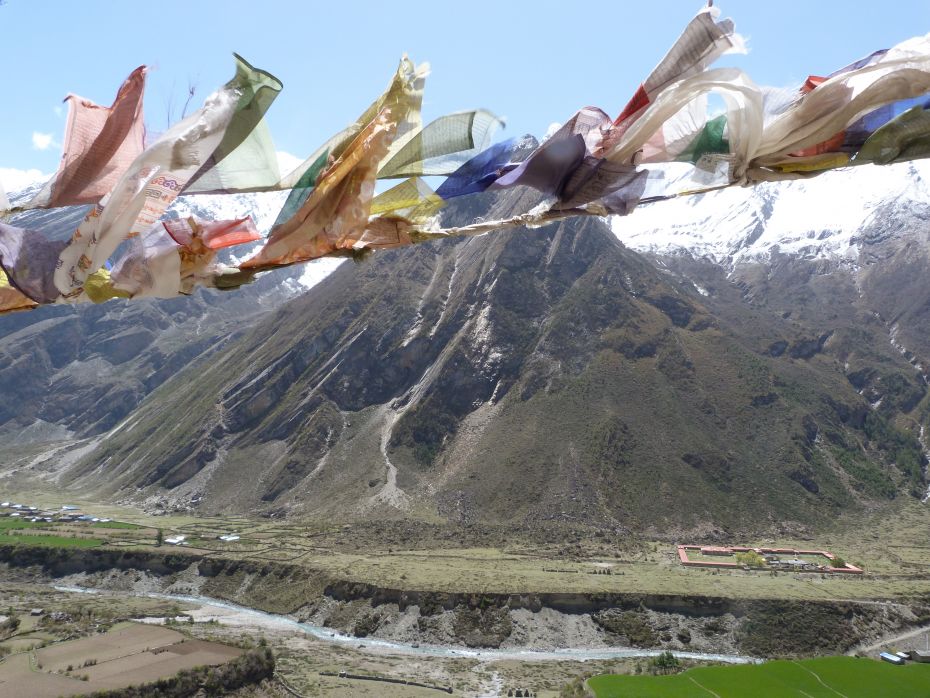
Frayed prayer flags flying over Tsum, Nepal, May 2018. Photo by Tsum pilgrimage participant.
In the remote borderlands of the high Himalayas, several valleys are said to be beyul—hidden or secret valleys—only open to those with very pure minds and hearts. According to ancient scriptures, they were established by Guru Rinpoche, the 8th-century Indian saint credited with spreading Buddhism into the Himalayas and Tibet.
In the 17th century the Tsum valley that branches off the Buri Gandaki River towards the north of Ganesh Himalaya (Mountain) in upper Gorkha District, Nepal, was named Beyul Kyimolung. Perhaps one of Nepal’s most beautiful valleys, it is cut off from the southern lowlands of Nepal by deep, forested gorges and swift rivers, and from Tibet in the north by snow-covered passes.
In May 2018 a group of twenty-two pilgrims, including Losang Dragpa Center resident teacher Geshe Jampa Tsundu, Tsum Project coordinator and former Rinchen Jangsem Ling secretary Low Yuet Kiew (“YK”), and FPMT Southeast Asia regional coordinator Selina Foong traveled together to Tsum, Nepal. Here, Selina shares her experience of the pilgrimage.
When I first heard that my friend YK, who is a member of two FPMT centers in Malaysia—Losang Dragpa Centre and Rinchen Jangsem Ling—was organizing a trip to the hidden valley of Tsum, Nepal, my hand shot up so fast that I just about dislocated my shoulder. Only later did random thoughts start to niggle. Will the helicopter ride cost a fortune? What sort of altitude are we talking about? The last time I hiked up any mountain (more like a hill by Nepal standards) was several years ago—how will my knees, now thrashed, hold up?
All doubts dissipated as our departure date neared. The time has come for sheer excitement! Final trip arrangements, lunch at Khachoe Ghakyil Ling Nunnery in Kathamandu, Nepal, a trial climb up to 2,700 meters (8,858 feet) altitude outside Kathmandu, kora at Boudha Stupa, and two peaceful nights in Kopan Monastery brought us to the day, Thursday, May 10, 2018, when we left the world behind and entered a blessed realm filled with riches far beyond our imagination.
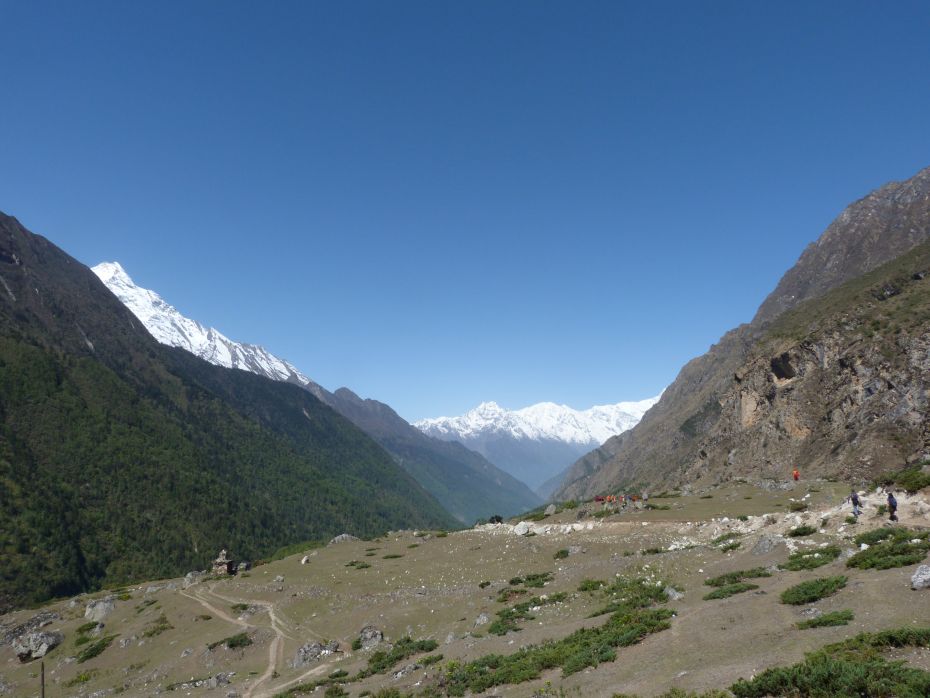
Tsum, Nepal, May 2018. Photo by Tsum pilgrimage participant.
Ethereal waterfalls tumbling down rugged mountains so steep they were just about vertical. Jagged snowy peaks luminous from the rays of the sun as far as the eye could see. A lone eagle of majestic wing span, slowly soaring over the vast valley below. Holy caves latent with the enlightened energy of past meditators, including Milarepa and Geshe Lama Konchog. The inspiring spirituality and genuine kindness of virtually everybody we met. Simply recalling all this is making my heart ache with the sweetest yearning.
It took four helicopters to ferry twenty-two of us from Kathmandu to Tsum. They were not kidding about strict weight controls. Only 10kg (22 lbs) of luggage each, which really wasn’t much considering that we would be staying at Rachen Nunnery in Tsum for one week. Inevitably, manic and desperate curtailing went on in many a Kopan bedroom the night before departure!
I will never forget my first sight of Rachen Nunnery. With jaws already slack from forty minutes of gaping at one spectacular mountain after another, Geshe Jampa Tsundu suddenly exclaimed, “Look! Rachen!”
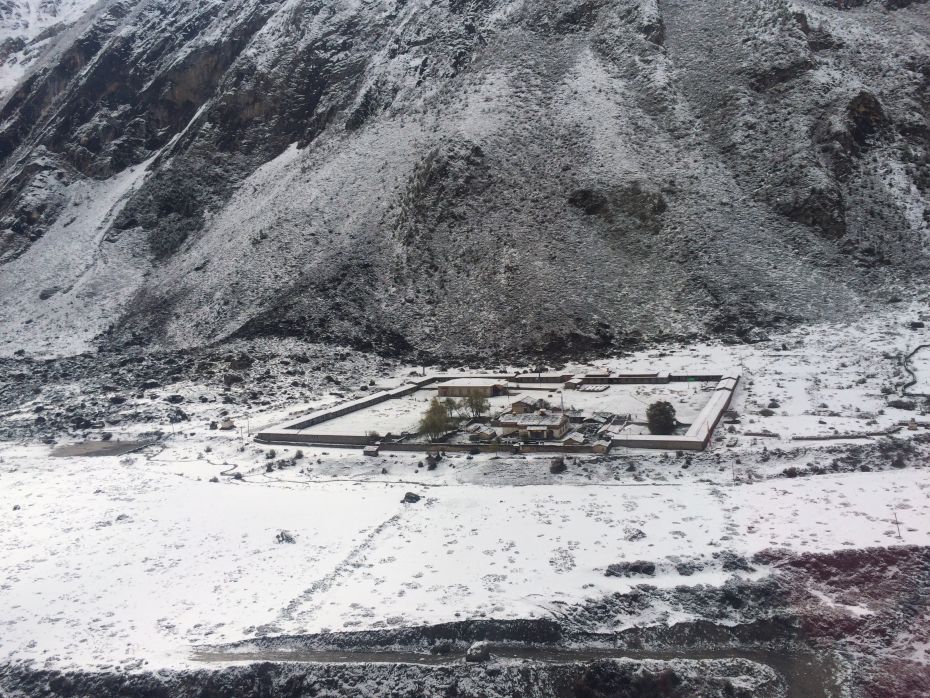
Rachen Nunnery seen from a helicopter, Tsum, Nepal, May 2018. Photo by Tsum pilgrimage participant.
Geshe-la was almost as excited as we were! It had been several years since he himself was there as resident teacher, and he was so looking forward to seeing all the monks and nuns again.
I stared into the distance. “Yes, I see it!” A low flat structure laid out in a huge square sharply contrasted against an expansive white wonderland. After years of hearing, reading, and talking about this place, I could hardly believe that we were actually about to land in it.

Landing at Rachen Nunnery, Tsum, Nepal, May 2018. Photo by Tsum pilgrimage participant.
With my first step out of the helicopter I got a jolt. It was cold! The morning’s snowfall had turned into freezing drizzle by the time my helicopter (number three) landed. An auspicious welcome no doubt, but this blast of cold after the Kathmandu heat sent shock waves through my undoubtedly tropical heart.
Greetings, khatas, shouts of delight,—then we all hurried along into the warmth of the dining room for very hot tea. And so passed our first day at Rachen.
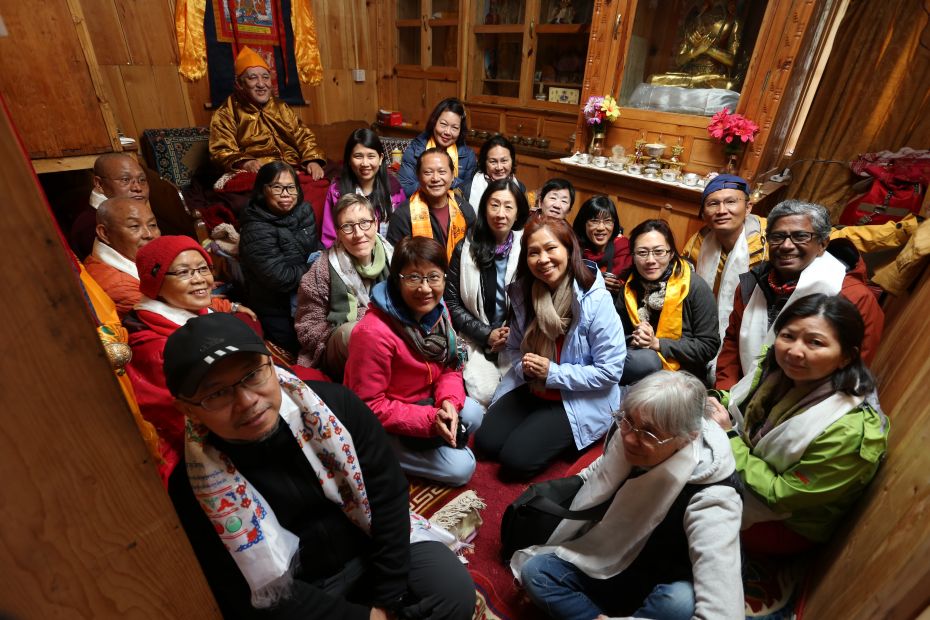
Pilgrimage group with Drukpa Rinpoche, Tsum, Nepal, May 2018. Photo by Tsum pilgrimage participant.
Among a blur of happiness and wonder was a group audience with Drukpa Rinpoche, who in his past life had founded both Mu Monastery and Rachen Nunnery. This was an unexpected bonus, as Rinpoche normally resides in India these days and “just happened” to be at Rachen. How wonderful!
We also toured the extensive nunnery grounds, which included the original and new gompa buildings, as well as an evocative house built by Geshe Lama Konchog himself.
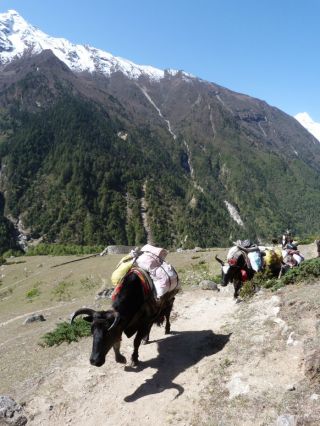
Yak carrying loads up a trail, Tsum, Nepal, May 2018. Photo by Tsum pilgrimage participant.
And on both sides of this flat valley, towering mountains pushed ever upwards into a wide open sky.
Natural splendor aside, the harshness of everyday life was also evident. Food had to be grown at the nunnery grounds or picked from the wild, and occasional one-day walks through the mountains into Tibet were necessary in order to obtain more groceries.
To keep warm, firewood had to be gathered from the nearby jungles (“nearby” being a relative term in Nepal) and hauled back to the nunnery. There was only solar energy to rely on, so needless to say, cloudy days meant icicles in the shower for those foolhardy enough to make the attempt.
Our second day dawned bright and clear, and we joined the nuns in their daily Tara Puja before setting off on our first hike.
First up, Milarepa’s Cave of the Doves! Here, dakinis had transformed into doves in order to listen to the Dharma from Milarepa. There were three separate but adjacent parts—a meditation gompa, a small cave with his very clear footprint on a large rock, and another small gompa with holy statues.
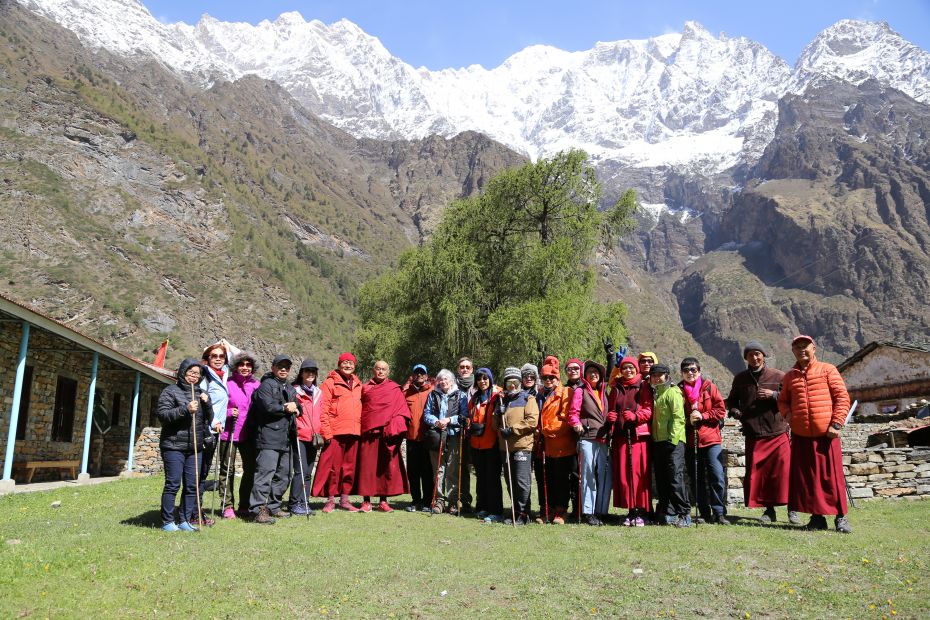
Leaving from Rachen Nunnery for the first hike, to Milarepa Cave of Doves, Tsum, Nepal, May 2018. Photo by Tsum pilgrimage participant.
How moving to peer out from those dim tiny spaces towards the endless snowy peaks beyond, and realize that the great saint Milarepa would have done much the same centuries ago, as he meditated on the nature of reality! Galvanized and inspired, I recalled this beautiful line from Calling the Lama from Afar: “Magnificently glorious guru, please bless me to abide one-pointedly in practice in isolated places, not having any hindrances to my practice.”
On our way down, we stopped at another holy cave. Here, the great yogi Geshe Lama Konchog had meditated. Gazing at the piles of stones and then further into the darkness, the tranquility was palpable.
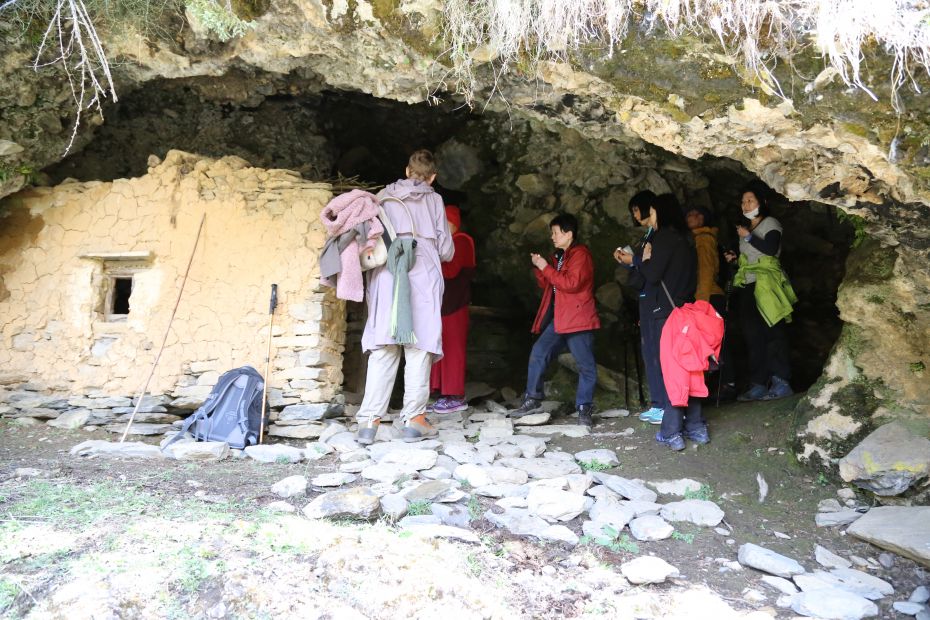
Visiting Geshe Lama Konchog’s retreat cave below Milarepa’s Cave of Doves, Tsum, Nepal, May 2018. Photo by Tsum pilgrimage participant.
As it turned out, these holy places had a way of suspending the normal passage of time in more ways than one. As we trekked back and looked at our watches, we were suddenly startled. What was to have been an easy walk this morning had turned into a five-hour expedition! Whoops! Blame it on all the posing and photos!
We sped up, got back, gulped down our very late lunch, then changed into brand new orange TSUM t-shirts for the grand opening of the Library of Nalanda Wisdom for Rachen Nunnery, an electronic library consisting of iPads and tablets that each of us had carried to Tsum from Kuala Lumpur, Malaysia, fully loaded with prayers and teachings. The nuns were so excited! What a happy afternoon it was, with speeches, laughter, applause, balloons, balloons, and yet more balloons.
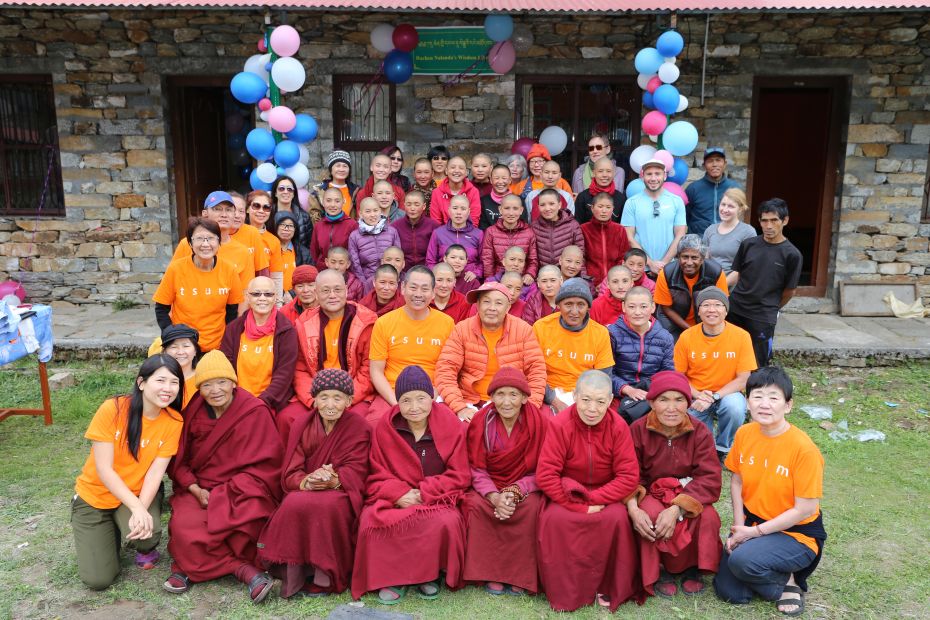
Grand opening of the electronic library at Rachen Nunnery, Tsum, Nepal, May 2018. Photo by Tsum pilgrimage participant.
A good night’s sleep set us up to walk three times further the next day.
Big excitement—we were going to Apey and Mochung’s house for lunch! Parents of both Tenzin Phuntsok Rinpoche (the reincarnation of the late Geshe Lama Konchog) and Thubten Rigsel Rinpoche (the reincarnation of the late Khensur Rinpoche Lama Lhundrup Rigsel), they were so endearingly kind, bending over backwards to return early to Tsum from Kathmandu, just to meet us and cook a huge lunch for us all.
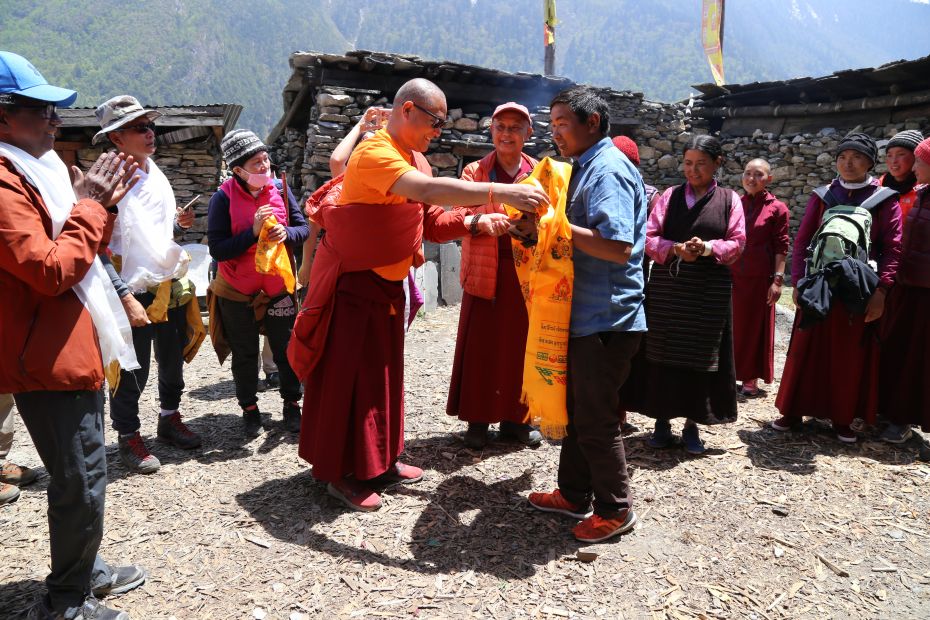
Geshe Jampa Tsundu thanking Apey and Mochung after lunch, Tsum, Nepal, May 2018. Photo by Tsum pilgrimage participant.
By the time this feast was over, however—and no doubt recalling our dismal pace yesterday—both Geshe Tsundu and Gen Tenpa Choeden decided that we would never make it to the Geshe Lama Konchog retreat cave Gaden Gompa behind Apey and Mochung’s house and be back at the nunnery before nightfall. Disappointment all round! But we were also grateful that they were so concerned for our safety.
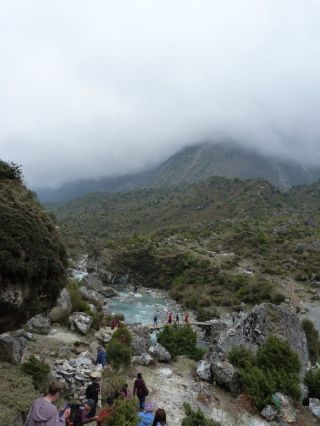
Hiking in Tsum, Nepal, May 2018. Photo by Tsum pilgrimage participant.
In any case, the trek back to Rachen was gorgeous as we took a different route through the jungles and then along the river, accompanied by strains of “Hala Hala ling ling chura chura ling ling! Hara hara ling ling!” sung by our jolly companion nuns.
By the time we all trekked (or staggered) back to the nunnery, our dear lamas must have taken pity on us. We probably looked truly bedraggled! And so it was declared: our program would be adjusted to allow the next day to be free and easy.
This was music to our ears! It also posed a golden opportunity for a few energetic and kiasu pilgrims—six of us to be exact.
Cornering Geshe Tsundu that evening, he finally agreed to lead us back the very next day to Gaden Gompa, where Geshe Lama Konchog had meditated for many years and completed 2,000 nyung nä retreats. But there were two conditions: we had to walk fast this time, and we could not stop every ten seconds to take photos! Like excited children, we agreed. Which was why the very next day, the six of us trotted off along with our Sangha guides at 7:46 a.m. sharp and obediently kept up the pace with military precision.
It turned out to be a very special day. The magnitude of the places we would be visiting that day was not lost on me, and I had made fervent prayers before leaving that we would have the karma to complete the day’s pilgrimage without mishap.
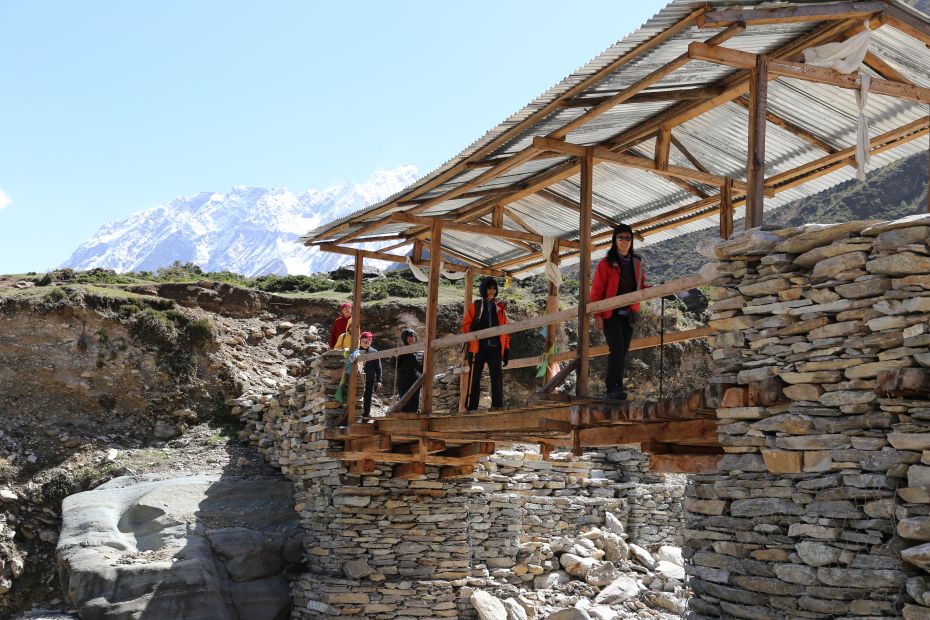
Hiking in Tsum, Nepal, May 2018. Photo by Tsum pilgrimage participant.
Finally, after an arduous climb, we arrived. All chatter stopped; a gentle hush fell.
As we entered the Geshe Lama Konchog retreat cave Gaden Gompa, I thought of every sentient being—all of them having played a role in bringing me to this point, in this life—and felt overwhelming gratitude toward them all. This experience was only possible in dependence upon all others, and so it was for all others that I experienced it.
Khata after khata was offered, as I also thought about all my dear Dharma friends and travel companions who did not make it that day. We spent a long time there inside the small hut as well as the open area behind it, where Geshe Lama Konchog’s robes and belongings remain sealed in a stone vault. Geshe Tsundu led the prayers and meditation before we finally hung our prayer flags and departed.
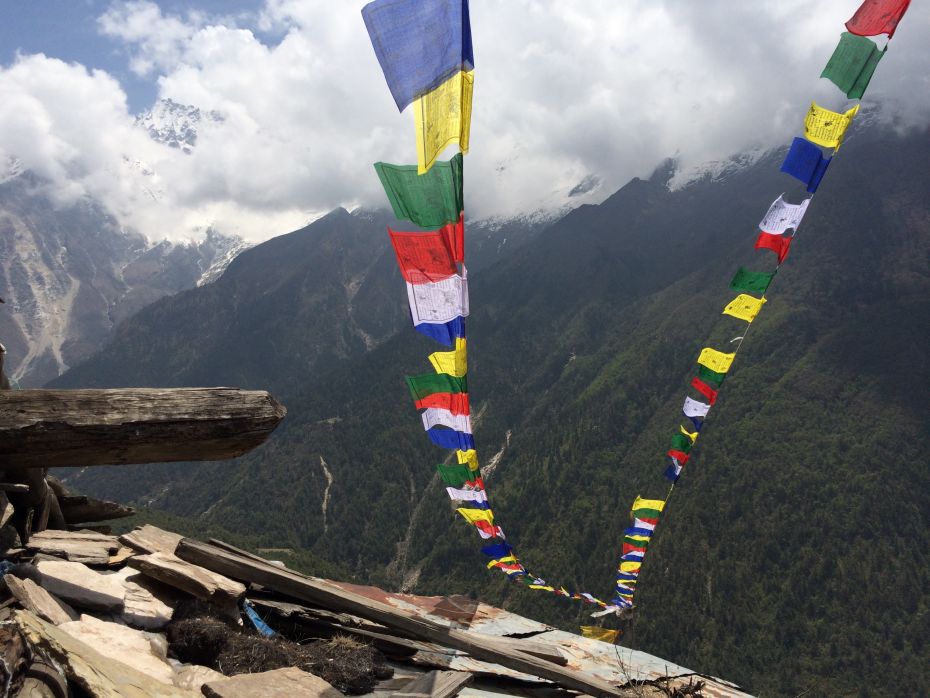
View from Geshe Lama Konchog’s retreat hut Gaden Gompa, Tsum, Nepal, May 2018. Photo by Tsum pilgrimage participant.
Thinking that was it, Geshe Tsundu was about to lead us back down for lunch and the return journey. But after this extraordinary experience, it was plain we were keen for more! In the end, it didn’t take much convincing for Geshe-la as well as Apey to lead us to the Hayagriva cave further along the mountain.
We took turns entering the small cave, where a tiny creek flowed, and an amazing self-emanating torma in a deep shade of red was clearly evident on the rocks. Wow! We had to spread ourselves out flat on the rocks in order to reach the torma and taste some of the holy water. What wonderful blessings!
We returned to Rachen with our hearts singing and bellies filled to the brim after a late lunch at dear Apey and Mochung’s house (again!). It was a merry reunion with everyone in the dining room that evening, as we all recounted the day.
Some had returned to the second Geshe Lama Konchog cave below Milarepa’s Cave of the Doves to spend several happy hours. Others trekked to a nearby village shop, to stock up on basic groceries for the nuns, before returning to cook up a feast for everyone. The fried rice tasted amazing!
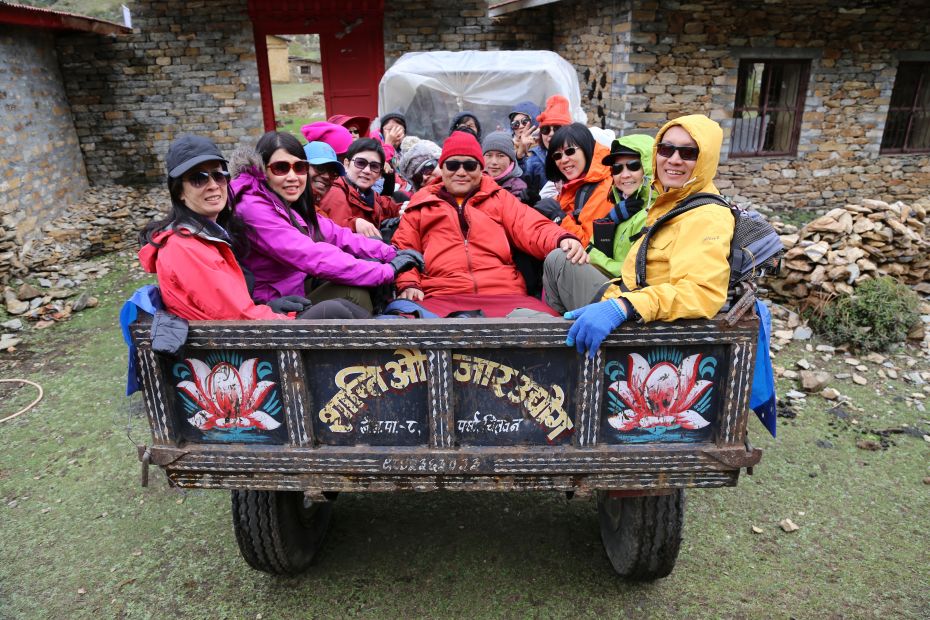
Tractor and trailer ride, Tsum, Nepal, May 2018. Photo by Tsum pilgrimage participant.
Which brings us to our second to last day in Tsum—the day of the tractor. It was a day none of us would ever forget.
Tractor? Yes, tractor. And us in a trailer, with no suspension, pulled by said tractor. Us, meaning approximately twenty not particularly tiny people. Why on earth? Because it was raining solidly from 3 a.m., and there was no way we were going to hike the 30 kilometers (19 miles) round-trip up to Mu Monastery and back in a single day, let alone in cold wet conditions. Nothing for it. As Gen Tenpa Choeden announced, “Die die also must go!”
This got me thinking that Mu Monastery, at an altitude of 3,700 meters (12,139 feet) and in the same direction as Tibet, must really be a fantastically special place.
Oh, the obstacles we encountered in trying to visit Mu! Already postponed twice, it almost looked like we would not be able to go at all—until this tractor and trailer combination (more glamorously referred to as the “Ferrari” by YK) came to our rescue.
In actual fact, “rescue” was the last thing that came to mind. As we banged and crashed through impossible terrain, including wild rivers complete with rocks and raging rapids, at times mere inches from steep ravine edges, it was quite a wonder that we didn’t get transported right into our next lives instead.
There we were—hollering and yowling, sometimes in fits of laughter and other times in sheer terror—squashed together like sardines and getting flung around like rag dolls. Such retrospective fun! Wonderful collective karma, right travel buddies?
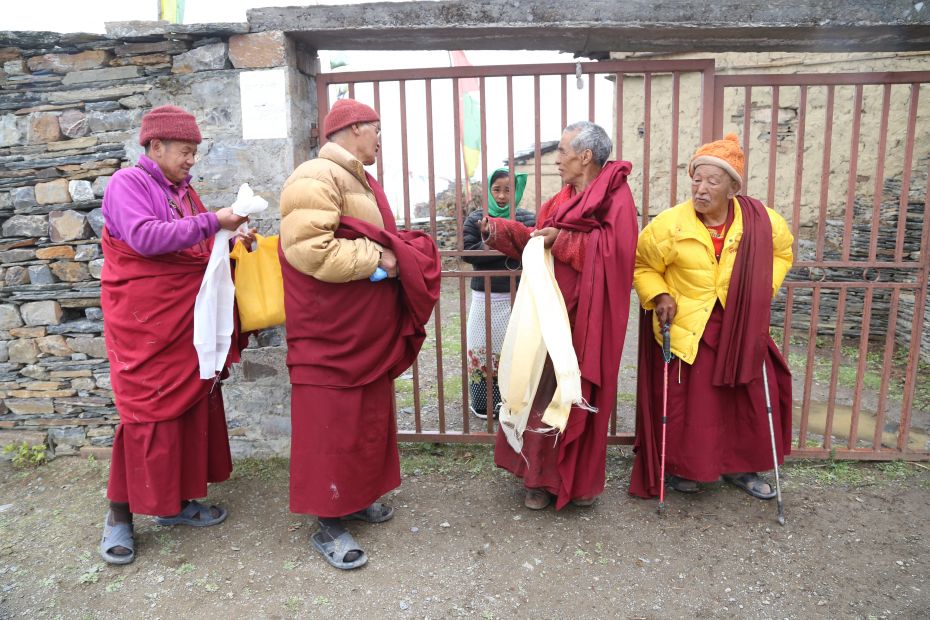
Mu Monastery monks awaiting the pilgrims’ arrival, Tsum, Nepal, May 2018. Photo by Tsum pilgrimage participant.
But it was so worth it. Mu Monastery was indeed special. Old and isolated, it was like nothing I had ever experienced. Under leaden skies, heavy mist, and enveloped by sharp cold air, I found myself floating in a dream-like world belonging to a different time.
The elderly resident monks were into their first day of the annual Saka Dawa nyung nä retreat in their dark and evocative gompa. We will forever be grateful to have been a small part of it all.
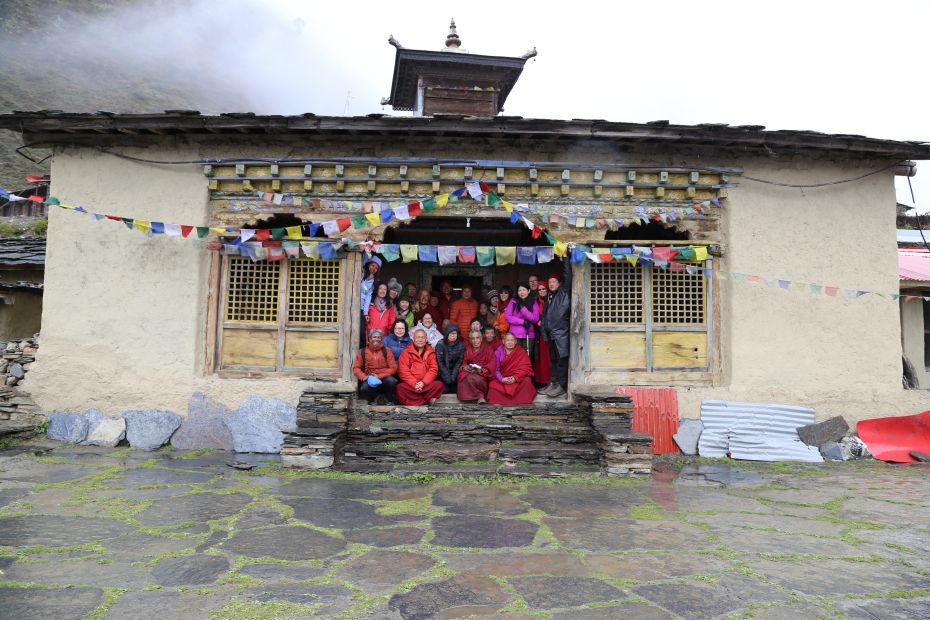
Mu Monastery gompa, Tsum, Nepal, May 2018. Photo by Tsum pilgrimage participant.
A fitting end to our stay at Tsum was joining the Rachen nuns on the second day of their own nyung nä retreat. As we evoked One-Thousand Arm Avalokiteshvara in this beautiful practice, I prayed for the holy Dharma to flourish in this and all worlds. May the lives of our gurus be long and healthy. May they return to teach us over and over again, until samsara is utterly emptied of all beings.
A big thank you to Gen Tenpa Choeden, Geshe Tsundu, Geshe Nyima, all the Sangha at Rachen Nunnery, Mu Monastery, Khachoe Ghakyil Ling Nunnery, Kopan Monastery, Tsum Project coordinator YK, and all my wonderful travel companions. And a special mention to Geshe Tenzin Zopa, original Tsum Project coordinator and former resident geshe at Losang Dragma Center, who was so instrumental behind the scenes in ensuring that this would be a trip for us to remember for the rest of our lives.
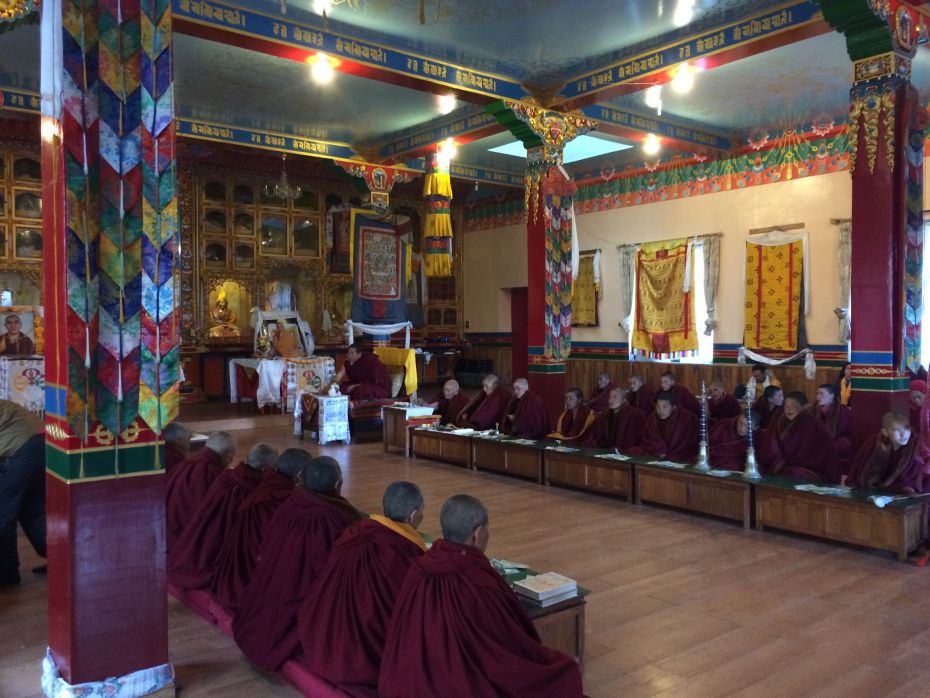
Rachen Nunnery’s new gompa, Tsum, Nepal, May 2018. Photo by Tsum pilgrimage participant.
Here’s to our next pilgrimage. And we’d better choose somewhere cold so that we can all wear the new Marmot gear we amassed upon our return to Kathmandu!
Read Lama Zopa Rinpoche’s advice for pilgrimage:
https://fpmt.org/wp-content/uploads/teachers/zopa/advice/Pilgrimage_Advice.pdf
- Tagged: geshe jampa tsundu, geshe lama konchog, in-depth stories, mu monastery, nepal, pilgrimage, rachen nunnery, selina foong, tsum, tsum project, tsum valley
30
MAITRI Charitable Trust: Service in the Land of Noble Truths
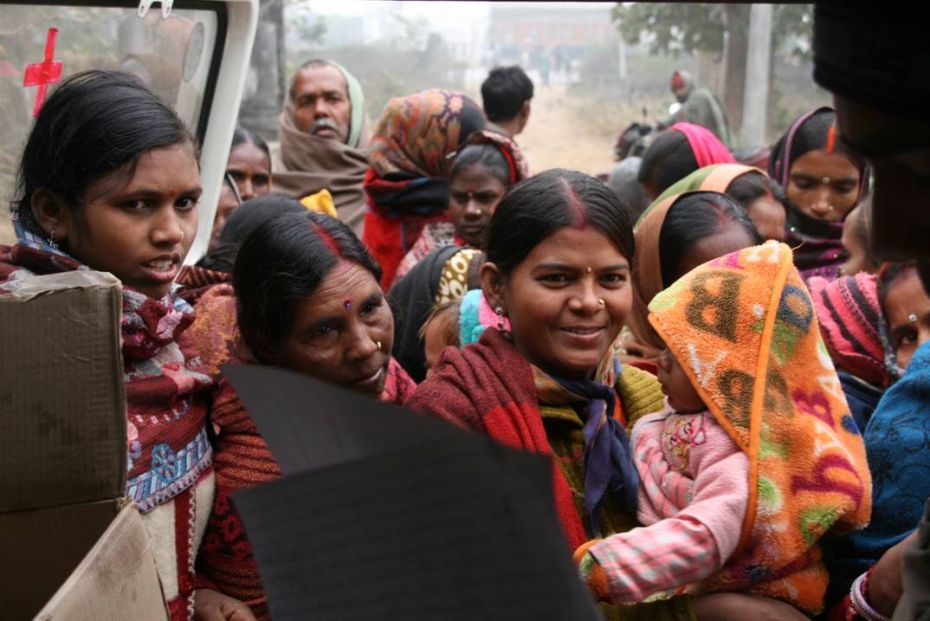
MAITRI paramedical staff member Arun disbursing supplements to pre and post-natal mothers during a Child Mobile Clinic, south of Bodhgaya, India, January 2018. Photo by Phil Hunt.
Phil Hunt, coordinator of FPMT probationary project Enlightenment for the Dear Animals, shares about his visit in early 2018 to FPMT project MAITRI Charitable Trust in Bodhgaya, India.
Heading out at dawn through the outskirts of Bodhgaya on one of MAITRI Charitable Trust’s regular Mother & Child mobile clinics, I could quietly witness the pollution and poverty all too apparent at the edges of towns and the main roads.
It’s not the romantic image one would like to have of the place where the Buddha walked and taught all those years ago. Bodhgaya is in Bihar, and Bihar has one of the highest incidences of leprosy, TB, and infant mortality, and one of the lowest literacy rates in India.
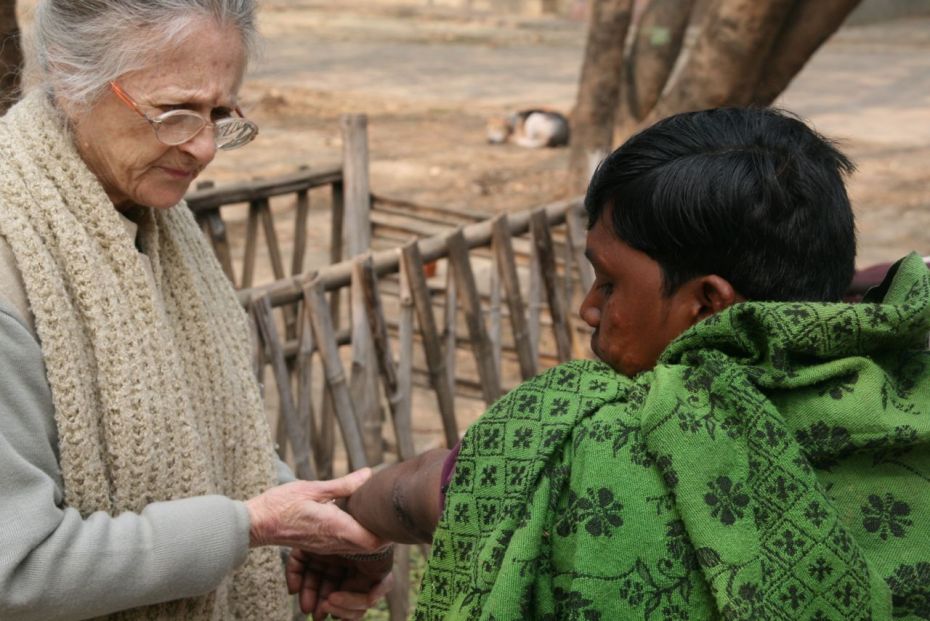
Adriana Ferranti reviewing a new leprosy case, MAITRI Charitable Trust, Bihar, India, January 2018. Photo by Phil Hunt.
The work that MAITRI does is not romantic either. Identifying people with leprosy, cleaning and dressing ulcers in flesh damaged due to localized deadening of the nerves, identifying people with tuberculosis (TB), collecting and analyzing sputum samples, assisting undernourished TB patients, or prenatal mothers, or newborn babies, and treating injured, maimed, and sick animals that have nowhere else to go.
On a foggy winter morning where the sun didn’t show up at all, the mobile clinic team headed away from the hubbub around Bodhgaya where His Holiness the Dalai Lama had arrived. Down the highway towards the Delhi-Kolkata Trunk Road. Past poverty and the grime you get when construction has arrived, incomplete, but with few of the benefits. The intersection with the Trunk Road is rubbish-filled, noisy, scattered with long-distance trucks and generally ugly.

MAITRI staff member testing a patient’s sputum sample for tuberculosis, MAITRI Charitable Trust, Bihar, India, January 2018. Photo by Phil Hunt.
His Holiness had come to teach on the Four Noble Truths. And we all know the first one is the Truth of Suffering. Here it is impossible to miss. His Holiness’ teachings were particularly responding to an Indian request, and he highlighted again and again how it is the Indian tradition that the Tibetans inherited and preserved, and that is now returning to its homeland. One of those traditions is cherishing others, based on critical analysis of its benefits.
Looking around Bodhgaya and surrounding districts at the poverty and ignorance, how could you possibly think you could make any impact? Yet these are the sentient beings Buddhists have pledged to bring to enlightenment, that Christians go to serve following the example of Jesus, that the left side of politics works to uplift, that the right side of politics promises to benefit through a ‘trickle down’ economy. They are the global neighbors with whom we have responsibility to share the riches of the world fairly. Indeed, these are the beings that might have been our direct neighbors if our karma had been very slightly different.

MAITRI staff reviewing an x-ray with the patient, MAITRI Charitable Trust, Bihar, India, January 2018. Photo by Phil Hunt.
Is trying to help simply a futile gesture? Some token feel-good exercise? It is easy to think this way. Yet we all know of how special it was to receive help when we needed it. Not a thousand other people, not five desperately needy, not a stranger over there. Us. You. Me. When someone had stopped to help us when we thought nobody would. That individual out of so many who happens to be feeling, thinking, wishing to be free of this particular suffering. To be helped, how wonderful! What relief!
Perhaps this is what pushes MAITRI staff to work so hard, understanding that some of these individuals can be helped and MAITRI can do it.
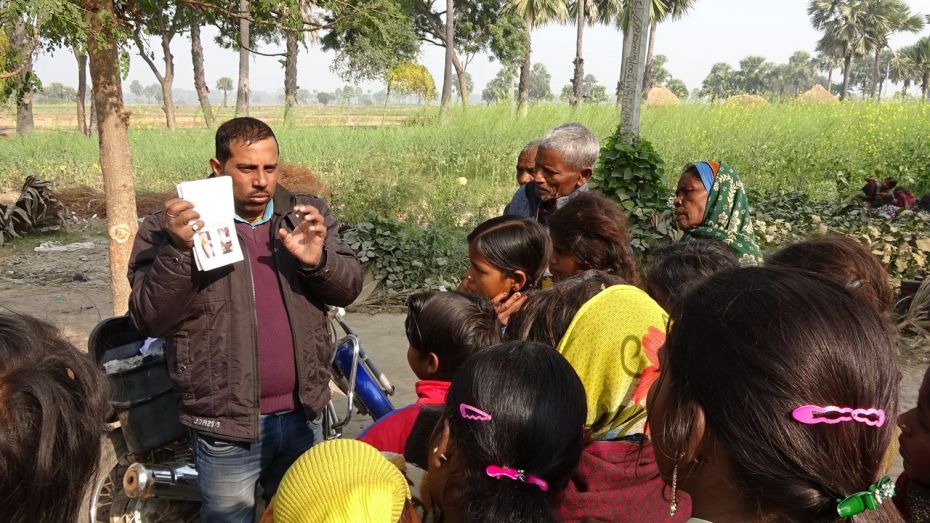
MAITRI staff conducting leprosy training in a village, Bihar, India, January 2018. Photo by Phil Hunt.
The 16 Guidelines for Life also come to mind when I see MAITRI workers in action.
Humility—the founding and ongoing recognition that only the government can possibly reach every citizen, therefore a charity that works in partnership with the government will be more effective to render assistance to those who fall through the cracks. MAITRI is the only organization authorized by the Government of Bihar to assist the District Leprosy Office in Gaya District.
Patience—not just with everything that Bihar throws at you, but also with those patients who are slow to understand the role they must play in their own healing.
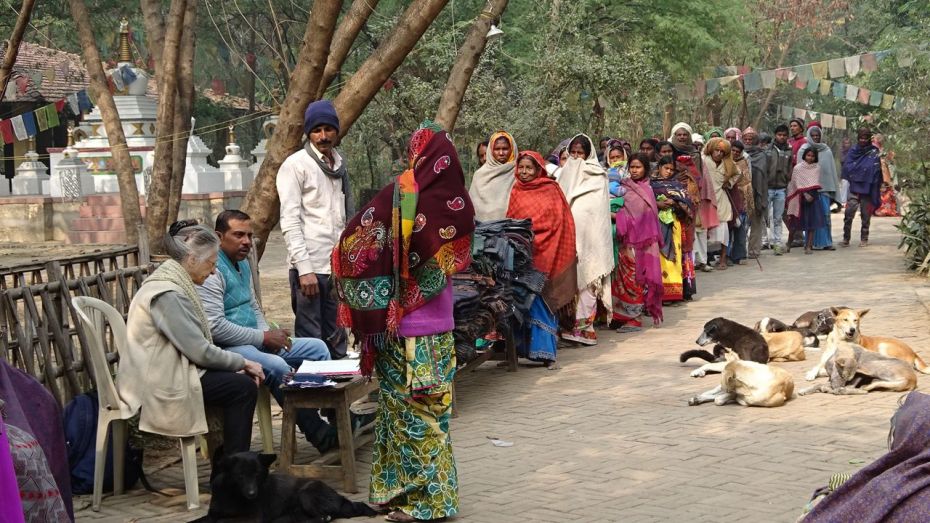
MAITRI staff distributing blankets to the poor, MAITRI Charitable Trust, Bihar, India, January 2018. Photo by Phil Hunt.
Contentment—perhaps it is more of an acceptance, but everyone’s ability to put up with the poorer equipment, the less than comfortable surroundings, the outbursts of barking from the rescued dogs, the overwhelming numbers of patients when it is supposed to be a regular clinic day.
Kindness—it is written through everything. The staff and in-patients mix regularly in formal situations (at check ups, dispensing medicines, ulcer dressing) as well as around the campus. Those hospitalized can spend weeks or months here slowly gaining the strength to return home and thus become part of the MAITRI family. Pre- and post-natal mothers who come for checks can be regular visitors over many years with different births.

MAITRI staff distributing tuberculosis medicine, MAITRI Charitable Trust, Bihar, India, January 2018. Photo by Phil Hunt.
Generosity—MAITRI not only gives outright (medicines, blankets, supplements for TB patients, sandals for leprosy patients, medical costs for reconstructive surgery, and so on) but also through encouraging reciprocal giving. The Village Schools program was set up to encourage the local community to invest in the education of its children by committing to building and maintaining the school buildings and ensuring boys AND girls attended. Those coming from a long way to receive help are given half their travel costs.
Respect—for those who are the lowest of the low. For those with leprosy, a disease that still attracts social stigma, or mothers with a newborn girl where the father is afraid of another dowry. For a wife with TB whose husband hadn’t given her permission to see a doctor. For a dog paralyzed in an accident who would not be looked after anywhere else.

MAITRI leprosy patients enjoying sweets during the MAITRI new year celebration, MAITRI Charitable Trust, Bihar, India, January 2018. Photo by Phil Hunt.
Loyalty and total commitment to those individuals that need help and who need it now. Many times I have seen staff work well past lunch, dinner, or knock off time to assist a person or animal needing help. They are also very loyal to their communities and the networks MAITRI has developed over the years. It is these networks that are vital in the TB drug distribution process. They also help in identifying potential cases, people who might otherwise miss out on treatment altogether.
MAITRI’s Director, Adriana Ferranti, had a series of clear goals at the beginning. Most of them have already been achieved, such as the campus buildings and the afforestation of the land. The Aspiration to complete the tasks and do more is always there, even though the money is always tight. “In the Service of others” was and is MAITRI’s modus operandi.
One cannot forget these two guidelines: Perseverance and Courage. No examples are required.

Belen the dog wearing a fresh bandage at MAITRI Charitable Trust, Bihar, India, January 2018. Photo by Phil Hunt.
Whenever I try to summarise what MAITRI does, it is invariably long-winded and somehow insufficient. How does it manage to help those who really don’t have the karma to be helped? Like that day when a new referral was found to be positive for TB. Imagine being that person who is now embraced by an organization that would move mountains to ensure you get the medical help that you need. So many don’t get noticed, don’t get checked, and don’t get helped through the long process to health. Not many people have the karma to save someone’s life. MAITRI does this week in week out, and has done so for nearly thirty years. Meanwhile Kyabje Thubten Zopa Rinpoche’s voice chants mantras and sutras over the loudspeaker system heard by all.
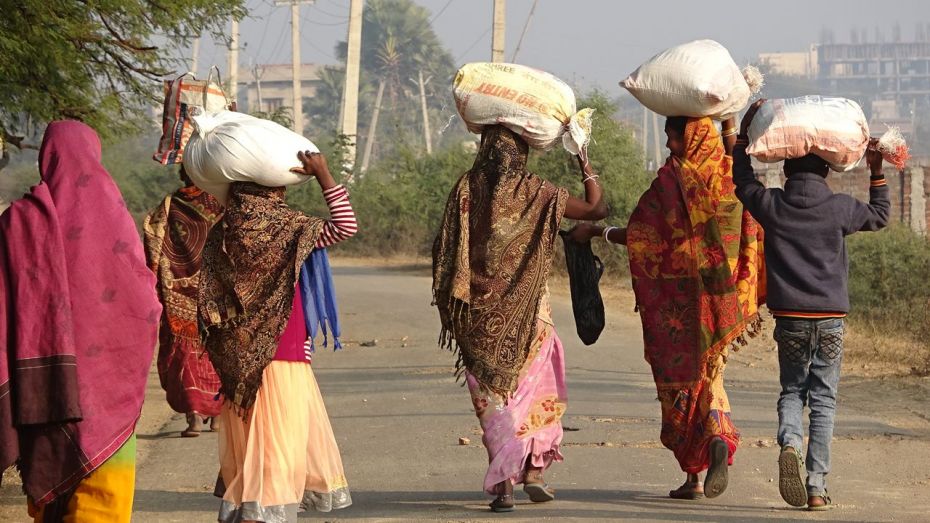
People carrying donated supplies home from MAITRI Charitable Trust, Bihar, India, January 2018. Photo by Phil Hunt.
Looking at MAITRI like this makes it sound like everything and everyone is working perfectly. This is samsara, and this is Bihar. The individuals being helped are very low in society’s pecking order. There is corruption throughout society, there is neglect and indifference. Services are poor, the climate is harsh, the environment suffers from the weight of humanity. MAITRI itself is hobbled by court cases fighting to recoup losses from some of these social ills. Its buildings need repair, there isn’t enough staff, and those who are here are prone to the usual failings. There is never enough time or money. There are always more sick, ill, or vulnerable. It is an impossible job. Yet here MAITRI still remains, in the service of others with compassion and care.
For more information about MAITRI Charitable Trust, visit their website:
http://www.maitri-bodhgaya.org/
For more information about the 16 Guidelines for a Happy Life, visit the website:
http://www.16guidelines.org/
17
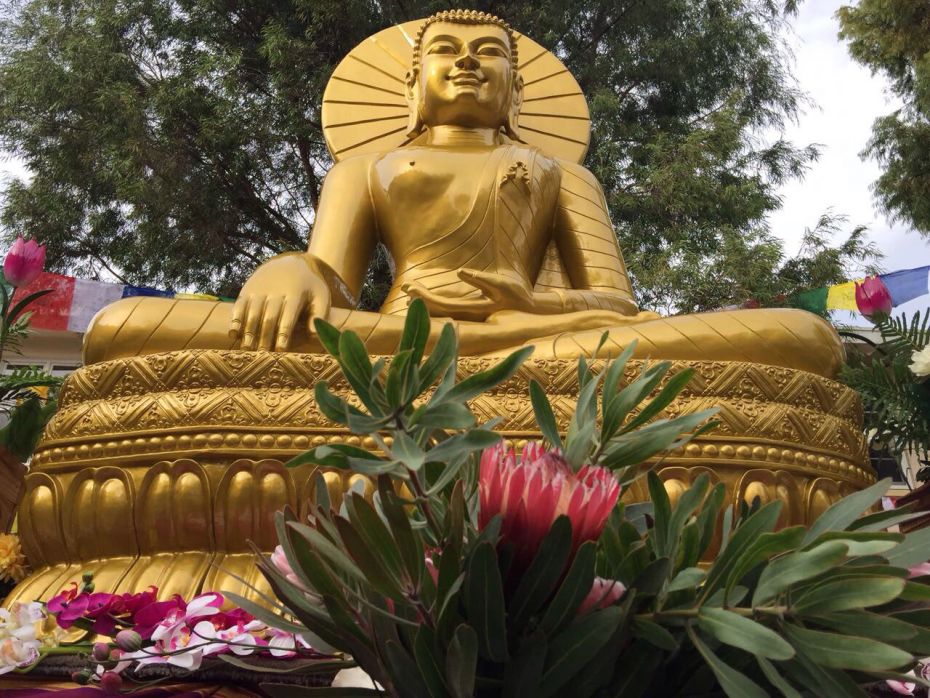
Buddha statue prior to offering gold-leaf at the Guru bumtsog, Hobart, Tasmania, June 2016. Photo courtesy of Stephanie Brennan.
In June 2017 FPMT in Australia (FPMTA) and Chag Tong Chen Tong Tibetan Buddhist Centre (CTCT) organized 100,000 tsog offerings to Guru Rinpoche, also known as a “Guru bumtsog.” Participants from all over Australia took part in the powerful and joyous multi-day event, which was blessed by a video address from Lama Zopa Rinpoche.
Here, Stephanie Brennan, FPMTA National Education/Tour Coordinator, shares a personal account of the Guru bumtsog, which took place during Saka Dawa in Hobart, Tasmania.
FPMT in Australia decided in December 2016 to organize a national 100,000 tsog offerings to Guru Rinpoche puja, inspired by the advice of FPMT spiritual director Lama Zopa Rinpoche. We wanted to connect strongly to Rinpoche and to offer the puja for the long lives of His Holiness the Dalai Lama and Rinpoche. We also wished to dedicate the puja for world peace.
This was the first time that this event would be offered in our region. Chag Tong Chen Tong Tibetan Buddhist Centre in Hobart generously co-hosted the event. Tasmania, with its pure air, World Heritage wildernesses, and mountains, and Hobart, with its award-winning restaurants, organic produce, and heritage areas, are very popular tourist destinations.
Hobart hosts an active community of artists and designers who are inspired by Tasmania’s natural environment, and Kickstart Arts, an organization dedicated to community art, partnered with FPMTA and CTCT to serve as the event venue.
A large geodesic white dome was erected in the garden next to where CTCT’s three-meters [ten-feet] high golden Shakyamuni Buddha statue was placed. The golden Buddha formed the focus of the event—a place where we offered silken robes, gold-leaf, and incense. Every evening as darkness fell, we circumambulated while chanting and made the sur offering around a fierce fire. Early each morning, we started by offering tea lights to the large stupa set up in the middle of the dome, the flickering flames lighting our faces in the shadows before the sun rose.
Inside the venue, the gompa was resplendent—luminous with Kickstart’s theatrical lighting, which shone on the rich brocades, thangkas, silk buntings, khatas, and holy images that covered the walls and ceiling, and illuminated tables of beautiful tsog offerings and long lines of water bowl, light, incense, food, and flower offerings.
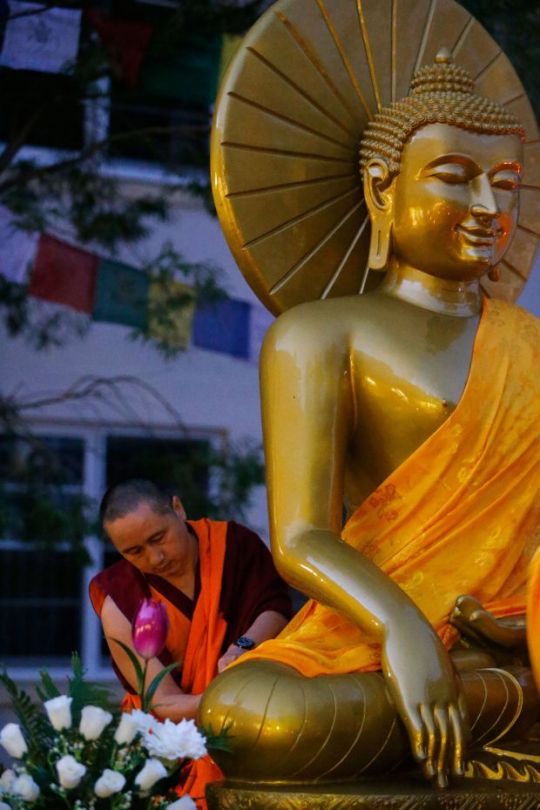
Offering robes to the Buddha statue during the Guru bumtsog, Hobart, Tasmania, June 2016. Photo courtesy of FPMT Stephanie Brennan.
At the front of the room was a high throne covered in beautiful brocades, holding images of His Holiness and Lama Zopa Rinpoche. There were beautiful crystal bowls overflowing with gold-covered chocolates and mandala offerings on silken cushions. The stage was filled with exquisite tsog—wrapped in brilliant ribbons and coverings—and abundant with Guru Rinpoche incense from Kopan Monastery, crystals, gold-leafed tsatsas, and beautiful objects. Vase upon vase of colorful flowers were lined up in front.
Internationally renowned artist Martin Walker had installed an exhibition of gilded repousse holy images at the venue called Sacred Art for Global Peace. Kickstart Arts’s exhibition room was filled with his wondrous gilded Tibetan Buddhist deities mounted on rich brocades. The image of Prajnaparamita, the Perfection of Transcendent Wisdom, gleamed with fine gold-leaf, as well as green, yellow, white, and red gold-leaf. Her robes were trimmed with purple-leaf (a resin-coated silver-leaf) and also with palladium-leaf; her crown was mounted with Swarovski crystals. A palpable sense of presence emanated from the exhibition room.
We started the puja on Saka Dawa evening, Friday, June 9. More than 160 people, including families with children, crammed into the gompa to listen to special guests—such as the Speaker of the Tasmanian Parliament, the Honorable Elise Archer, and Dr. Sonam Thakchoe, a Tibetan representative and scholar—open the puja. We commenced by acknowledging the traditional owners of the land, the Mouheneenner people, and all Aboriginal elders past, present, and future. The Hon. Elise Archer made the first offering of the puja, presenting a delicate gold and white posy of flowers to the throne.
After chai and cake were served, the first puja session began. With eighteen Sangha present from all over Australia, the gompa was filled with maroon and saffron robes. Sitting in front were two geshes—Geshe Tenzin Zopa, who led the puja, and Geshe Phuntsok Tsultrim, the resident geshe at Chenrezig Institute, Queensland. Also in front was Lama Jimay from Tasmania, who ably assisted with the hook drum.
In the first session, we started by chanting the full verses of the “Prayer to Guru Rinpoche That Spontaneously Fulfills All Wishes” to a poignant and melodic tune. This was followed by the tsog offering prayer and Guru Rinpoche mantra, which were repeated many times. These repetitions were accompanied by cymbals and drums with a very stirring beat. As the pace of these repetitions was fast, it took a little while for everyone to get their head around the Tibetan syllables, but soon everyone settled into a kind of rhythm, with Geshe Tenzin Zopa’s clear voice leading us forward.
Sangha members played the ritual instruments, and the gompa became warm and energized. As I looked at the large thangka of Guru Rinpoche above the tsog offerings, it felt to me that evoking the spirit of Guru Rinpoche and knowing that this puja had been blessed by Lama Zopa Rinpoche beforehand, particularly to clear obstacles, made everything in the gompa seem timeless, vivid, and very clear.
It had taken over six months of preparation to realize the Guru bumtsog. Students, directors, previous directors, spiritual program coordinators, and Sangha from most of Australia’s twenty or so centers, projects, and services attended the event. CTCT had conjured a large team of volunteers to host the many Sangha, prepare the delicious food, look after people, work in the shop, help erect the dome, and install the three-meter golden Buddha statue. We were helped by volunteers from other centers such as Buddha House’s director and spiritual program coordinator, who came early from Adelaide to help wrap the tsog.
There were parking attendant helpers, who braved the cold, 5:30-a.m. air, and an usher team, who were suddenly swamped by more than 160 enthusiastic participants—only eighty people pre-registered, but our panic quickly turned to “Welcome! Here is your goody bag” joy. (And there were gold-leaf tsatsa makers in the months leading up to the event!) Co-organizer Ven. Lindy Mailhot, director of CTCT, and FPMT in Australia wanted everyone to feel welcomed, cared for, and nourished by the puja as well as the food, no matter what obstacles arose. But more than anything, we wished to please the mind of our precious guru.
Geshe Tenzin Zopa led the gompa set-up team in the week before the event, directing with precision, while tirelessly climbing ladders, putting up silk bunting, and hanging holy images, khatas, and thangkas, as well as working with Dan Mailhot (nicknamed the “Golden Buddha Man” for his work in gilding the Buddha) to transport, welcome, and decorate the golden Buddha statue in the garden.
Because the puja was also dedicated to world peace in a time when so much war, terror, famine, and suffering are apparent, this event captured the imagination of those at Kickstart Arts and the Hobart community, as well as participants and sponsors. The Israeli FPMT group who sponsored tsog made their dedication to the overcoming of the Israeli-Palestinian conflict. They sent a web link to a moving meeting between Israelis and Palestinians whose families had been killed in the conflict and yet who wished only for peace.
At the food tables and tents in the garden hung with prayer flags, in the gompa, and in the sacred art exhibition, an atmosphere of togetherness and warmth encircled everyone. We started at 6 a.m. on Saturday and Sunday, June 10-11, with light offerings and chanting OM MANI PADME HUM, slowly circumambulating the golden Buddha statue to enter the white dome, the Sangha going first, holding their warm zens around themselves in the cold winter morning.
We also offered gold-leaf to the golden Buddha statue, with the two geshes and Sangha leading us all out to the garden. Artist Martin Walker assisted participants, including many children, with offering gold-leaf to the Buddha’s feet. Sponsors waited in line for two hours for their chance to offer gold-leaf to the huge, beaming, golden Buddha.
As registrar for the event, I received emails from the many sponsors, and in the week leading up to the puja, sponsorships quadrupled. By Saka Dawa, I was seriously overwhelmed, with sponsorships arriving from all over the world—India, Malaysia, Israel, Singapore, Hong Kong, New Zealand. The dedications were beautiful, sometimes heart-wrenching, with a clear abiding love of His Holiness and Lama Zopa Rinpoche. To achieve world peace and inner peace was a constant theme.
Suddenly we received incredible news: Lama Zopa Rinpoche had recorded a video, personally addressing puja participants, and Ven. Holly Ansett was sending it through. Ven. Lindy and I broke down. To hear that Rinpoche had done this for us in Australia, knowing how unbelievably busy he is—words could not describe the feelings of being cared for by him, of the deep connection being made between all of us involved with the puja and the person most precious in our lives, Lama Zopa Rinpoche. It made us weep.
We held five puja sessions per day of Guru Rinpoche prayers. Ven. Lindy and I sat behind our chant leader, Geshe Tenzin Zopa, and were subsumed by the waves of the Guru Rinpoche mantra and tsog prayers reverberating in the gompa and the swift rhythm of the cymbals and drums, which created a trance-like beat. Even with my eyes closed, I could see the details of Guru Rinpoche’s image—present in the gompa through the large thangka and also the exquisite Bertrand Cayla painting on the front of the prayer books we had printed.
Even with a failing voice, Geshe Tenzin Zopa continued to lead us as we entered the world of Guru Rinpoche. Sangha swayed, many with eyes closed; students called out the fast-beating prayers; and the cymbals and drums rattled and shook the gompa. Inside was warmth and light, radiant light. An intense white brightness emanated from the front of the gompa, the silken tsog ribbons and faces of the delicately painted thangka images glittered and shone beneath it. It was hard not to feel a strong presence.
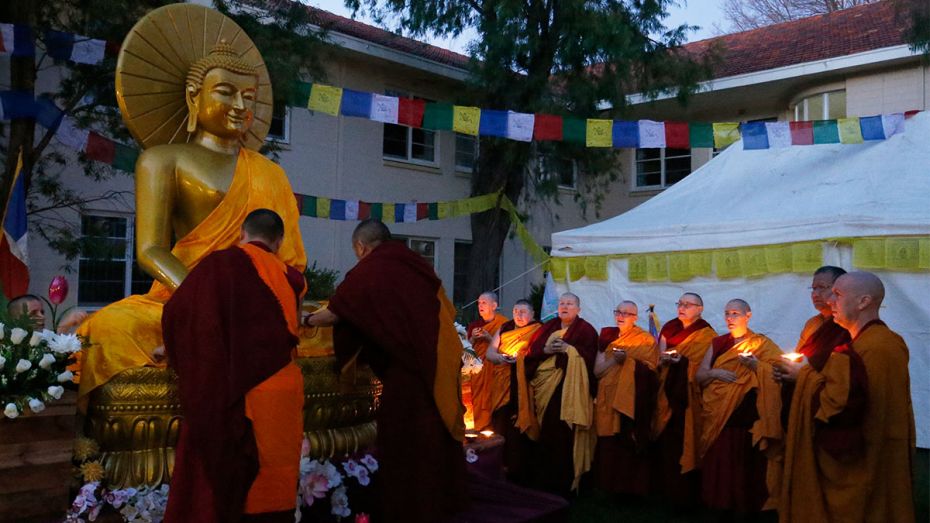
Early morning light offerings during the Guru bumtsog, Hobart, Tasmania, June 2016. Photo courtesy of FPMT Stephanie Brennan.
As we entered our breaks, we came out into a different world, a present and conventionally real world of lunch: warm delicious food and cool wind on our cheeks that made the prayer flags flutter. After lunch, we darkened the gompa to play Lama Zopa Rinpoche’s two videos on a huge screen. The first ten-minute video thanked everyone there for coming to Tasmania to do the Guru bumtsog. Rinpoche, in his characteristic style gave “100,000 thanks” to all of us for coming and for those sponsoring the event and spoke of the incredible good it was doing. He thanked all the geshes. He went into detail of how he remembered Ven. Lindy’s mother making him a head warmer. (That was over thirty-five years ago!)
In the next video, Rinpoche gave a wonderful teaching about Guru Rinpoche and how he arrived in Tibet—his journey there as well as his power in clearing obstacles. It was as if Rinpoche was in the gompa with us, and in fact he was. His spirit and intention was. Rinpoche was with us for the Guru bumtsog, and there was no doubt, listening to these teachings made specifically for us, that what we were doing was of enormous benefit.
Practitioners and volunteers worked beyond their tiredness until the final session. As Geshe Zopa led us in the final prayers and extensive dedications, there was a quiet power that seemed to hum in between the words of the prayers. The gompa was full of faces that were calm and happy, swaying with shining eyes.
FPMT in Australia and CTCT gave out many presents of thanks to the myriad volunteers and hosts who contributed so much. Greatest thanks were reserved for Geshe Tenzin Zopa, who advised and supported Ven. Lindy and myself in all aspects of the event, selflessly giving his time. At the time of thanking him publicly, words choked in my throat; words were not enough.
At the end of the event, students embraced one another, many in tears, as this had been an event where big things had happened internally and also in some other world—of this we somehow felt sure. Guru Rinpoche would help overcome the obstacles at the FPMT centers and in our personal lives—this was Rinpoche’s advice.
This Guru bumtsog was unlike any other puja I had attended. I struggled to find the words to express the power I had connected to. I just kept seeing Guru Rinpoche’s face and robes so clearly in my mind and hearing the sound of his swishing silk and musical instruments. Ven. Lindy and many others reported similar experiences during and after the event.
There was a great love that we had connected to through Lama Zopa Rinpoche and Guru Rinpoche. It manifested in the feelings at the end of the puja in that lit hall where all spontaneously embraced each other and cried. We felt enfolded in the arms of the FPMT family, and we had our hearts opened by our spiritual father, Lama Zopa Rinpoche.
Visit FPMT Australia National Office website for more information on the Guru bumtsog event.
- Tagged: chag-tong chen-tong, fpmta, guru bumtsog, guru rinpoche, in-depth stories, padmasambhava, saka dawa, stephanie brennan
12
Personalizing the Twelve Links of Dependent Origination
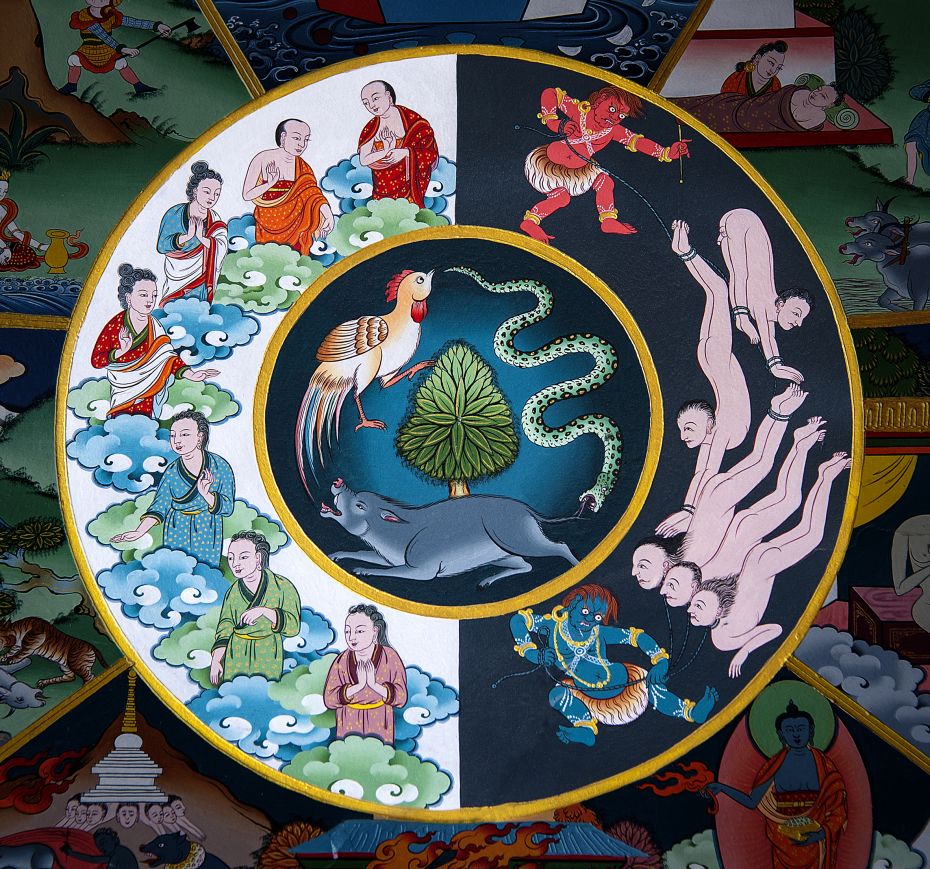
Hub portion of Wheel of Life, Khachoe Ghakyil Ling, Kathmandu, Nepal. Photo by Piero Sirianni.
By Ven. Tenzin Gache
His Holiness the Dalai Lama often comments that as Buddhists, our distinctive practice is non-violence, and our distinctive view is dependent origination. His Holiness’s comments echo a common strand in the Buddhist tradition: Lama Tsongkhapa claimed that there was no teaching of the Buddha more profound than dependent origination, and Nagarjuna began most of his works by praising the “one who taught dependent origination.” The Buddha himself recounted that on the night of his enlightenment, he awoke to the profound nature of the twelve links of dependent origination, clearly seeing how beings trap themselves in an endless cycle of self-perpetuating confusion and misery.1 The Buddha went on to claim that nobody could understand his teaching without understanding the nature of these twelve links.2
Yet for many Dharma practitioners, these twelve links remain an elusive subject, something difficult to penetrate and even more difficult to relate to one’s personal experience and daily practice. Until several years ago, I was also apt to relegate this topic to the “too hard” pile. But after extensive study and debate with my classmates, and helpful elucidation of difficult points through discussions with Gen Losang Gyatso (“LoGyam”)—a senior monk in my house group, Lhopa Khangtsen,3 at Sera Je Monastic University in South India—I took the subject into retreat for personal contemplation. Although only able to generate some very limited, beginner level insights, I did manage to glimpse how profoundly relevant the twelve links of dependent origination must be for our own psychological situation. I will attempt to share some of my meager understanding in the hope that others will take an interest in studying and contemplating this important but dense subject.
Generally speaking, Buddhist texts that speak of “dependent origination” mean one of three distinct things: 1) dependence upon causes and conditions, 2) dependence on parts, and 3) dependence on a labeling consciousness. The second connotation is central to the philosophy of the Svatantrika-Madhyamaka School, and the third is unique to the Prasangika-Madhyamaka School. Thus, the “distinctively Buddhist” view—the one shared by all Buddhists historically and worldwide—is related to the first connotation, dependence on causes and conditions. This kind of dependence again has two divisions: a) outer cause and effect, and b) inner cause and effect. Outer cause and effect—the arising of smoke from fire, sprouts from seeds—is certainly not a unique Buddhist tenet, so it is inner cause and effect that is so central to Buddhism. Inner cause and effect, or psychological/karmic cause and effect, is the manner in which our present thoughts and actions create our future experience—that is, the twelve links of dependent origination.
This unique Buddhist view avoids the two extremes of 1) believing that some external force, such as a creator god, determines our experiences of happiness and suffering, or 2) believing that human joys and miseries have no deeper meaning, being the mere byproducts of the aggregation and interaction of particles, whose behavior is governed by outer cause and effect. Buddhism breaks away from most modern philosophies in asserting that these outer causes—the matter that interacts with but does not create our minds—are conditions for our experiences of pleasure and pain, but that the root cause lies deeper. All of us wish to have happiness and avoid suffering, and in many cases we have a sincere wish to free others from suffering as well. But as long as we remain ignorant of the true causes of suffering, even the most well-intentioned strokes to eliminate it can have only a limited effect.
What, then, is the cause of suffering? Anyone familiar with the Buddha’s first teaching on the four noble truths will recall that the Buddha insisted that delusions, karmic actions, and craving are the true origin of suffering. But how, exactly, do these three factors create suffering? The clarification of this subtle causal process is the subject of the teaching on the twelve links, a teaching that is simply an expansion of the first two noble truths.
The primary source for Mahayana teachings on the twelve links is the Salistamba, or Rice Seedlings Sutra [translation by author]:
Venerable Bhikshus, whoever sees dependent and relative origination, sees the Dharma.
Whoever sees the Dharma, sees the Buddha.4
What is this dependent and relative origination of which I speak?
It is this: because this exists, that arises. Because this is born, that is born.
It is like this: through the condition of ignorance, compounding factors. From the condition of compounding factors, consciousness … name and form … the six sense spheres … contact … feeling … craving … grasping … existence … birth … aging and death. From the condition of aging and death, agony, wailing, suffering, unhappiness, and mental disturbance all arise. Like that, merely this enormous heap of suffering arises.
The manner in which the twelve links function and interact is not clear in sutras such as the one quoted above, and so different interpretations have arisen over the course of Buddhist history. Some interpret the links as unfolding in a single instant, while others see them as representing stages of life. While I think all of these interpretations are beneficial for contemplation, for the sake of simplicity, I will follow the Gelug interpretation, formulated by Tsongkhapa in texts such as The Golden Garland, Lamrim Chenmo, and Ocean of Reasoning, based primarily upon Asanga’s exposition in Compendium of Manifest Knowledge and to a lesser extent on Vasubandhu’s Explanation of the Sutra on Dependent Relativity. Tsongkhapa’s heart disciple Gyaltsab Je further clarified Asanga’s presentation in his commentary on Compendium. As a Sera Je monk, I will of course rely in part on Jetsun Chökyi Gyaltsen’s textbooks.5
According to Asanga, the progression of the first to the twelfth link, as described in the sutra above, is meant to give a general picture of cause and effect (I will explain how later on), but does not actually illustrate how the process unfolds for a particular action creating a particular result. Instead, a complete cycle of the twelve links unfolds as follows:
Ignorance (1) leads to compounding factors (strong karmic actions) (2), which make an imprint on consciousness (3). Then, craving (8) and grasping (9) ripen that imprint, which then resurfaces in conscious awareness at the time of death as existence (10). The substantial continuum of that mind becomes the first moment of the next rebirth, which is both name and form (4) and birth (11)—these two are simultaneous. From the second moment of that new birth, aging and death (12) begin. During subsequent stages of fetal development, six sense-spheres (5), contact (6), and feeling arise (7), consecutively, and aging and death continue.
Thus, (1), (2), (3), (8), (9), and (10) are the causes, and (4), (5), (6), (7), (11), and (12) are the results. Specifically, (1), (2), and (3) are the impelling causes that leave an imprint on the mind, and (8), (9), and (10) are the actualizing causes that ripen that imprint and lead to a new suffering rebirth. Although this process can appear confusing at first, through habituation we can start to see the logic involved. Also, the non-linear progression highlights that these are twelve links of interdependent origination: although it is possible to trace a particular pattern of cause and effect, all the links should be understood to be mutually reinforcing and interpenetrating. Ignorance causes karmic action, but the imprints of karmic action lead to more ignorance. In a single progression, craving leads eventually to feeling, but feeling itself becomes the main cause for more craving in the future (more on that later). The conceptual structure gives us a microscope to pick out patterns in our own psychology and make sense of what often can seem to be a chaotic, non-linear process.
All twelve of these links are instances of samsara, which is no more than our own body and mind, and the uncontrolled cycles these go through in this life and future lives. Samsara is not a place we cycle through, but the cycle of moving through these twelve links. As the great Indian scholar Kamalashila explained in his Commentary to the Rice Seedling Sutra, “For those confused regarding the process of entering into and reversing samsara, and so that they may be free … the Buddha explained dependent origination.”6 Keeping in mind the general order laid out above, let us now look in more detail at each of the twelve links.
Stage I: Impelling Causes (Links 1, 2, and 3)
1. Ignorance
Generally, any mind that is confused in regards to the object it apprehends is accompanied by the mental factor of “ignorance.” For example, when we see double, the eye consciousness is mixed with ignorance, and when we wrongly believe that somebody’s friendly advice was meant as a criticism, ignorance is involved. Buddhist practice ultimately seeks to free us of all manifestations of ignorance, but with limited time and energy, we need to identify the most important ignorance that is leading us repeatedly to cause suffering to ourselves and others. Even regarding this “first-stage ignorance,” different Buddhist scholars identify it slightly differently: for Asanga, it is like the darkness that leads to misperception, thereby not being a wrong apprehension but rather a lack of apprehension. Dharmakirti insists instead that it is a very specific wrong apprehension, namely the view that there is a substantial, self-sufficient “me” that exists over and above the aggregates of body and mind, similar to there being some kind of substantial entity called “New York” that exists over and above the buildings and people. Chandrakirti adds that it is not only this view of self, but the view of all phenomena possessing some intrinsic, findable nature in this way. The Theravada tradition takes a practical approach, identifying “first-stage ignorance” as misapprehension of the four noble truths: any view of reality that does not recognize craving as the cause of suffering will lead to actions that perpetuate suffering.7 How can we make sense of these various presentations?
Although these authors choose to focus on one particular cause, all of them would agree that all of these causes are involved. We cannot isolate one mistake and toss it out; we have to recognize a vast and deeply entrenched network of misapprehensions that entangles our minds. When a government is riddled with corruption, the result will be ineffective governance and harmful foreign policies. But a campaign to end corruption cannot just fire one person and be done with it. We have to identify and meditate upon all the ways we misrepresent reality: we expect youthful bodies to stay fit and healthy forever, see toxic substances and relationships as sources of stable happiness, and relate to the environment that sustains us as a stockpile for consumption.
2. Compounding Factors (Strong Karmic Action)
Misconceptions naturally lead to poorly planned actions. Every action we do under the power of ignorance is a karmic formation, but some are naturally stronger than others. Those with enough force to impel a new rebirth are called impelling karmas, and that term is synonymous with compounding factors, the second link. Pabongka Rinpoche explains in Liberation in the Palm of Your Hand that these are usually actions of body and speech—mere mental intentions rarely have the same level of force, though in certain cases they can.8 A good example of a negative karmic formation is killing somebody under the power of anger. A positive one would be taking a vow to refrain from killing. Until we directly perceive emptiness in meditative absorption, even our most positive actions will to some extent be tainted by wrong conceptions about the self, and thus will lead to rebirth in samsara, albeit a positive one. Each single action is a single impelling karma—two actions do not combine to create one life, though a second action may condition particulars about that life. I asked Gen LoGyam how this provision would work in regard to taking monastic vows—after all, isn’t this something that I perform over time, rather than just a “single action”? He explained that every time a practitioner remembers his or her intention not to harm others or follow attachment, that aspiration is itself a strong imprint that could impel an entire lifetime—so we may create many such imprints each day. Because the intention is to refrain from bodily harm, it becomes an action of body, thus according with Pabongka Rinpoche’s qualification.
The Tibetan word for “impel”—“phen”—can also mean “to throw” or “to shoot” an arrow. Asanga explains that each karma we create is like shooting an arrow straight up into the air. At some point in the future, it will strike down upon the bowman. Remembering that we have countless arrows hovering in the sky in wait for an opportunity to dive is a strong impetus to work out our past karma and limit its further creation.
3. Consciousness
Many years ago when I first read about the twelve links, I was confused as to how consciousness could be the result of karmic formation and ignorance. Is Buddhism claiming that there is no consciousness before that time? Isn’t ignorance itself a kind of consciousness? What I didn’t understand is that “consciousness” here does not refer to consciousness in a general sense, which itself is primordial, existing without beginning, just like matter and space. Rather “consciousness” refers here to a particular instance of consciousness that carries the imprints of karmic actions. Specifically, it is the substantial continuation of the very consciousness that created a karmic action. Gen LoGyam explained, “Imagine if you became furiously angry and killed another person. After completing the action, that anger and aggression would still be manifest in your system. That moment is the third link. After some time—maybe a few minutes or hours, maybe even a day—that energy would calm down, but would not disappear. Instead, it would become dormant in the recesses of your mind as you move on to other thoughts and activities. You may even forget about it, but it would not disappear.”
To understand the concept of “dormant mind,” think of some skill you have developed, perhaps driving a car. Although the knowledge of how to drive a car is strongly imprinted in your mind, you don’t have to consciously think about it twenty-four hours a day. But even if you don’t drive for ten years, when you again sit behind the wheel, that knowledge will become manifest again with little conscious effort. According to Buddhist philosophy, we have many—practically infinite—dormant mental states that reside in a non-manifest manner below our conscious awareness, and wait for a suitable trigger to cycle back up to the surface. Actions done with strong emotion and/or habituation leave strong imprints. These imprints wait for suitable conditions to ripen them and then impinge on our experience.
Stage II: Actualizing Causes (Links 8, 9, and 10)
8. Craving
Although ignorance is the root of cyclic existence, craving is the strong and direct cause that fuels the process. We all want to be happy and avoid suffering, and craving is the natural expression of that dual wish. Twenty-four hours a day—even in dreams—a continuous stream of thoughts and feelings bubbles into our consciousness. These thoughts and feelings fall into link 7, as I will discuss later. The process is normally too subtle for us to recognize, but the thoughts and feelings that arise are imprints of past thoughts and feelings, lying dormant in the mind through the process outlined above in links 2 and 3. Failing to recognize these experiences as being the manifestation of our own mind, we imagine the causes to be present in our immediate circumstances, when in actuality these circumstances are only the trigger for a deeper inner process. At a preconscious level, we constantly engage in habitual thinking that projects qualities onto external objects, labeling them as the cause of happiness or the cause of suffering. We then wish to obtain or hold onto those objects that seem to cause pleasure and separate from or destroy those that seem to cause pain. As such, it is not wanting pleasure and wanting to avoid pain that is in itself the problem, but rather the wrong thoughts that exaggerate the qualities of objects. However, manipulated by ignorance in this way, desire becomes a misguided force, and takes us for ride after ride.
While feeling (7) is like an itch that we can’t even identify, much less scratch, craving is the constant thought that responds to that feeling, thinking, “I’d like to have this, go there, do that.” Not realizing that we are trying to escape a feeling in our own mind, we compulsively engage in new actions, expecting the outer experience to satisfy us. But by the time we get where we intend to go, we have already moved on to thinking about something else, and fail to recognize that the original itch did not disappear but has merely been replaced by another “itch,” the imprint of another past action.
Craving is of three kinds:
1) Craving for pleasure. This is a response to a pleasant sensation, wishing to repeat or prolong that sensation. For example, we may recall eating a particular flavor of ice cream and wish to repeat that experience.
2) Craving for annihilation. This is not a suicidal thought, but rather a thought that responds to a suffering sensation by wishing to avoid it or destroy it. We may recall a bad experience and try to distract ourselves in something enjoyable.
3) Craving for existence. This is a response to the neutral, peaceful sensation of deep meditative concentration, wishing to abide in that sensation perpetually. Gyalwa Gendun Drup, the First Dalai Lama, explains that this is called “craving for existence” in order to dispel the view that the higher realms of meditative absorption are true liberation—they are still within samsaric existence.9
Like scratching an itch, all of these responses only serve to intensify the inner feeling and strengthen the force of past imprints, leading us to engage again in strong karmic actions (2) and thereby thicken ignorance. Tsongkhapa explains in the Lamrim Chenmo that without ignorance, there would be no craving response even if feeling (7) did arise.10 Again we can see how links 1 and 8 mutually reinforce one another.
When feelings arise, the best response would be to carefully observe the nature of the mind and how it responds to those feelings. Habituation to craving makes that simple response extremely difficult, and without realizing, we engage in one action after another, a pattern that will naturally continue at death if we do not retrain the mind.
The First Dalai Lama provides a strong warning about the dangers of craving:
It sweeps us into the torrent of existence, so difficult to cross
And spurred on by violent karmic winds
It churns with the great waves of birth, old age, sickness, and death.
Save me from the terrifying river of desire!
9. Grasping
The ninth link is merely an intensification of the eighth link, craving, at the time of death. When it becomes apparent that the things that we relied on to support our sense of self—family and friends, wealth and possessions, even our body—will no longer support us, we are left with the feelings with which we have struggled for so long. If our habitual reaction has been to cling to pleasurable feelings and try to avoid uncomfortable ones, that reaction will naturally continue here.
Left with only the inner feeling, this intensified craving response will trigger the ripening of a dormant experience.
10. Existence
The name “existence” here means “samsaric existence” and is a case of the name of the result being given to the cause. This is the last moment of gross consciousness in a lifetime, and becomes the substantial cause for the first moment of consciousness in the next samsaric life. Rather than passing into nirvana, we continue in samsaric existence, so the last experience of our life is called “continued existence” rather than “the end.”
Existence (10) is synonymous with actualizing karma, and is actually the substantial continuity of the impelling karma, link 2, that became link 3 and then passed into dormancy. Remember how Gen LoGyam said this strong mental energy would never disappear? At this point, it reemerges in conscious awareness. Gen went so far to say that if we killed a particular person, the memory of that action, and of that person’s face, will flood our consciousness at the time of death, as though we are reliving the experience. That anger and aggression will then be the powerful imprint that carries us into the next life and conditions our future experiences.
Of course, we may not have created such a heavy imprint in this life, and in that case, an imprint from a karmic action in a past life may also arise. What is certain is that only one imprint will arise—other strong imprints may act as supports, but one particular one will be dominant and become the actualizing karma that directly leads to the next life, like an arrow falling from the sky that has met its mark.
As sense experience fades away, this strong final experience gets “locked in” as our last conscious thought in this life. After that, the mind enters into a subtle, neutral state, and unless a practitioner has actualized the completion stage of highest yoga tantra, he or she will be unable to engage in further practices.
Stage III: Results
4. Name and Form and 11. Birth
Although these two links are listed separately, in the process of a single round of cause and effect, they both occur simultaneously, at the moment of conception in a new life. “Name and form” refer to the mind and body, the aggregates that make up a person. The use of this terminology predates the Buddha, who simply adopted it. Mind is given the label “name” because it engages objects through the force of discriminating “this is this, that is that.”11 “Birth” is not birth from the womb but conception, which for Buddhism is the first moment of a new life. The mind carried into this birth is a continuation of the mind that became dormant at link 3 and manifested again at link 10. Already at conception, our mind, body, and even our environment are charged with the contaminated energy imprinted by our past actions. As Asanga explains in Compendium, “what is the truth of suffering? Know it as the beings who are born, and the world into which they are born.”12
12. Aging and Death
Aging does not simply mean getting gray hair and wrinkles, but refers to the process of constant change that begins at the very moment of conception. Thus, this link begins right away. But because death can occur at any time, even before manifest aging sets in, these two stages are grouped together.
5. Six Sense Spheres and 6. Contact
Name and form (4) lasts until the fetus begins to develop sense organs, at which time link 5 begins. When the sense organs begin to function, and there is the contact of objects, sense organs, and sense consciousness, link 6 begins. We can see the emphasis placed here on the development of conditions that will lead to creating karma once again. We can also see that in this system, a baby in the womb is not a “blank slate,” but is already completing a process that has been set in motion by mistaken views and habitual craving.
7. Feeling
At contact (6), a baby in the womb could already experience feelings of pleasure and pain, but had not yet begun to distinguish certain external objects as the cause of pleasure and pain. When inner thoughts—habituated by karmic imprints from the past existence—reawaken to that process, we enter feeling (7), which lasts until death (unless somebody’s mental faculties deteriorate such that again they cannot distinguish the causes of pleasure and pain). At this point, a person begins to react habitually to feeling with the three kinds of craving—conditioned by ignorance—and again create strong karmic actions. The previous cycle has completed, and a new one begins.
After describing the twelve links individually, the Rice Seedling Sutra continues:
From the condition of aging and death, agony, wailing, suffering, unhappiness, and mental disturbance all arise. Like that, merely this enormous heap of suffering arises.
The teaching of the twelve links does not end with aging and death, but continues on with agony (bodily suffering), wailing (verbal suffering), and three forms of mental suffering. The purpose of this last section is to illustrate the normal progression that life takes, such that we may develop a wish to be free of this uncontrolled process of rebirth. The phrase “merely this enormous heap of suffering” indicates that the process does not involve a substantial self, but is a natural process of cause and effect. The reason this last result is not counted as a thirteenth link is that it does not necessarily follow as a result of aging and death: a pure Dharma practitioner can die peacefully and without regrets.
The question remains: why, if the causal order moves from steps 1-3, then 8-9, then 4-7, did the Buddha originally teach it in the order he did? I believe he did so in order to illustrate the crucial causal nexus of links 7 and 8, feeling and craving. Although in a single set of cause and effect, craving comes first, the feelings we currently experience as the result of countless past cycles are the main cause for the craving that will cause a new cycle. And disentangling this set of cause and effect is decisive in understanding how we create our own suffering. Within the foundational Buddhist practice of the four close placements of mindfulness, the second, mindfulness of feelings, is specifically a means of recognizing the truth of the origin of suffering by closely observing the way feeling fuels the craving that creates future suffering.
Among the five aggregates that constitute a person—form, feeling, discrimination, compounding factors, and consciousness—the first is the body, the last is the main minds, and the fourth includes all mental factors other than feeling and perception. Why, then, are these two singled out? Gen LoGyam explains that it is because they are the two most important in creating samsara. Our attachment to pleasurable feelings, and aversion to unpleasant ones, is the motivating factor in all karmic actions. Discrimination includes our beliefs about the nature of reality, and these determine which actions we believe will maximize pleasure and minimize pain.
Although feeling here includes both sensual and mental sensations, I think that for human beings, subtle mental sensations beyond conscious awareness are often the primary motivating factor in our actions. We are intensely social animals, and relatively few of our actions are directly related to achieving sensual gratification. Much more of our mental energy is focused on how we might like others to perceive us, or spending time with people or in places that we enjoy. As such, what we consider worth pursuing is constructed more by subtle concepts than by biological instinct. So, the feelings most relevant to what we crave are likewise subtle ones. Usually we aren’t even fully aware of our own motivation for actions. A preliminary step towards identifying the relation between this seventh link of feeling, and the eighth of craving, is to slow down and develop sufficient concentration to observe this subtle interplay.
As we first learn to meditate, the uprush of unprocessed feelings can seem like a clogged pipe. But with patience we can learn to identify individual sensations, and may even be able to trace their origin to specific events in our past that have remained unresolved in subliminal levels of the mind. In doing so, we begin to recognize the power of karmic imprints to remain and later influence behavior and experience, and we can apply skillful methods to disarm these dormant—but not inert—imprints, which left unattended can eventually ripen strongly enough to impel entire uncontrolled rebirths. Highly advanced practitioners with superb concentration will eventually move beyond the present lifetime, and trace the progression of cause and effect over multiple lives, much like the Buddha did on the night of his enlightenment. But until we are able to do so, we can contemplate the teaching on the twelve links and begin to gain an intellectual understanding of the process.
Such an understanding itself leaves a strong imprint to eventually gain direct experience and, ultimately, liberation from the process altogether. Even if we cannot gain such profound insight right away, we can learn to be careful of our actions by being watchful of our motivation, paying especially close attention to the way that habitual, unskillful responses to feeling lead to craving and then to unskillful, ultimately self-destructive actions. We can also rejoice in knowing the positive results we can create simply by choosing to abstain from habitual impulses.
What is more amazing than this,
And what is more excellent than this?
By praising you in this way,
It becomes a praise! Otherwise not.
-Tsongkhapa, Praise to the Buddha for His Teaching of Dependent Origination
Ven. Tenzin Gache (Brian Roiter) is an American monk living at Sera International Mahayana Institute (IMI) House in Bylakuppe, India, and studying at Sera Je Monastic University.
1. See Samyutta Nikaya, 12:65; II 104-7.
2. See, for example, Majjhima Nikaya, 28; I 190-191.
3. Like all the monks of Lhopa Khangtsen, Gen LoGyam was a student of Choden Rinpoche. Gen has now completed three of the six years of advanced study to qualify for the degree of Lharampa Geshe. During these three years, Gen achieved the top score in all three monasteries of Sera, Drepung, and Ganden.
4. In his Ocean of Reasoning, Tsongkhapa explains that to “see the Dharma” means to understand the four noble truths. The sutra itself explains that to “see the Buddha” means to become Buddha.
5. Jetsun Chökyi Gyaltsen, the fifth abbot of Sera Je, lived in the fifteenth century. His masterful pedagogical clarifications of the classic Gelug texts are still the main texts used both at Sera Je and Ganden Jangtse monasteries today.
6. Quoted in Jetsun Chökyi Gyaltsen’s General Meaning of Dependent Origination (Taiwan Edition), p. 324.
7. Thanissaro Bhikkhu explains, “‘Ignorance’ in the context of dependent co-arising doesn’t mean a general delusion or lack of information. It means not viewing experience in terms of the four noble truths. Any other framework for viewing experience, no matter how sophisticated, would qualify as ignorance.” From Right Mindfulness, Valley Center, CA: Metta Forest Monastery, 2012, p. 54.
8. Lam rim rnam grol lag bcangs, Sera Me edition, p. 389
9. Gyalwa dge ‘dun sgrub, mdzod thar lam gsal byed. Bylakuppe: Sera Me Library, 2013, Vol. II, p. 3.
10. Byang chub kyi lam rim chen mo, Taiwan edition, p. 251.
11. Tsongkhapa, rtsa she tik chen, Drepung Gomang Library edition, p. 401.
12. Quoted in Jetsun Chökyi Gyaltsen, skabs dang po’i spyi don, p. 221.
19
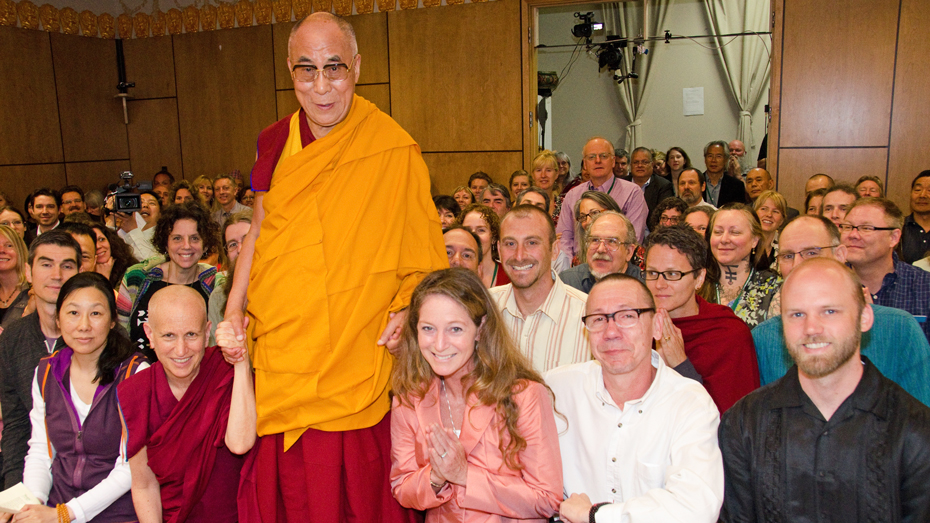
His Holiness the Dalai Lama with Ven. Thubten Chodron and students at Maitripa College, May 2013. Photo by Marc Sakamoto.
Ven. Thubten Chodron is a celebrated American Buddhist teacher, scholar, author, and leader who has published many popular books explaining the Dharma, including a 2013 work co-authored with His Holiness the Dalai Lama called Buddhism: One Teacher, Many Traditions. She has continued to work with His Holiness, and the most recent product of their collaboration is Approaching the Buddhist Path, released in August 2017 by Wisdom Publications. This book is the first in a new series—The Library of Wisdom and Compassion—that will constitute the main English-language Dharma teachings of His Holiness, intended to explain the path to enlightenment in a way suited to modern-educated people.
Former Mandala associate editor Donna Lynn Brown spoke with Ven. Chodron in June 2017 about the new series and the intentions of His Holiness.
Ven. Thubten Chodron: This is part of a series I am now doing called The Library of Wisdom and Compassion, in collaboration with His Holiness. It has a very specific purpose. Our tradition has many lamrim books as well as translations of very difficult Tibetan and Sanskrit philosophical works, but we don’t have anything that makes the connection between them. Yet His Holiness wants us to learn the philosophy that is embedded in lamrim. So we need something to bridge the gap. That’s what this series will do. It explains, in easy-to-understand English, philosophical topics and how they fit with the lamrim. Without such a bridge, people can miss out on our very rich philosophical tradition because they find it too difficult. This series also tries to clarify a lot of Dharma questions that Westerners have that Tibetans don’t usually ask. I’ve had several interviews with His Holiness, and he answered these questions in his own unique way.
Another challenge non-Tibetans have with the lamrim is that—as His Holiness explains—it was written for people who are already Buddhists. Lamrim texts don’t talk about why rebirth makes sense; they assume you already believe this. And the guru is Buddha? People say, “I just came to learn to meditate! What’s that all about?” So in this new series we are re-ordering some topics and approaching some of them in a different way. Regarding, for example, how to relate to a spiritual mentor, His Holiness explains that in depth for a modern audience. If people start out reading Pabongka Rinpoche’s Liberation in the Palm of Your Hand, they don’t know that he was teaching Tibetans who were about to take highest yoga tantra initiations. That’s not who walks into Dharma centers! People need preparatory material. In the West, what does His Holiness usually teach? Love, compassion, and secular ethics for everyone. For Westerners who are interested in the Buddha’s teachings, he starts out with the Buddhist worldview: the nature of the mind, the two truths—conventional and ultimate—the four noble truths, and the possibility of being free from the afflictions.
Understanding these topics, people will then understand something about the basis, path, and result and will see how the lamrim meditations fit in. This project takes on the task of explaining the whole path, in some depth, to people who have a modern education. This series is not limited to Westerners. His Holiness says it’s also for young Tibetans as well as Chinese, Vietnamese, and other Asian students.
I can see that this is a significant project for making the teachings of Buddhism more accessible and better understood. Can you describe what’s in the initial volumes?
Approaching the Buddhist Path is the first volume in the series. It lays the groundwork. It talks about the history of Buddhism, the Buddhist worldview, Buddhist canons and important texts, emotions, Buddhism and science, compassion, tools for the path, helping others, and so on. And it contains His Holiness’s reflections on his approach to life and personal practice as a kind of inspiration.
The second volume, The Foundation of Buddhist Practice, is now also with Wisdom Publications. It starts out with the four seals, the criteria that make a teaching “Buddhist.” It goes on to talk about gaining non-deceptive knowledge—how we know evident and obscure phenomena. In this way we’ll understand what is knowable through our senses and what initially requires reasoning to understand. In Buddhism, we don’t rely blindly on scripture, we test things out. The second volume also discusses how we go from having a wrong view to a right view. Then it talks about the different kinds of phenomena. There are chapters on the qualities of different types of spiritual mentors, how to rely on our spiritual mentors, and how to become a qualified disciple. People need to learn about this when they start out in Buddhism. We present how to structure a meditation session, and then we talk about precious human life, death and impermanence, and the lower realms, but it’s all from His Holiness’s perspective. He doesn’t describe the eight cold hells, and so on. He talks about how we are to think about these different realms. He’s such an amazing teacher because he can really tune in to his audience. We talk about the death meditation, for example, and how that helps us overcome attachment to the happiness of this life, how it helps us set priorities and be aware of what is meaningful in our lives. Really practical material. Then we come back to talking about the nature of mind and rebirth, and how we can establish rebirth using reasoning. Then there are three big chapters about karma.
Standard lamrim texts present refuge before karma, but Westerners aren’t ready to take refuge yet. To hear about the qualities of the Buddha at that point is too much for them. What people really want to know about after this introductory material is karma. What is it? How does it work? There is a lot about karma here, including material from the abhidharma, which enlarges our understanding of karma—individual and collective karma, gloomy and bright karma, and so forth. And then volume two talks about why liberation is possible and what buddha nature is. Those topics naturally follow because, having heard about karma, we want to know: can we be liberated from polluted karma? The material on buddha nature is taken from the Uttaratantra Shastra and from a text by the Seventh Dalai Lama. His Holiness went through the latter text in one of our interviews, relating buddha nature to the three turnings of the Dharma wheel and showing how the full explanation of buddha nature is found in highest yoga tantra.
So that is the second volume. The third talks about whether there is a self, the four noble truths, and it especially goes into depth about the first and second noble truths. So it explains what “duhkha” is. We use the Sanskrit word “duhkha” instead of the usual term “suffering” because “suffering” gives completely the wrong idea. Duhkha is more like “unsatisfactory circumstances.” What are those and what causes them? What is our situation here in samsara? If people don’t understand this, they’ll never aspire to gain liberation. Then we go into the different kinds of afflictions and how they work. This is followed by the twelve links—how we enter samsara—and the reversal of the twelve links—how we get out of samsara. Then there is discussion on what nirvana is. What are we aiming for? Is nirvana a state of mind? Is it emptiness?
The fourth volume begins with refuge. Having previously thought about the faults of samsara and benefits of nirvana, people now seek guidance on how to attain liberation and awakening. The qualities of the Three Jewels will now make more sense. The three higher trainings follow; they are the path to our spiritual goals. Here we present a lot of material on the four establishments of mindfulness, which is a very rich practice that people in the Tibetan tradition often do not do, even though they study it. I think it is a very helpful practice, especially before taking tantric initiations. In tantra, we imagine ourselves dissolving into emptiness and our wisdom appearing as the body of a deity. If we have not done the four establishments of mindfulness, we do not understand our current body and mind. What are their causes? How do they operate? When we understand that better, dissolving into emptiness and appearing in the form of a deity in tantra makes more sense. The fourth volume also contains an extensive explanation on how to cultivate concentration.
The subsequent volumes will cover bodhichitta, the perfections, emptiness, tantra, and so forth. When His Holiness asked me to do this, he said, “We don’t need to rewrite the lamrim! This has to be unique.” He wanted material from other Buddhist traditions included, and this has enriched the volumes immensely. The teachings on the four establishments of mindfulness and on concentration will include material from the Pali tradition, not just the Sanskrit tradition. This gives us a broader perspective on the Buddha’s teachings. The various Buddhist traditions are not unrelated; they have a lot in common. We can learn from each other. Some of the bodhisattva vows talk about respecting other traditions and teachings. We are trying to promote not only mutual respect, but also to show the validity of other Buddhist traditions and the ways that learning about them can really help our own practice.
It sounds like this series would be helpful in both Dharma centers and academic environments, and for Buddhist schools like FPMT’s Maitripa College as well.
I think so. The idea is that the series will help people establish a solid foundation in the Buddhist worldview and Dharma practice in a way that combines the richness of the philosophical texts and the practicality of the lamrim. Although the books will help beginners, they are also for people who need a bridge between the relatively simple explanations in the short lamrim texts and the profundity of the classics composed by the Indian sages. They will be a resource for anyone who wants to study Buddhist philosophy, even at a more advanced level. Since this series will be His Holiness’s major English-language teachings, I hope the books will be used in Dharma centers as well as schools and universities.
The series consists of His Holiness’s teachings. My job is to “translate from English into English,” to express more complex points in a clear and understandable way. This is not “Dharma lite”! The teachings are grounded in the genuine, reliable teachings of the Nalanda tradition, supplemented with teachings from other Buddhist traditions where that is helpful.
Do you think Asian Buddhists, including monastics, could benefit too, if the books were translated? I am told that young monastics in the Tibetan tradition, for example, often go straight into philosophical study without much explanation of basic Buddhism.
Yes, I think the books will be useful in Asian contexts, for both lay people and monastics. There is a need. His Holiness wants our earlier book, Buddhism: One Teacher, Many Traditions, to be translated into Tibetan and into as many Asian languages as possible. I anticipate that he will want this series to be widely translated as well. He mentioned young Tibetans who grow up speaking English or German as one group we need to reach out to. With their modern education, whether in India or the West, they ask the same kinds of questions Westerners ask about rebirth and so on. The contemporary style of presenting the material is not just for Westerners, it’s for anyone with a modern education or outlook. In the monasteries young people memorize the philosophical texts but they don’t initially understand the material. It would be helpful if they read this series, especially the volumes that discuss the Buddhist worldview, Buddhist values, social responsibilities, and working with disturbing emotions—all these topics that His Holiness talks about so beautifully. I also think geshes teaching at Dharma centers would find this series useful to use as a root text that that they can elaborate on.
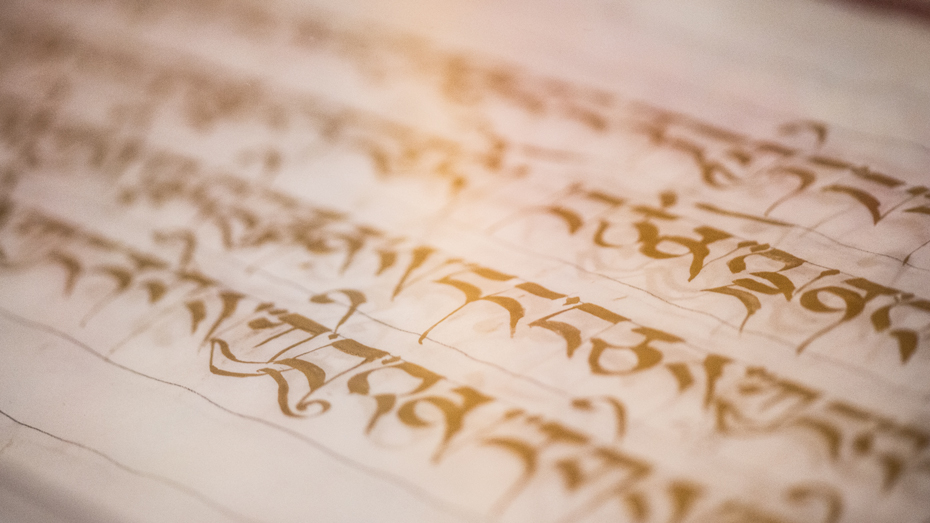
The Prajnaparamita Sutra written in gold at Kachoe Dechen Ling, California, US. Photo by Chris Majors.
Can the books be used without teaching or commentary?
Yes. People can read and learn on their own. Also, all the books in the series can also be read as individual volumes. Each book covers particular topics, and someone may want to study the topics that they are particularly interested in.
It’s very noticeable, as I look at Approaching the Buddhist Path, that you include reasoning as part of Dharma practice, not just meditation.
His Holiness always talks about that. Again and again he teaches the importance of reasoning in Dharma practice. That doesn’t mean excessive intellectual conceptualization that is “blah, blah ….” Analysis and reasoning help us to go deep and give us a framework to understand our minds and how they work, and what our life situation is and how to change it. People sometimes say they want to get away from intellectualization and meditate to develop concentration and be peaceful. But then they sit down to concentrate and their minds are all over the place. I am an example of that. At first I had no idea what to do with my mind in meditation and lacking proper instructions, I just daydreamed or got frustrated because I could not stop all the disturbing thoughts. In addition, even if we quiet our minds, which is good, we may lack a framework to identify what is a wholesome or unwholesome mental attitude, or what states are helping us to actualize our heartfelt wish for happiness and which ones interfere with that. Just having a calm mind, even if we can accomplish it, does not end samsaric suffering. We need a comprehensive worldview, an accurate path, and ways to verify for ourselves that this path will work. That’s where learning, reasoning, and analysis come in. They are essential parts of our practice.
In addition, we also need to learn how to cultivate certain mental states, such as love and compassion. We can’t will ourselves to have them. We must learn the meditations to open our hearts so that we can accept ourselves and others and at the same time learn how to become kinder and more altruistic human beings.
Are there other notable features of The Library of Wisdom and Compassion that you want to tell us about?
His Holiness’s way of teaching is unique: he will explain a fairly easy concept and then relate it to emptiness or to the extremely subtle mind. His way of clarifying sticky topics is wonderful. He understands the questions Westerners ask and answers them in a straightforward manner. He doesn’t dance around difficult topics, but addresses them directly. And his sense of humor shines through. Even though I’ve been his student for decades, in working with him on this series, the clarity of his wisdom and depth of his compassion really bowled me over.
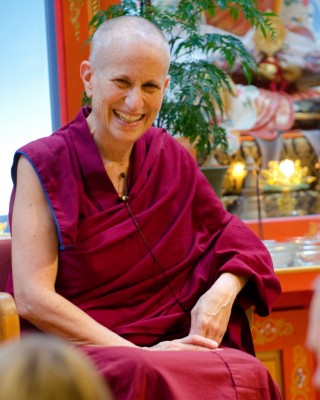
Ven. Thubten Chodron during a talk at Maitripa College, Portland, Oregon, US, March 2013. Photo by Marc Sakamoto.
Ven. Thubten Chodron has practiced the Buddha’s teachings for more than 40 years. A native of Los Angeles, she ordained as a nun in the Tibetan tradition in 1977 and received the full ordination of a bhikshuni in Taiwan in 1986. Ven. Chodron has studied extensively with His Holiness the Dalai Lama, Tsenshab Serkong Rinpoche, Lama Zopa Rinpoche, and Lama Thubten Yeshe among many other Tibetan masters. She teaches Buddhist philosophy and meditation worldwide, including having served as resident teacher at Amitabha Buddhist Centre in Singapore.
She has published many books, including Good Karma: How to Create the Causes of Happiness and Avoid the Causes of Suffering; Buddhism: One Teacher, Many Traditions; and most recently, Approaching the Buddhist Path. She is currently the abbess of Sravasti Abbey, a Buddhist monastic community in Newport, Washington, United States, which she founded in 2003.
For more on Approaching the Buddhist Path, visit Wisdom Publications online (www.wisdompubs.org).
- Tagged: his holiness the dalai lama, in-depth stories, lamrim, ven. thubten chodron, wisdom publications
28
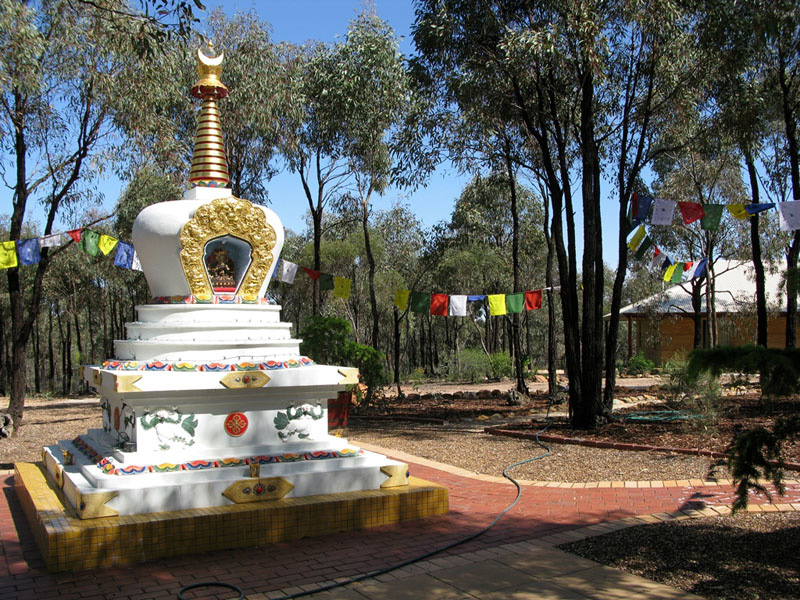
The stupa at Thubten Shedrup Ling Monastery in Victoria, Australia, June 2017. Photo courtesy of Thubten Shedrup Ling Monastery.
Recently, a group of students from Tara Institute in Melbourne, Australia, who had previously received a Yamantaka initiation from Lama Zopa Rinpoche, and again from His Holiness the Dalai Lama, gathered to form a Yamantaka study group. Yamantaka is a highest yoga tantra deity considered a wrathful manifestation of Manjushri, the Buddha of Wisdom
The group’s focus was on readying themselves for a Yamantaka retreat, which happened this June, by studying the Yamantaka sadhana, a set of esoteric meditation instructions. As they learned, the preparation ahead of a Yamantaka retreat can be testing and confusing.
The results of the entire project were as much about community as they were about the practice itself. Three centers joined in their efforts to support the students, and the teachers and participants formed a special bond that facilitated focus and determination.
Study group member Cynthia Karena shares the heartfelt reflections of her fellow Yamantaka practitioners:
Following a highest yoga tantra initiation can be perplexing. It’s hard trying to understand the profound meaning of the practice, let alone getting those complex visualizations right.
When some students from Tara Institute (TI) took the Yamantaka initiation from Lama Zopa Rinpoche at the Great Stupa of Universal Compassion in rural Australia, and then again with His Holiness the Dalai Lama in 2015 in Australia’s Blue Mountains, a few of us were daunted at the prospect of mastering the sadhana and doing the retreat. Personally, I was confused and overwhelmed.
A couple of students asked our teacher Geshe Doga, Tara Institute’s resident geshe, to teach us about the practice. He suggested we meet together as a group to study the sadhana. Long-time TI student Dr. Ross Moore enthusiastically took on the task and formed a fortnightly Yamantaka study group.
Around fifty dedicated students regularly started to work their way through the sadhana, asking questions and seeking clarification on everything from hand mudras to visualizations. Senior students generously shared their expertise, experiences, and kept discussions on track. The study group used commentaries recommended by Geshe Doga, who was regularly consulted for feedback and direction.
TI student Jill Lancashire has been around the Dharma since the ‘70s. She attended the Yamantaka study group and appreciated the set time to resolve unanswered questions.
“The study group is good to become familiar with the meditations. Having them read out so you can actually meditate on them allows you to start memorizing them. Then when you do them yourself, you meditate more than just read the words.”
The meditations are outlined in the short sadhana practice, so people know where and how they fit in, said Jill.

The gompa of Thubten Shedrup Ling Monastery in Victoria, Australia, June 2017. Photo courtesy of Thubten Shedrup Ling Monastery.
“It’s good to introduce the short sadhana to people who were newly initiated and either had no previous experience with the format of a sadhana or for whom Yamantaka was a new practice.
“The definite thing is that having a schedule and a dedicated group of co-practitioners makes it much easier to do the practices properly and keep them going.”
To have some structure in the sessions, senior student Mark Fernandes, who now runs the group, created a set of questions each fortnight around a particular theme.
Mark has been practicing the Yamantaka sadhana for almost thirty years. In preparation for leading the group, and to get a richer understanding of the practice, Mark researched teachings by His Holiness the Dalai Lama, Lama Zopa Rinpoche, Dagri Rinpoche, Geshe Ngawang Dhargye, Gelek Rinpoche, and Geshe Doga.
“Lama Zopa and then His Holiness have held Yamantaka initiations, so there’s something strong about the practice,” said Mark. “And with Geshe Doga’s guidance, we have three lamas working together to give us something special.”
At the end of last year, Geshe Doga suggested it would be good to do a group Yamantaka retreat and then self-initiation, said Mark, who then moved discussions towards the long sadhana in preparation for the retreat, so people had an idea of what to expect.
So, in mid-June, twenty-five retreatants found themselves sitting nine hours a day for three weeks inside the beautiful golden rammed earth walls of the Thubten Shedrup Ling Monastery gompa, surrounded by Australian bush.
Jill felt that the TI Yamantaka study group formed a necessary base or prerequisite to being able to fulfill the retreat commitment.
“For an ordinary person like me, the Yamantaka sadhana is long, complex, and esoteric. To go in cold to a retreat without having read and discussed the commentaries would have made it very hard to appreciate what the sadhana was actually trying to do, as a couple of people who joined us from outside the study group found out.”
Monastery director Ven. Thubten Gyatso generously invited the retreat to be held at the monastery, and Atisha Centre helped with accommodation and feeding retreatants.
Senior TI student Margeruite Hanrahan organized the retreat with the monastery’s Ven. Jampa Choepel who led the retreat and Andy Melnic, the spiritual program coordinator of Atisha Centre.
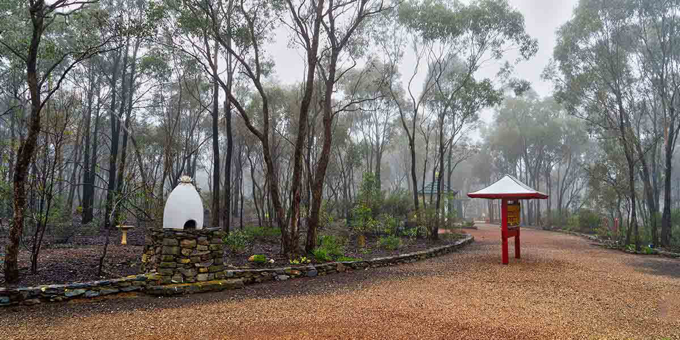
The Australian bush of Thubten Shedrup Ling Monastery, June 2017. Photo courtesy of Thubten Shedrup Ling Monastery.
The retreat demonstrates what cooperation between separate centers can achieve, said Jill. “TI, a city center with loads of students, Atisha Centre, a rural center with accommodation, and Thubten Shedrup Ling adjoins Atisha Centre and is able to provide expert Dharma guidance and exquisite gompa facilities.
“For someone who began at Atisha Centre when it was a few train carriages, a church, and a fibro hut, it was overwhelmingly satisfying to retreat in such wonderful facilities, complete with many holy objects such as the nearby Great Stupa, with such expert guidance from Ven. Jampa supported by the rest of the monks.”
“Lama Zopa Rinpoche said that the emphasis on activity of the monks at Thubten Shedrup Ling should be as in Pabongkha Rinpoche’s description of a retreat-style monastery,” said Ven. Gyatso. “In their daily practice, the monks would fulfill their tantric sadhana commitments properly and be able to perform all the associated rituals such as pujas, retreats, fire pujas, self-initiations, and so on.
“As there are so few monks at the moment, this was a good opportunity to allow the group retreat to happen. And we may well have a similar retreat next year on Heruka Chakrasamvara or Vajrayogini if the conditions remain conducive. But it’s not definite.”
Jill could not emphasize enough what doing the retreat in a monastic setting, led by a monk for whom Yamantaka was his heart practice, meant to her and the group.
“We were surrounded by holy objects in the garden outside, life-size marble statues of the Sixteen Arhats, and had the Great Stupa just down the path through the bush. Altogether it opened up another dimension that transcended knowledge. Ven. Jampa grounded us with bodhichitta and we felt the practice.
“Hit by fatigue, a few people felt like leaving, but all felt the benefit and knew the rarity of the opportunity, so all stayed and all completed. The Thubten Shedrup Ling monks conducted the fire puja and the self-initiation for us at the end, which was more than helpful, as you need real experience and expertise for these. This was the icing on the cake.”
Ven. Jampa saw the retreat as a wonderful opportunity for people to deepen their understanding and familiarize themselves with some of the more important aspects of the practice.
“Having a sincere group of practitioners that each had a strong wish to make the most out of the opportunity really made for a special occasion,” says Ven. Jampa.
Over the course of three weeks, Ven. Jampa felt the group had put real effort into each and every session. “This showed with the group settling into their practice, becoming more comfortable sitting for longer periods, increasing their ability to concentrate for longer periods, gaining a better understanding of the sadhana, and beginning to gain meditation experience of the words that were said. They were starting to transform the words of the sadhana into actual experiences that can be built on in the future.
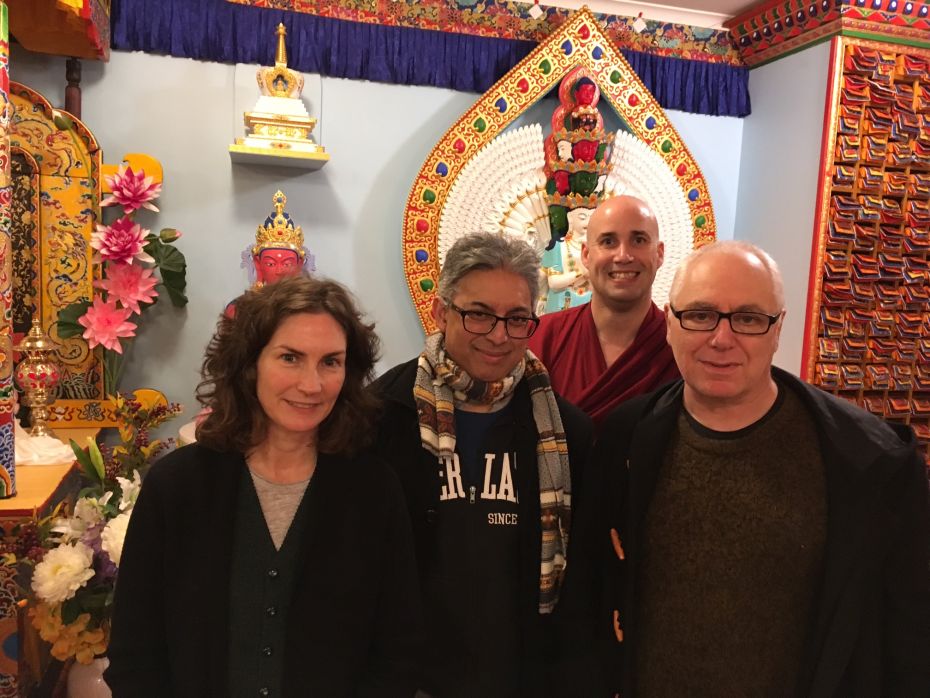
Participants and organizers of the Yamantaka retreat. Left to right: Margy Hanrahan and Mark Fernandes (Tara Institute), Ven. Jampa (Thubten Shedrup Ling Monastery), and Andy Melnic (Atisha Centre), Thubten Shedrup Ling Monastery, Victoria, Australia, June 2017. Photo courtesy of Thubten Shedrup Ling Monastery.
“The joy of a more extended retreat is having the chance to reflect over and over again on ideas like bodhichitta, emptiness, and the more specific meditations associated with the practice. Through this, we started to habituate the mind more deeply on these important ideas.”
TI’s fortnightly Yamantaka study group gave people confidence to do the retreat, said Mark. “We cleared up questions and clarified what the practice was about. After the retreat, hopefully we’ll all have a clearer mind and a better practice.
“I believe the practice was removing obstacles and generating wisdom. You could see the results during those three weeks. Some people had sublime experiences, either through dreams or though something that shifted—clarity of mind, energy, or feelings of bliss.”
The TI Yamantaka study group, with now a dedicated core of around twenty, still continues to support each other in teasing out the nuances of the sadhana to deepen their understanding. “People are still keen; they’re not tired of it,” said Mark.
“The Yamantaka practice itself through the blessings of the gurus has made a big difference to the students. And Geshe Doga has manifested great delight at the students’ efforts in the practice, which has provided further inspiration.”
Cynthia Karena has a science degree and a Masters in education. She is a freelance journalist and documentary researcher in Australia.
Learn more about the programs and activities available at Thubten Shedrup Ling, Atisha Centre, and Tara Institute.
Mandala is offered as a benefit to supporters of the Friends of FPMT program, which provides funding for the educational, charitable and online work of FPMT.
- Tagged: atisha centre, cynthia karena, geshe doga, in-depth stories, tara institute, thubten shedrup ling, yamantaka
16
‘Something to Rejoice In’: Geshe Tenzin Namdak In His Own Words

Geshe Tenzin Namdak. Photo by Deepthy Shekhar.
On May 8, 2017, after twenty years of study at Sera Je Monastic University, Ven. Tenzin Namdak, a registered FPMT teacher and native of the Netherlands, was formally awarded his geshe degree during a three-day ceremony that included public debate, recitation of memorized texts, and pujas. Geshe Namdak is the first Westerner to complete the full course of studies at Sera Je Monastery and also to sit for the final geshe examination there, a tremendous achievement.
Ven. Gyalten Lekden, who is in his fifth year of geshe studies at Sera Je, interviewed Geshe Namdak for Mandala in June 2017.
Ven. Gyalten Lekden: Thank you so much for the chance to interview you today, Geshe Namdak-la. Would you briefly introduce yourself?
Geshe Namdak: Well, “Geshe” I am not very used to yet! Anyway, I am Tenzin Namdak. I have stayed in Sera for about twenty years and studied a little bit, and based on that the monastery decided to give me a geshe degree.
You grew up in the Netherlands, where, according to the 2016 census, 68 percent of the population claim no religious affiliation. With that as your background, what was your own spiritual journey like?
You know, people in Holland are easy-going and open-minded. My parents were not really religious as such; they wouldn’t say they were Christian. When I was very young we sometimes went to church, maybe for Christmas or something, but that also disappeared after some time. So when I started looking into spiritual practice, I did not have any baggage, I was wide open.
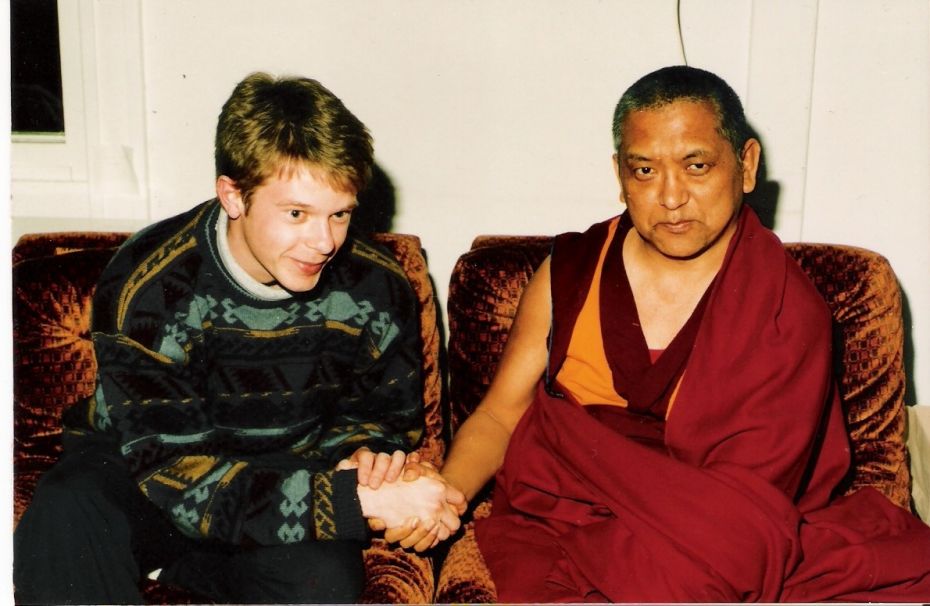
Before ordaining: Ven. Namdak with Lama Zopa Rinpoche in 1993 at Maitreya Instituut, the Netherlands. Photo courtesy of Maitreya Instituut.
When I started university, I began to generate more interest in Eastern philosophy. I had a martial arts background, first training in tae kwon do and then moving to less aggressive martial arts like kung fu and then eventually to tai chi. From there I generated an interest in Chinese medicine. At that time, I had already stopped going to parties, and the other things people normally do on the weekends. Instead, I spent my weekends studying Chinese medicine. This led me to a conference that had a variety of speakers. At that conference, Geshe-la, I mean Geshe Sonam Gyaltsen, who had just came to Holland, gave a talk about mental and physical health. I attended his talk and it was very inspiring. When the presentations finished, I went straight away to the stand of his particular organization, which was FPMT’s Maitreya Instituut, and I took a brochure.
You just finished your geshe degree, but before ordaining you completed your university degree in hydrology. Do you see some benefits of that secular study translated into your monastic study?
Growing up in the West, having an education, and working one year for the government on an environmental project—those all gave me a wide range of experience. If you want to become a monk, it’s good to have a little experience of ordinary life so you know what you are leaving behind. So from that point of view, I think , yeah, it isn’t wasted. It is beneficial to know what is going on in the West, and based on that, make the decision to become a monk, so then the decision is based in reality and not simply an idealistic or imaginative idea of what being a monk might be like. Also, study and practice in a variety of disciplines was helpful because it gave me a bigger picture of the world, which helped me to understand the study of Buddhism from different points of view. It maybe gave me ways to communicate to different types of people, too. So, like that, a little study and experience of ordinary life has been useful in making my ordained life more robust. As far as helping my study here, well, the more points of view and experience you have will always help any future study, right? A broader view helps make sure you don’t have blinders on, that you can see how different things might fit together.
You were ordained when you were twenty-five, shortly after finishing university. So in a very short time span you went from knowing nothing about Buddhism to ordaining as a monk. How did that come about?
I was actually twenty-two when I went to that first conference and twenty-three when I went to Maitreya Instituut for the first time in 1993. Having received my first teachings at Maitreya Instituut, within a few months I already thought, “OK, I have to become a monk.” Then Geshe-la very kindly said, “Don’t rush, wait. You finish uni. You stay for at least a year in the center, study more, and then we talk again.”
I graduated and then worked for the government on a project for a while. Then I finished that and lived at the center. I talked again to Geshe-la, and Geshe-la said very kindly, “OK, so if you want to become a monk, what do you want to do? Go and look at India, have a look around, see what you want to do.” So that’s what I did. Eventually I was able to see Lama Zopa Rinpoche again, who I had met him the first time in 1993, and his advice helped me make the final decision.

Debate in the courtyard at Sera Je Monastic University, 2009, India. Photo courtesy of Ryan Matsumoto.
In a 2016 Mandala article that you wrote, you say that a lot of Westerners are short-sighted, wanting to focus only on meditation practice or only on study, and they don’t create any sort of unity between the two. When you first ordained, you quickly joined Sera and began an intense study program, so I am wondering, does the advice you give come from personal experience? What led you to join the geshe curriculum at one of the Great Seats [Sera, Ganden, and Drepung] instead of focusing on meditation or retreat?
[Laughs] Well, I was very short-sighted in the beginning, too. I thought, “I will become a monk and there is no need for Tibetan language, I will just do everything in English. I will do retreats.” That’s what I thought. But then my teachers— Lama Zopa Rinpoche, Lama Dagpo Rinpoche—so kindly made it very clear that that was not the right way to go. They emphasized learning Tibetan, and based on that, going to and studying at Sera. Of course, initially, I didn’t know much about the program; it wasn’t on my mind until it was advised. So I started to learn some Tibetan in Dharamsala and then based on Lama Zopa Rinpoche’s advice I came to Sera. So that advice in my article comes from being one of the short-sighted people myself! And it was really the blessings from my gurus to see how not learning Tibetan or studying wasn’t the right way. They helped guide me to where I am now.When you first ordained, if someone had told you that you were going to start a twenty-year study program and earn a geshe degree, what would you have said?
Rinpoche told me in 1993, the first time we met! Of course, at that time it didn’t make sense. Rinpoche told me, “Learn Tibetan; become a geshe.” At that time I didn’t even know what a geshe was all about, so it was quite strange. But the idea of being in a study program for twenty more years, and finishing that and getting the geshe degree? Of course, that never comes to mind. You never think that far ahead, generally speaking. The gurus have this long-term view, but most of the time that is lacking for us. Initially I thought, “Learn Tibetan, study a bit, see how it goes. Maybe do the Prajñaparamita studies and the Madhyamaka studies, but then leave and do retreat.” But later Rinpoche told me very clearly to keep going.
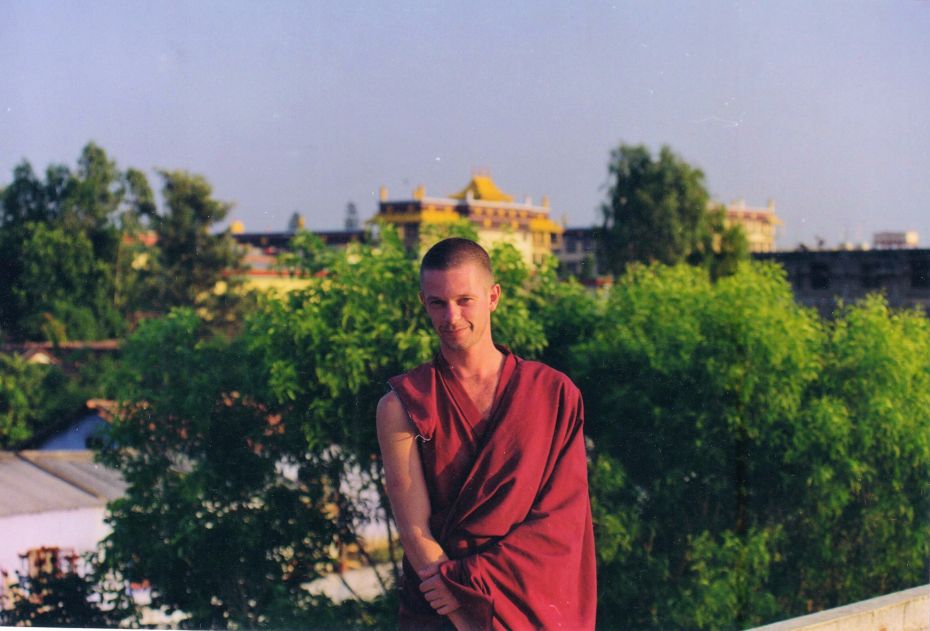
Ven. Namdak in his early days at Sera Je monastic university. Photo courtesy of Ven. Namdak.
When you finally joined the geshe program at Sera you were one of very few Westerners here, and living at the monastery was more difficult then. In addition, over any course of study or practice internal difficulties are bound to arise as well. How have you navigated those difficulties over time?
It’s true, Sera was very different than it is now. The conditions were much rougher. For example, I lived in the khangtsen and there were no showers, only a bucket for washing outside with the hand pump. The toilets were horrific. The food wasn’t as good as it is now. I lived with a roommate in a very small room, and it was always noisy and without privacy. It wasn’t always clean.
Initially, it was pretty rough. In one aspect, it was difficult. But the other aspect is that it was very good for practice. The Tibetans, they do a lot of teasing, you know? They try to go as far as possible to make the “I” come up before you actually get angry. And that is not always easy! But, in the context of the study program, it was a very helpful way to practice. Of course, sometimes I would get a little fed up. I would go to a friend’s place at the other side of the monastery and would stay there for a few days!
Even if you have good outer conditions, sometimes you can have some mental obstacles and your mind gets unhappy. Those kinds of experiences can happen wherever you go, whatever you do. But, especially here at the monastery, if you were to leave, what else would you do? Seeing the incredible benefits of the system, what else would you do? Sometimes I thought maybe retreat would be better, but other than that, nothing else came to mind. The mind maybe is unhappy, maybe because the outer conditions are difficult or maybe some other reason, but the truth is that unhappiness never comes from the outside and there really is no other place to go that offers the same benefits. The gurus advise us to stay here because no matter where you go, you cannot run away from your unhappiness—you bring it with you. You can only run away from a very beneficial opportunity for study and practice! My strategies are always the same: I try to step back to take a longer view, trust in my guru’s advice, and rejoice in the many benefits that I have. Difficulties may come, they may even stay for some time, but at a certain point, they disappear.
You have seen a lot of changes to the monastery and its academic program over the last two decades, and even more if you consider what we know of Sera in Lhasa in the early twentieth century. Our enrollment numbers are down every year, the outside world is definitely more distracting than ever before; it seems obstacles come from all sides. Speaking as someone who has now completed this method of institutional study, where does this traditional monastic university go in the future?
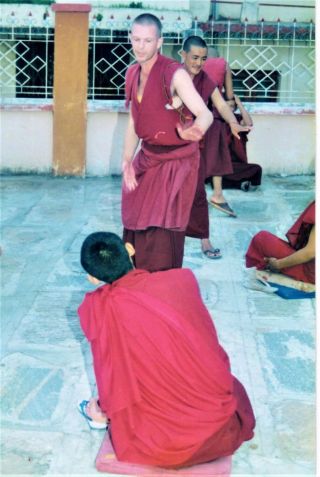
Ven. Namdak debating at Sera Je in 2001. Photo courtesy of Ven. Namdak.
According to His Holiness the Dalai Lama, the real preservation of the Dharma of the Nalanda tradition is done mainly through Ganden, Drepung, and Sera—the Great Seats. Of course, there are big monastic institutions of the Nyingma and other traditions as well. If those disappear or degenerate, then upholding the whole Buddhist doctrine and the Nalanda tradition becomes more difficult. Sometimes it is important to remember the real purpose of a monastery like Sera: to provide an unbroken and authentic lineage of the teachings of Je Tsongkhapa for all future generations. The heart of the monastery is to do that, and for those of us here, we just get some benefit from being part of that, being close to that. I’m not saying that I am doing that, of course! I just happened to stay here long enough that they gave me this new title.
They say that compared to what it was like in Tibet, the number of really top scholars and the level of scholarship is maybe not so high now. However, the overall level of study is much higher than it was in Tibet, because there is more availability. So even if the top of the top isn’t as high as before, the average is higher, and from that point of view, it is a positive. From another point of view, of course, there are fewer monks coming—and that’s a bit of a worry.
I think that if the monastery can show the monks how to embrace the modern world and modern learning without sacrificing the authenticity of the lineage, then it might help with our enrollment and dropout rates. One way the monastery is trying is the new science studies the monastery has started. His Holiness the Dalai Lama has been pushing science studies forward for the last few decades. Using outside forms of authority—for example, academia—to explore and reinforce the Dharma brings more support and respect from international spiritual and scientific communities, and that is helpful. This is something I have been interested in, too. Not the physical sciences so much, but the mind sciences and some quantum sciences, what bits I can understand. I think they complement the Dharma study and give more tools to use when I contemplate the meaning of the texts. Of course, this kind of study is secondary next to the philosophic studies. It is a yan lag, a “branch.” The main thing is the studies. But if you have science, it is yan lag phun sum ‘tshogs pa, which means the right aspects are present to preserve the Dharma as it interacts with the outer world. The monks need to have an understanding of how to communicate with people outside the monastery, and not just the language, but also the ideas, the concepts. They need a little scientific understanding of the world as well.
For the last twenty years not only have you been engaging in studies full time, but you work for the monastery quite a lot and the greater Dharma community in the area. You helped establish IMI House and have been its director for quite a long time. You helped organize and teach translation courses here at the monastery. You have translated for various lamas that have traveled through the monastery. You’ve worked with His Holiness’s office to run the pre-ordination course in Dharamsala for the last six years. And of course you have been instrumental in the growth of Choe Khor Sum Ling, the FPMT center in Bangalore. The monastery is already a full-time commitment and you add a few more full-time commitments on top of it!
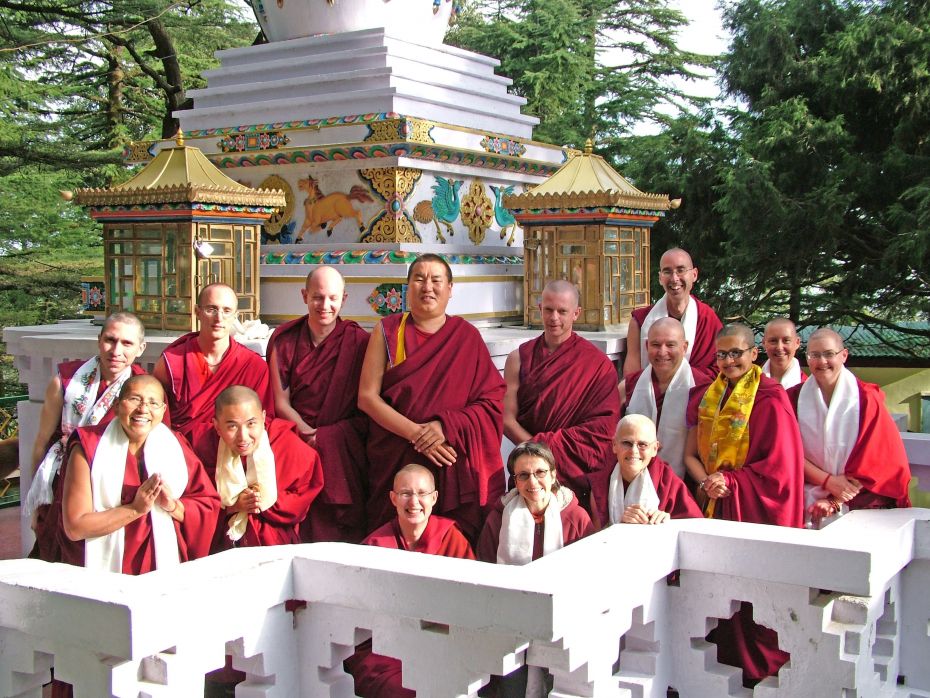
Ven. Namdak with the participants in the pre-ordination course along with Geshe Tsering Choephel and SPC Ven. Kunphen, on Lama Yeshe’s stupa, 2014. Dharamasala, India, 2014.
Well, the monastery curriculum by itself is very busy. On top of that, since I came to Sera, Lama Zopa Rinpoche has always very kindly had something for me to do, in case I were to get bored. In one way, it is a busy schedule, but it gives me satisfaction. If studies are mainly to cultivate and benefit my own mind, then doing these projects for others on the side gives me a little bit of satisfaction, because I can think, “Wow, it’s pretty beneficial to be here because I am doing these studies, but alongside these studies I can try to benefit others as well.” So I think that maybe asking me to do all of these kinds of projects is the kindness of Lama Zopa Rinpoche, to make sure I get some kind of merit! Perhaps a little bit of merit helped me to get through the studies. He always takes the long view, as I said.
Most of the work we do in the monastery is not ordinary work, right? Especially organizing teachings or doing Rinpoche’s projects, like those for the Bangalore center. It is for the vast vision of the gurus, so it is basically also an accumulation of merit. That’s what we like to do in our daily practice as well. We like to accumulate merit and purify negativities and transform the mind. You get a lot of opportunities from following the guru’s advice and all of these other things as well. For example, we had just finished building IMI House here at Sera when Lama Zopa Rinpoche came—that same year—to start the Bangalore center, Choe Khor Sum Ling, on the advice of His Holiness the Dalai Lama. I was very afraid because I thought, “Rinpoche is going to ask me a favor,” and then, of course, Rinpoche did! He is very kind that way. You see how I was thinking only about myself and he helped me break through that? At first it was very tough, there were various obstacles, but that happens with new centers. In the beginning we had to put a lot of effort into it. But then after some time, it started to take off, and we didn’t have to do quite as much work as we did the first few years. Getting to be part of the guru’s vision, seeing something develop like a center, a community that is self-sufficient, and sharing the Dharma—that’s a good feeling. It makes all the work worth it!
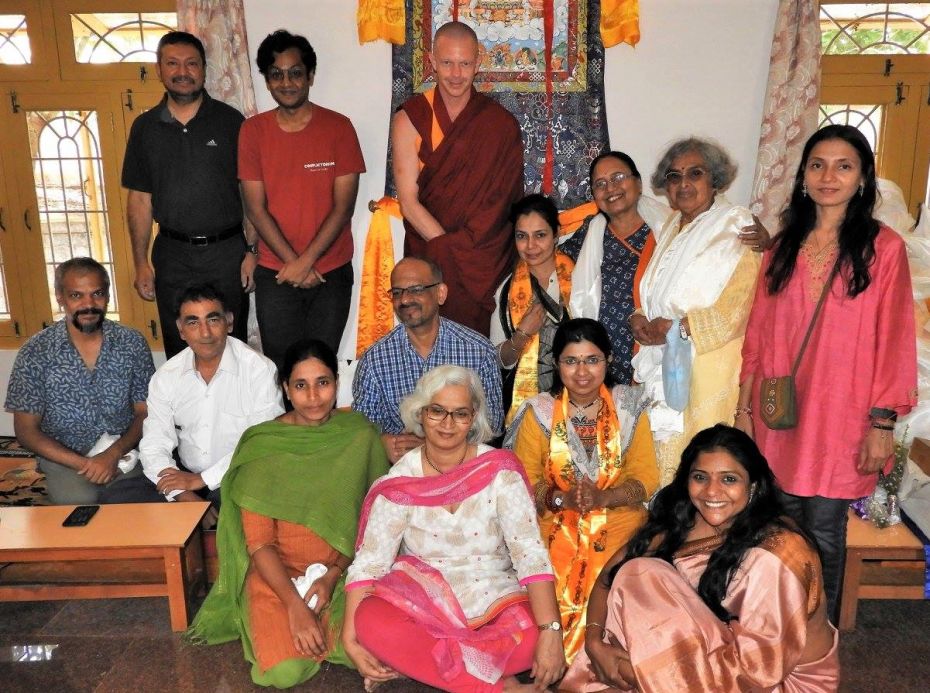
Geshe Namdak with students of Choe Khor Sum Ling, Bangalore, India. Photo from CKSL via FB.
Of course, it isn’t always easy to balance these projects with my studies and practice. Sometimes it’s difficult. At those times I just do my commitments and that’s it—there’s no more time. But there are other periods where it is a little more relaxed, you know? I think it’s important, whether or not you’re in the middle of a Dharma project, to make sure to reserve some time for your practice. Take some time off to do some retreat. Or, on a daily basis, don’t answer phone calls until a particular time in the morning, but instead, do lamrim contemplations and commitments quietly and think about the meaning a little bit. Of course, if things have to happen and you have to work, then you have to do the best you can. Dharma projects and center work are also practice, so I always keep that in mind. I mean, we always pray to become a buddha for the benefit of all sentient beings. This is how to do that, you see? Following the guru’s vast vision means that you’re not only doing your own thing and your own practice, but also on the side you are able to benefit others. My personal capacities to benefit others are very limited, of course! Still, I try to follow the guru’s advice, the guru’s instructions, and slowly things work out, no matter how busy things seem to be.

Ven. Namdak receiving a blessing from Lama Zopa Rinpoche at Choe Khor Sum Ling, Bangalore, India, 2016. Photo courtesy of Choe Khor Sum Ling.
You’ve joked about not having any karma with the United States, no karma to live in a big, fast-paced city. Joking aside, what do you think about living as a Dharma practitioner in an environment where the conditions are not considered conducive?
It’s the same in Sera, right? It’s not always easy, whether the conditions are rough or if you have been given advice that keeps you very busy. I think having faith in the long-term vision gives you strength and helps keep the mind happy. When the mind is happy, it is easier to do your practice as well. I always remind myself how far-reaching the guru’s vision is, how the guru is thinking about so much more than just this small moment, and understanding that makes the difficulties of the immediate moment fall away.
I think we are very short-sighted, generally speaking. If you have the long-term view, like the gurus have … I mean, they are looking at lifetimes! But even in one lifetime the mind can change! One year, two years, three years, ten years, it can happen! What the teachers here advise is go over the texts, study, try to put things into practice. It is not always easy and maybe the mind doesn’t change right away. However, all of the seeds are there, the seeds are planted—one day in the future the mind will change. I make sure that, on a daily basis, I am grounded in my practice, grounded in the lamrim and lojong. It is about habituation. Over time it will bear fruit and it will be easier to deal with the external environment and all sorts of people.
You have to have a great vision but without too many expectations—“I’m going to change my mind within a few years” or “I’m going to get realizations if I do this three-year retreat”—because of course it’s not going to happen the way you expect. If we think of the three countless great eons it takes to become a buddha according to the fastest track in sutra system, then what is a few decades of study or a few decades of retreat or a few decades of serving the center, or whatever? It’s peanuts, right? So if you think in that way, about the big picture, how over lifetimes you are going in the same direction, then one day, the realizations come. And maybe before those realizations, even if the situation is rough, you can still find it meaningful and find ways to have it encourage your practice.
Other than the actual Buddhist philosophy, what have you learned the most over the last twenty years here at Sera?
I don’t know. I mean, to develop the mind takes a long time, right? It’s the same with learning a language, it takes a long time. And you don’t really notice if you progress or not because it is a very slow process. I have learned a lot from the Tibetans: to be more relaxed, to do things in a relaxed manner. Some of the monks are very relaxed, but at the same time they work very hard. Keep the mind in that relaxed state—that’s what the gurus show us all of the time. I learned quite a bit from the Tibetans to be serious, to work as hard as you can—but keep a kind of relaxed state of mind. Sometimes that’s not always easy, though!
The other monks at Sera IMI House call you “the MVD,” which stands for the Most Venerable Director, a play on the idea of MVP, the Most Valuable Player on a sports team. And it’s true that you’re a role model and example for a lot of other monks here, Westerners and Himalayan. Is that something you think about?
It is the same way I think about giving talks and interviews. Just generate a good motivation, pray to the guru, and then try to do the best you can do. If it works out well, then, it works out. I don’t really go for thinking about these things too much; it really isn’t helpful to ever think about yourself like that.
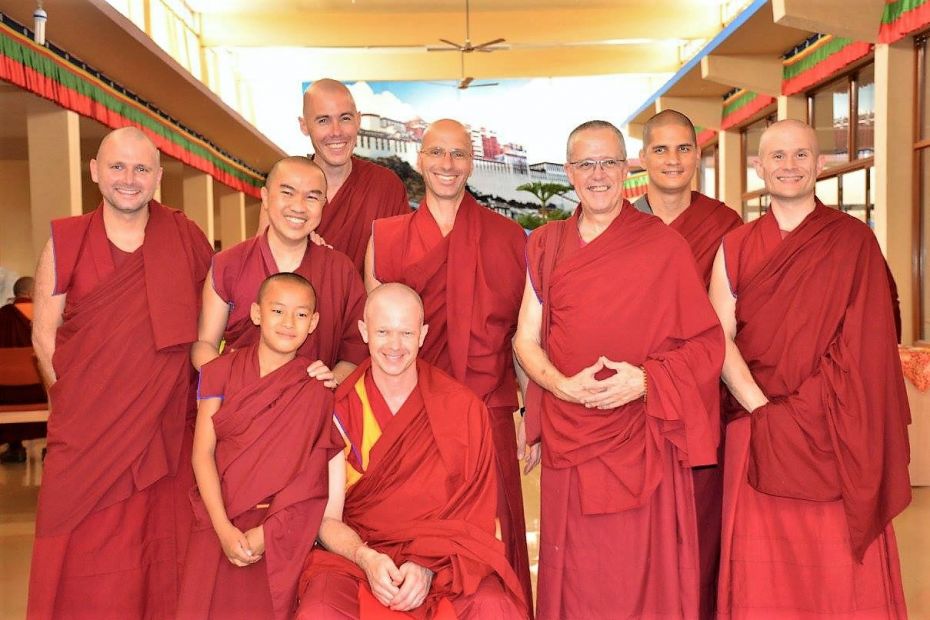
Geshe Namdak attending his graduation ceremony with other IMI monks and his students. Sera Je Monastic University, India, May 2017. Photo from Choe Khor Sum Ling via Facebook.
Considering all of your training and your experience, and that you are the first Westerner to enter and complete the geshe curriculum in its entirety at Sera Je, what comes next?
I want to disappear into a cave! Rinpoche advised maybe half teaching and half retreat, and he also indicated to visit different centers, which fits me and gives me more freedom to do some other projects as well. So, I think I will give some courses here and there, do some retreat, as Rinpoche has advised, go to Gyume Tantric Monastery for a year or maybe a little longer. We will see.
So, the million-dollar question, I suppose: Looking back over the last two decades at Sera Je, are you happy?
Happy? At which level? [Laughs] I mean, generally speaking, of course. Finishing the whole study program gives an opportunity to rejoice. I didn’t do much but at least there was some Dharma activity involved for the last twenty years, so that is something to rejoice in, and that makes the mind happy. Having had the opportunity to have studied the five major topics of Buddhist philosophy extensively together with doing countless prayers and pujas in big gatherings of Sangha and having received many precious and rare teachings over all those years feels very fortunate. So, yeah, I suppose I have been pretty happy with how it has gone the last twenty years. I have been very fortunate that the guru gave me this opportunity!
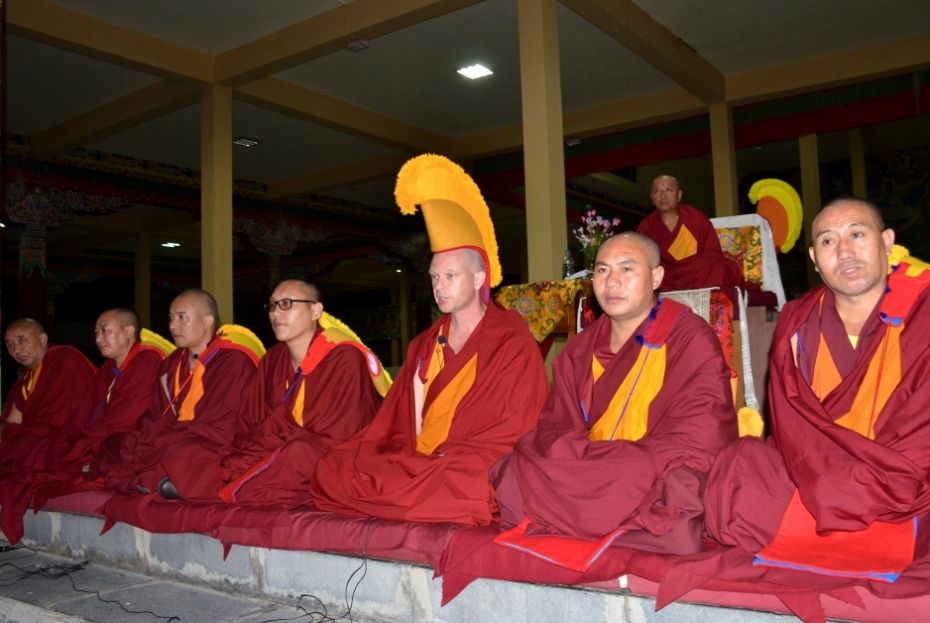
Geshe Tenzin Namdak answering debate questions during the geshe graduation ceremony, Sera Je Monastic University, India, May 2017. Photo courtesy of Sera Jey Audio Visual Center.
Read more about FPMT-registered teacher Geshe Namdak.
Watch a video of Geshe Namdak’s graduation ceremony.
Mandala is offered as a benefit to supporters of the Friends of FPMT program, which provides funding for the educational, charitable and online work of FPMT.
- Tagged: choe khor sum ling, geshe studies, geshe tenzin namdak, in-depth stories, sera imi house, sera je monastic university, ven. gyalten lekden
28
Buddhist Conduct: A New Resource from Old Tibet

Prayer flags and mani stones near Lawudo, Nepal, 2019. Photo by Harald Weichhart.
The Just King: The Tibetan Buddhist Classic on Leading an Ethical Life has recently been published by Snow Lion/Shambhala. It presents a lengthy work on ethics by Tibetan luminary Jamgön Mipham (1846-1912) translated by distinguished scholar-practitioner and former Sera Je monk Dr. José Cabezón. Mipham’s text is one of the most comprehensive works on Buddhist ethics ever written, and deals with ethical self-cultivation, interpersonal behavior, social justice, criminal justice, government, management, taxation, the environment, and many other topics. Although Mipham was a Nyingmapa, his text is a summary of Indian sources foundational for the Gelug and other Tibetan schools. It draws on several sutras, including the Sutra of Golden Light, a favorite of Lama Zopa Rinpoche, to which Mipham devotes an entire chapter; and several Indian ethics and advice texts, including Precious Garland, Letter to a Friend, and The Staff of Wisdom by Nagarjuna. Mipham synthesized these works with the popular “mi-chö,” or “folk” teachings of Tibet concerning proper or beneficial conduct. Thus, his book is quintessentially Tibetan Buddhist, drawing on both canonical Indian Buddhist sources and traditional Tibetan wisdom.
In this article, Donna Lynn Brown, former Mandala associate editor and graduate of Maitripa College, discusses The Just King in the context of a conversation with Dr. Cabezón and some reflections on the teaching of Buddhist ethics from FPMT-registered teacher Don Handrick.
A Simple Question

Dr. José Cabezón giving a talk at Maitripa College, Portland, OR, US, September, 2016. Photo by Laura Miller.
How should Buddhists behave? It’s a simple question—but it doesn’t have a simple answer. Buddhists often vary in their views on ethical issues. Nevertheless, FPMT-registered teacher Don Handrick offers an important starting point: in his experience, most Buddhists want to live in accordance with Buddhist ethical teachings. But do we know what those are? Although the lamrim and mind-training texts used for teaching basic Dharma explain compassion and karma, which ground Buddhist morality, they do not always provide details on how to live ethically in the modern world. Teachings on ethics can be found in sutras and commentaries as well, but it can be hard to determine which texts are most relevant today. The specifics of Buddhist conduct are thus not taught all that often in Dharma centers.
Lama Zopa Rinpoche consistently recommends the lamrim and Liberation in the Palm of Your Hand by Phabongka Rinpoche as sources on the ten non-virtuous actions. Handrick has also taught Atisha’s brief work The Bodhisattva’s Jewel Garland, which contains useful material on living responsibly in the modern world. He notes that people in FPMT sometimes navigate interpersonal issues using A Practical Guide of Skillful Means, FPMT’s training manual for its Foundation Service Seminar, which he calls an effective resource. He has also been examining the secular ethics presented by His Holiness the Dalai Lama in his book Beyond Religion for potential use in teaching difficult modern topics.
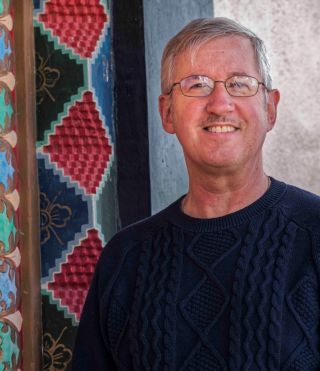
Don Handrick, Santa Fe, US, February 2017. Photo by Jack Mitchell.
Teachings on social and environmental justice are particularly rare in Tibetan lineages. For these, one option Handrick has taught is Active Hope by Joanna Macy, a Buddhist teacher influenced by Tibetan and Theravada Buddhism as well as Western thought. He likes its combination of both Buddhist and contemporary views on caring for the planet and its inhabitants. And Tibetan lek-she texts, containing verses of advice, like Sakya Pandita’s famous Treasury of Good Advice and Gelug luminary Gungthang Rinpoche’s The Water and Wood Shastras can provide a foundation for discussion and reflection. Yet while His Holiness encourages engaged Buddhism, Handrick notes that there is a shortage of texts in the Tibetan tradition to help Dharma students determine how important social action is to a life in the Dharma, what social issues are imperative to tackle, and what stand on any given issue is “Buddhist.” At the same time, he perceives a growing interest from Buddhists in teachings on social justice.
The bottom line is that there is no single comprehensive work in the Buddhist canon that encapsulates teachings on ethics and social justice in a way that crosses cultures and eras. The broadest and most systematic ethical works in Buddhism are likely the monastic law codes found in the vinaya, but these are not intended to guide lay people’s lives. Given this, it seems there is room for another text that addresses not just personal morality for lay people, but also how to promote social and environmental justice, and that integrates teachings from a number of valid sources. That’s what José Cabezón thought too when he started reading Mipham’s book with graduate students in a Tibetan literature class.
A Potential Answer
The more of Mipham he read, Cabezón reports, the more intrigued he became, and the more convinced that the text deserved to be translated. He explains: “Mipham’s great contribution was to synthesize all of the relevant Indic and Tibetan materials. His work is a digest of all of the ideas on ethics, governance, and social justice found in the Buddhist Sanskrit literature and the ‘folk’ literature of Tibet. To my knowledge, no other work, Indian or Tibetan, ancient or modern, does such a thorough job of bringing these sources together.”
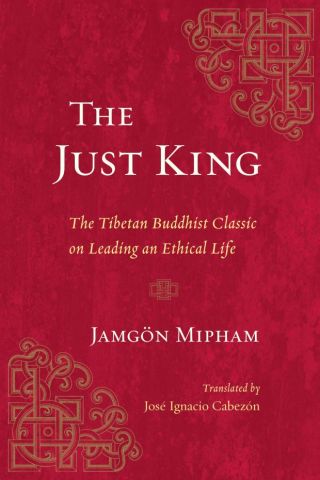
Courtesy of Shambhala Publications.
So the text is comprehensive. Is it also relevant? Cabezón says, “Mipham advocated a wide range of ethical principles. These include non-harming, cultivating virtue, caring for the poor and vulnerable, respecting all religions, not damaging the environment, a fair criminal justice system, and a government responsive to social needs. These principles are as relevant now as they were when Mipham was writing. And the text is clearly Mahayana—it has an ongoing focus on the role of compassion in ethical conduct, and it emphasizes the importance of engaging with the ordinary world.”
“Buddhism,” concludes Cabezón, “has a lot to say about the issues we face today. And Mipham’s text is a useful guide. It applies to everyone. And it is readable. Mipham makes Buddhism’s teachings on ethics and social responsibility very accessible.”
The book is long, and a brief article can’t do it justice. But it might be useful to summarize some aspects of its approach. If, as Handrick has found, Buddhists wish to practice ethics and social responsibility grounded in Buddhist teachings, they need to know what these are. Some of the answers are in The Just King. To be clear, many ethical standards taught by Mipham are in accord with modern secular ethics. Areas of overlap in the category of personal morality, for example, include directives like compassion/non-harming/helping others; not lying/being honest/speaking helpfully; and not stealing/protecting others and their property. Cabezón notes that “a lot of the ethical principles that Mipham outlines will be familiar to Western readers.” That’s a good thing: most Buddhists will not want to discard contemporary ethics, based on equality, human rights, and justice. And Mipham, drawing on the same traditional Buddhist sources that the lamrim does, sees the ten non-virtues as universal wrongs: just what those trained in lamrim would expect.
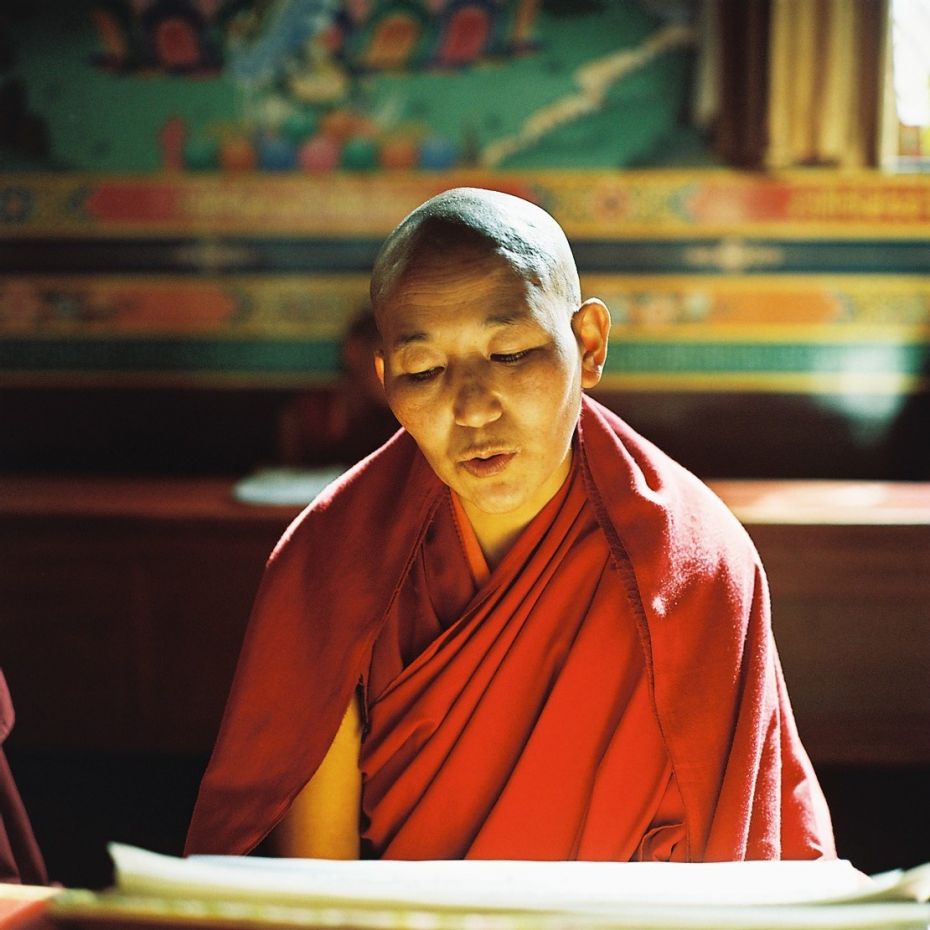
Nun reading a text. Photo by Olivier Adam.
What Distinguishes Mipham’s Approach to Buddhist Conduct?
A starting point: the book emphasizes that personal morality is the basis for all other aspects of conduct, including working for justice. Mipham places ethical self-cultivation first. This teaching applies to rulers and leaders, but its basic principle—that one cannot guide others, or act beneficially, without having first cultivated virtue oneself—applies to everyone. And being a good and ethical person is not a minor practice, quickly accomplished; personal integrity develops over time as individuals learn and apply numerous ethical standards, implement proper conduct, and develop virtues in a plethora of areas that Mipham describes. Interestingly, Mipham also prioritizes self-care: that taking care of one’s own body, mind, and worldly life is required to create a healthy foundation for Dharma study, contemplation, and action. Pure morality, self-care, and self-cultivation are thus interconnected, and form the basis for activity in the world.
Don Handrick observes that “Dharma students’ views on Buddhist ethics and conduct tend to be based upon non-harm, in line with the idea that His Holiness articulates: ‘If you can, help others; if you cannot do that, at least do not harm them.’” Morality for Mipham also starts with avoiding the ten non-virtues and other forms of harm. Wisdom is key to this; it lies behind all good conduct. This is not necessarily wisdom about ultimate reality; it is developing, through study and experience, the intelligence to distinguish between good and bad, right and wrong, truth and deception, justice and injustice, fairness and unfairness. This is a ruler’s responsibility first, since rulers set the standard, but it is vital for everyone.
In addition, Mipham identifies numerous good qualities to cultivate. He promotes disciplined, respectful, and humble behavior, but also having self-confidence based on a realistic recognition of one’s own abilities, not tolerating bullying, and knowing and pursuing one’s own goals even in the face of impediments created by others. He favors self-knowledge, assertiveness, and perseverance. He praises helpful speech, keeping one’s word, and being honest and truthful, but he is also realistic and advises his readers to analyze others’ speech and determine when they are being dishonest. He teaches that one should be a loyal friend, and adds that one must rely only on good and truthful friends and advisors, avoiding ill-motivated or misleading people. He offers much good advice for running organizations, managing staff fairly and kindly, keeping good boundaries, and even working with lamas and teachers. There is far more; these are just some examples of his advice for living wisely and cultivating goodness.
A second key point: Mipham connects living ethically, for everyone, to a more stable and sustainable world. He cites rulers to begin with. One reason why those in power are instructed to be ethical is that their behavior influences that of everyone else. Comments Cabezón, “Mipham considered that righteousness would trickle down from the ruler to his ministers to the people.” So there is a need to demand principled leadership from those in power.
But Mipham’s canonical Buddhist sources go on from there to teach that the ethical conduct of citizens as well as rulers drives the sustainability, prosperity, and happiness of a country—including its climactic conditions and environment. In other words, there is an order that, when disturbed by inappropriate conduct, reacts by bringing on illnesses, wars, devastating weather events, crop failures, famine, diminished wealth and lifespan, and other disasters. Given its impact, personal morality thus becomes a social responsibility. But so does working for justice, because unresolved injustices are environmentally disruptive in the same way as flawed personal behavior. Both lead to catastrophe.
That transgressions against morality and justice are at the root of environmental and social collapse is not precisely the contemporary way of thinking—and yet the idea accords well with the modern acceptance that harmful or unjust human actions are damaging society and the planet. Mipham only adds that personal conduct is a part of this too. This notion seems to be supported by Lama Zopa Rinpoche, who in 2009 said with reference to climate change: “People think, ‘This is a natural disaster,’ but it doesn’t happen without a cause, and the main cause is karma … of course, there are conditions, such as pollution from cars, etc., that we commonly understand. But we have to understand there is a reason, and that is our past negative thoughts and actions. … We don’t normally talk of karma in a general situation regarding the environment, but it is important to educate people.”
A third distinguishing feature of the work is its descriptions of what constitutes good government and a just world. Mipham cites a wide range of factors, such as:
- A fair criminal justice system, where wrongdoers are stopped and punished, but with compassion rather than vengefulness, and without capital punishment. Mipham recommends equality before the law: even kings are subject to the law, and punishments should not vary based on offenders’ wealth or social standing. The law should keep honest people safe and ensure victims receive fair treatment.
- Ending corrupt behavior by those in power, with offenders banished.
- Impartial respect and protection for all “ancient” religions. Both conflict among religions, and their blending into a single “pastiche,” should be discouraged by governments.
- Protection by governments for the environment and all the living beings in it, as well as for homes, crops, cultural treasures, art, and architecture.
- Fair taxation. Individuals should not begrudge the payment of their fair share of taxes, but taxation should be on a sliding scale, with the wealthy paying a higher rate and the poor paying only small amounts or nothing at all.
- Discouragement by governments of income inequality.
- War as a last resort; all efforts must be made to maintain peace. If a war is inevitable, lives and property must be protected to the extent possible.
- Protection and care by governments for the poor, elderly, vulnerable, and suffering, and all citizens in times of natural disasters, famines, and so on. Governments should also protect visitors to the country.
- Assurance of the well-being of ordinary people by governments, by building hospitals, schools, parks, roads, and bridges; by supporting artists, dancers, and musicians; and by ensuring that everyone has a means of livelihood.
In this manner, Mipham reveals what a good society might look like, and thus points at potential areas of social justice that Buddhists can pursue.

Trashichhodzong Monastery in Thimphu, Bhutan, taken during Lama Zopa Rinpoche’s visit, June 2016. Photo by Ven. Roger Kunsang.
The Challenges of a Pre-Modern Text
Is there anything not in the book that we might expect to find? Well, there is no mention of vegetarianism, even though Mipham speaks repeatedly about caring for animals. Given that some of Mipham’s Indian sources opposed meat-eating, Cabezón attributes Mipham’s silence on the practice to a sensitivity to his Tibetan readers. The book also contains little material on love or sex. Mipham stresses the avoidance of sexual excess and adultery, but does not dwell on other aspects of intimate relationships. With respect to government, Mipham offers a great deal of material on how countries should be run, thus giving readers measures by which to judge policies and leadership. Yet he also teaches that bad leaders will fall from power without citizens themselves taking action. Don Handrick observes that many modern Buddhists are seeking practical advice on Buddhist ways of engaging in political and social action. Mipham provides little guidance in this area.
It is worth noting that Mipham is not a moral relativist. In his eyes, morality and ethics are mainly universal and rule-based, not situational: there are clear rights and wrongs. Nevertheless, he is quicker to prescribe compassion or patience for the shortcomings of ordinary people than for wrongdoing in high places. This soft spot for the common folk, and particularly the downtrodden, may be related to the Mahayana orientation of Mipham and his sources, and is one of the most appealing aspects of the book.
Are there any teachings in the book that are not suitable for modern Buddhists? Cabezón notes, “In a couple of instances, Mipham reproduces verses from the Indian tradition that see women as manipulative, untrustworthy, and in need of control. Such verses need to be seen within their social and historical context—but it is appropriate to critique them.”
Given the historical setting, it is not surprising that Mipham also lacks a clear concept of human rights. This shows up in his references to slavery, which he takes for granted and does not denounce. His acceptance of slavery parallels his acceptance of male control over women. For example, in a verse on theft, he gives instructions for dealing with the theft of “wives and slaves”—a special kind of property, it seems. Such were the times. Mipham teaches that women, servants, slaves, enemies, evil men, and animals should be objects of compassion, care, and protection. Yet they do not have what would now be called “rights.” Mipham’s acceptance of a social structure in which some people have wide-ranging control over others does not negate his good advice in countless other areas. But it is a reminder that readers will need to use judgment, and adopt teachings that meet modern as well as ancient moral standards.
Conclusion
Overall, The Just King is a practical resource for those interested in Buddhist approaches to good conduct. The ethical implications of important sutras and commentaries, such as the Sutra of Golden Light, are explained in a readable and accessible way. Much sound advice for living in the world is offered. Importantly, aspects of what a just world might look like from a Buddhist perspective are described, providing a potential basis for Buddhist social engagement. While some teachings in the book will need reappraisal in the modern context, most are strikingly apt, and all can promote fruitful discussions on Buddhist priorities, values, and conduct.
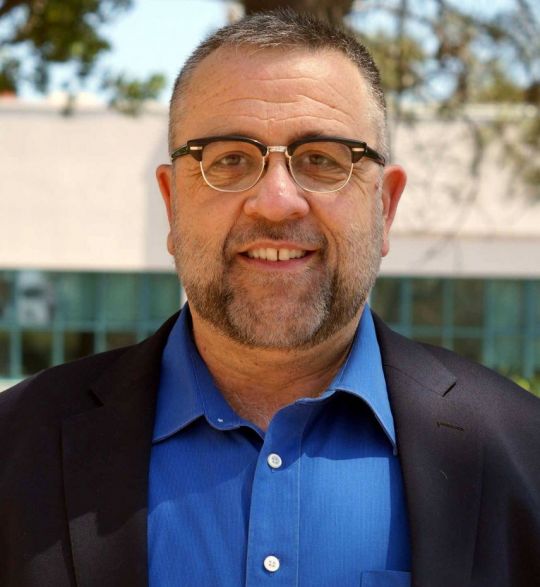
Photo courtesy of Dr. José Cabezón.
José Cabezón, Ph.D., is a professor at the University of California in Santa Barbara, US, holding the XIV Dalai Lama Chair in Tibetan Buddhism and Cultural Studies. He studied with Geshe Lhundub Sopa at the University of Wisconsin, was a monk for ten years, six of them studying at Sera Je Monastery, and has published several distinguished books as well as countless academic articles. His two latest works, Sexuality in Classical South Asian Buddhism (Wisdom Publications) and The Just King (Snow Lion/Shambhala Publications) are being published in 2017.
Find more information on FPMT-registered teacher Don Handrick:
https://www.donhandrick.com
Go to the FPMT Online Learning Center’s Discovering Buddhism course to learn more about the ten non-virtues, karma, and other topics related to this article as taught by Lama Zopa Rinpoche and FPMT-registered teachers.
Mandala is offered as a benefit to supporters of the Friends of FPMT program, which provides funding for the educational, charitable and online work of FPMT.
- Tagged: donna lynn brown, in-depth stories, jose cabezon, mipham rinpoche, sutra of golden light, the just king
15
Freda Bedi’s ‘Big’ Life: An Interview with Vicki Mackenzie

1963. The Young Lamas Home School, Dalhousie, India. Freda Bedi with the reincarnated Tibetan lamas she was educating in English and modern history to bring Buddhism to the outside world. (Photo courtesy of Faith Grahame via Shambhala Publications, Inc.)
Freda Bedi, born in 1911 in England, lived a “big” life. She attended Oxford University, where she met and married Baba Pyare Lal Bedi, who was the sixteenth direct descendant of Guru Nanak, founder of the Sikh religion. They moved to India in 1934 and were active in the Indian national independence movement; she was one of Gandhi’s handpicked satyagrahis. Bedi later played a significant role in providing support to some of the first Tibetan Buddhist lamas to teach Westerners, primarily through the Young Lamas Home School, which she established in 1960. Lama Zopa Rinpoche was one of the many young tulkus who attended the school. He often speaks of how Freda Bedi helped him.
In April 2017, British journalist Vicki Mackenzie talked with Mandala about her new book The Revolutionary Life of Freda Bedi: British Feminist, Indian Nationalist, Buddhist Nun. Mackenzie discussed with Mandala managing editor Laura Miller the origins of the book, Freda Bedi’s many achievements, and how she managed to accomplish several lifetimes of work helping others in just one life.

Freda Bedi, Lama Zopa Rinpoche, and Lama Yeshe with Marcel Bertels and Nick Ribush in foreground, Kopan Monastery, Nepal, March 1976. Photo courtesy Lama Yeshe Wisdom Archive. About the visit from Big Love: “Rinpoche told his old teacher, Freda Bedi, now Sister Karma Tsultrim Khechog Palmo, that he just wanted to meditate. Sister Palmo had accompanied His Holiness the sixteenth Karmapa to Boudhanath for the opening of a big new Nyingma-Kagyu monastery, where he gave three months of extensive teachings and initiations. Lama Yeshe invited her to visit Kopan where she advised Western practitioners to pray to the guru until tears fell from their eyes.”
Mandala: What inspired you to write this book?
Vicki Mackenzie: I never met Freda Bedi. It was such a shame. But from my earliest days in the Dharma, I heard about her. I went to Kopan in November 1976 for my first course there, and she had just visited. There was a buzz because Lama Yeshe had brought her into the gompa, into “the Tent” as it was then called, and put her on the throne. He made three full-length prostrations to her. Unfortunately, she died shortly afterwards, in 1977.
Then when I was writing the book Cave in the Snow, I heard about her from Jetsunma Tenzin Palmo, who had helped her at her Young Lamas Home School. Tenzin Palmo said she was such an extraordinary woman, a powerhouse. She had an incredible life, a big life, many lives in one lifetime. So my ears pricked up. And after Cave in the Snow, Tenzin Palmo kept saying, you really must write a book about Freda Bedi, women need inspirational role models. But I wasn’t interested then because I didn’t want to write a book on another British woman who had become a Tibetan nun! She kept pushing though. And then I got a letter from Ranga Bedi, Freda Bedi’s eldest son, saying we’re looking for someone to write a book about our mother. He said the Dalai Lama thought a book should be written. His Holiness didn’t specify me, but I thought, “Well, if His Holiness thinks a book should be written … I’ll take it on.” So the momentum gathered until I gave in.
Mandala: How did you get the information you needed?
Mackenzie: The Bedi family wanted the book written, so they handed over their mother’s recordings, letters, writings: it was the next best thing to being able to actually talk to her. She came alive in these materials. But not completely. It would have been so great to interview her. You get the best material when you can sit someone down and ask them the questions that need to be answered and not just take the stuff they want to give you. That way you can also assess the person’s character and “feel.” That made it a difficult book to write. The Bedi children, who are grown-ups now, all gave me interviews. But then I needed to flesh it out. So I did a lot of traveling, finding people who knew her, seeing the places she had loved and where she had worked. It was a lot of talking!
Mandala: What about Lama Zopa Rinpoche? He attended the Young Lamas Home School.
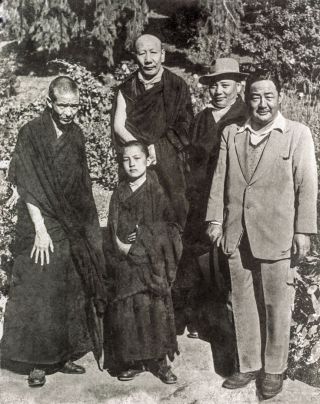
A young Lama Zopa Rinpoche with the 6th Yongzin Ling Rinpoche (1903 – 1983), senior tutor of His Holiness the Dalai Lama. Photo courtesy of Lama Yeshe Wisdom Archive.
Mackenzie: Rinpoche was one of her pupils, who she plucked out of the Buxa Duar refugee camp when he was young and very sick. Rinpoche is always talking about her, so I drew on what I had heard from him. I sometimes wonder if Lama Yeshe wasn’t bowing to her at Kopan partly because she had looked after his heart disciple.
One very important interviewee was Akong Rinpoche, who talked to me at Samye Ling, Scotland, just before he was tragically killed. Freda had “adopted” him in 1960 along with Chögyam Trungpa Rinpoche. I interviewed people who had worked with her at the Young Lamas Home School, which she established in 1960. I talked to the volunteers who knew her at the school, and Indians who knew her socially, friends of her family. I interviewed Gelek Rinpoche, who had lived with her in Delhi as one of her pupils. With great difficulty, I tracked down her devoted nun assistant—a very feisty character. I found the nunnery that Freda established in India and talked to the nuns who had known her. They were utterly devoted to her, and kept her room locked up as a shrine. I interviewed Tibetan officials who knew her when the Tibetans came into exile, her niece in England, Pema Chödrön, Joanna Macy, and Jetsunma Tenzin Palmo, who very kindly wrote the foreword to the book. It was like trying to piece together a giant jigsaw puzzle. It took me six or seven years. It was very, very difficult to get a comprehensive picture of this extraordinary woman because she was involved in so many activities.
Mandala: You mentioned that she lived many lives. Tell me more about that.
Mackenzie: Freda won three scholarships to Oxford. She was mega-bright. Curiously, she was determined without actually being ambitious. She didn’t necessarily want to go to Oxford. A school friend’s family asked Freda to study with their daughter to encourage her as she wasn’t very bright. At the last minute, Freda decided to take the examination too. Ironically, Freda got a scholarship and her friend didn’t.
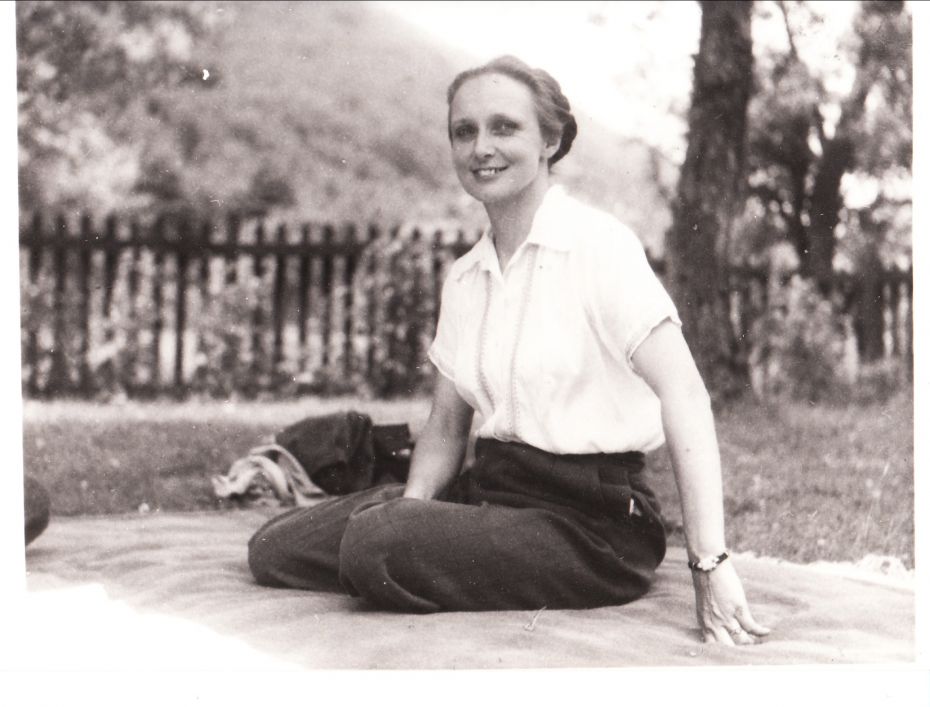
The young, in-love Freda at Oxford, England, 1932. Taken by her fiancé, Baba Pyare Lal Bedi. Photo courtesy of Bedi family archives via Shambhala Publications, Inc.
Oxford opened up a whole new world for the provincial Freda. There she met a charismatic Sikh called Baba Pyare Lal Bedi who was the sixteenth direct descendant of the founder of the Sikhs. He got her into Marxism and the Indian independence movement. She met Gandhi, who lectured there, and was deeply impressed. She married Bedi, who warned her that she would spend a lot of her married life waiting outside prison walls, which turned out to be true. So returned with him to India and joined Gandhi’s peaceful resistance movement against the British. At the same time she was a professor, journalist, and mother. Freda helped to rouse the Indian people with her amazing oratory; she was extremely articulate in Gandhi’s cause. Gandhi chose her personally to be what is known as satyagrahi, one of those willing to go to prison and even die for the cause. Of course she was duly arrested, and became the first British woman to be imprisoned for insurrection. After that, she became a heroine in India.
But right from childhood she was a spiritual seeker. She would go to church to try and meditate before school. And she read everything she could on the East. While she was at university and then in India, she explored every kind of spirituality she could, very diligently. She read all of the Koran, the Torah, explored Sikhism and Hinduism. And she continued to meditate and do yoga and had some profound spiritual experiences. But there was no Buddhism in India at that time.
She also had a strong social conscience and innate compassion. She was desperately keen to help anybody in need and she hated, hated inequality and suffering of any kind. So after India achieved independence in 1947, she threw herself into working for the refugees who arrived due to the partition of India and Pakistan. There was a bloodbath at the time of partition, if you recall, with traumatized refugees on both sides of the border. So she became a social worker, always working for the poor, especially the rural poor. At the same time she mixed with the great and the good. She knew Indian Prime Minister Jawaharlal Nehru and his daughter Indira Gandhi. She knew Lady Edwina Mountbatten, who was the wife of the last British viceroy of India. The Bedis knew all the leading writers, artists, and politicians and were a celebrated couple at society’s top cocktail parties.
Nehru sent Freda to Burma in 1952 on a UNESCO mission. While she was there, she encountered Buddhism for the first time and learned vipassana meditation from Mahasi Sayadaw and Sayadaw U Titthila. She had a kind of awakening experience. She was never the same after that.
And then Nehru sent her, in 1959, to look after the Tibetan refugees in India when His Holiness came into exile. She saw all these refugees, and was working day and night, day and night, to help them, and she saw in them all a spiritual quality she had never seen before. And that was it. It was the tulkus who impressed her the most. She recognized that it was the tulkus who would bring Buddhism to the West. At the time, nobody else was thinking along those lines. Only Freda saw it. Everything was in such disarray. She met Chögyam Trungpa Rinpoche and Akong Rinpoche, and felt a deep affinity with the two of them. She took them into her house in Delhi to live with her family.
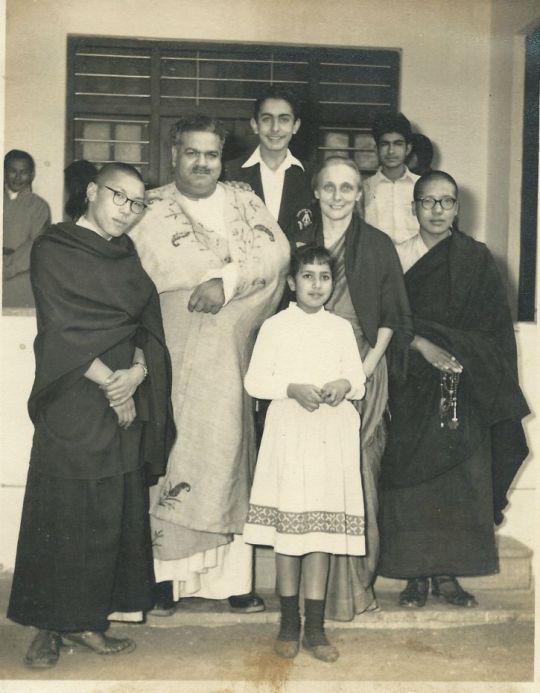
1960. Freda Bedi with family members: her husband Baba Pyare Lal Bedi, her son Kabir, and her daughter Guli on the steps of their small Delhi flat with newly “adopted” family members, Chögyam Trungpa Rinpoche and Akong Rinpoche, found by Freda in the refugee camps. They lived together for several years. Photo courtesy of Bedi family archives via Shambhala Publications, Inc.
Following her hunch, Freda set up a school for the young rinpoches. It started in Delhi with Nehru’s permission and help. And His Holiness supported it. He thought that the most important thing for the young rinpoches was an education. Later she moved the school to Dalhousie and Lama Zopa Rinpoche, who had tuberculosis at that time, went there. He was so keen to learn English. And Freda Bedi found him sponsors, and got him robes and medicine.
Mandala: Tell me a little bit more about the school.
Mackenzie: It was nonsectarian. Freda was never interested in divisions so it was open to all the schools of Buddhism. She taught the tulkus herself, and she commandeered passing Westerners as well to teach English and Western topics. Tibet had been completely isolated, and the young Tibetans didn’t know anything about the outside world. She knew that she had to give them a more comprehensive education. But they also did their prayers and practices according to their own traditions. She was constantly fundraising and getting sponsors for them. She never ever had any money and was totally non-materialistic herself, but she was a very powerful woman, with a great intellect and tremendous connections with the most powerful people in India.
Mandala: And she did some work for nuns as well?
Mackenzie: She established the first nunnery in exile. She really, really believed in the equality of women. In fact, in the exile community, the nuns got their first nunnery, Karma Drubgyu Thargay Ling, before the monks got their first monastery. And it’s still going. On a personal note the sixteenth Karmapa Rangjung Rigpe Dorje encouraged her to become the first fully-ordained Tibetan Buddhist nun of any nationality. It was yet another historical milestone she clocked up. She was the first gelongma, which helped pave the way. Tenzin Palmo followed and so did all the others. It’s amazing, isn’t it?
Mandala: I understand she did some translation.
Mackenzie: She was an ace at languages. She just had a knack. She had studied French; that’s what got her into Oxford. She learned Hindi and Tibetan, and she was translating texts very early on. That was one of her first jobs, which she was doing on the side. She was one of the first translators of Tibetan texts.
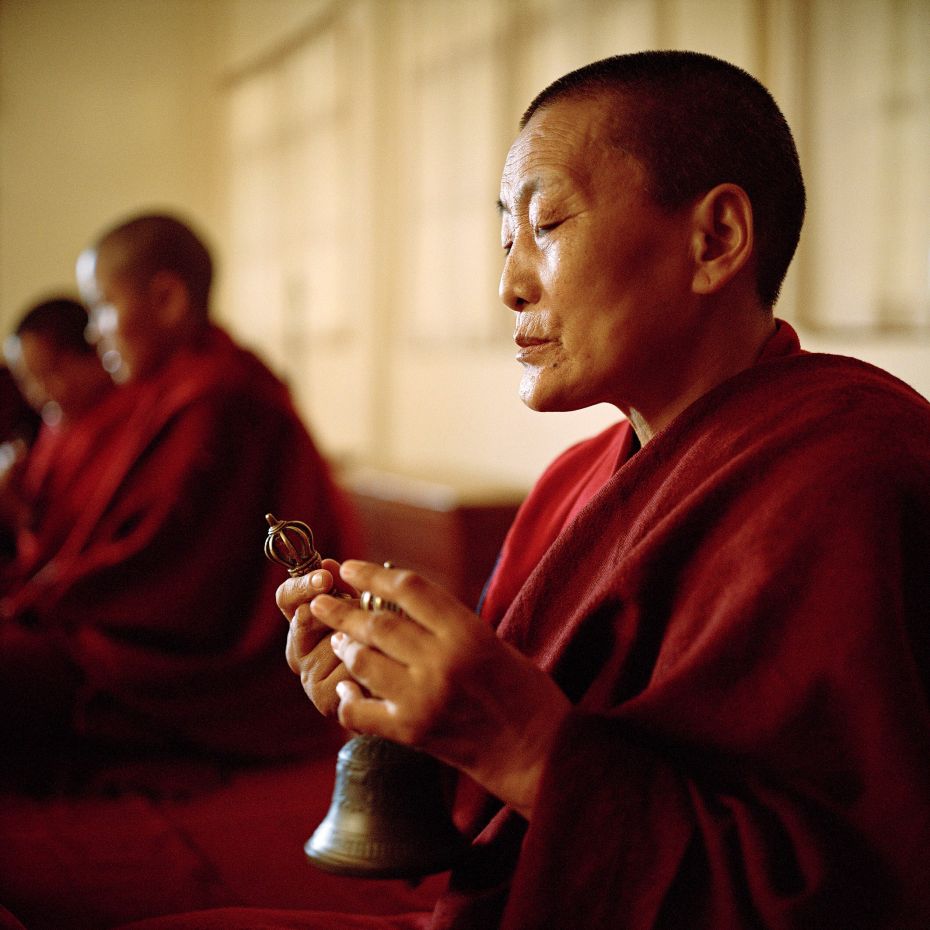
Kagyu nuns, India. Photo by Olivier Adam.
Mandala: Her commitment to helping others meant her family missed her at times.
Mackenzie: Missed her because she was away a lot and when she was at home they had to share her. You know, she was called “Mummy-la” by the Tibetans. They all called her Mummy-la and she sort of saw herself as a universal mother. And the Tibetans, most of them, regarded her as an emanation of Tara. But her own children, I think, often took second place. So I explore that in my book as well: the discrepancy between universal mother and actual mother at home cooking meals and generally putting her children before anything and anyone else. Freda never did that! I think it’s often an issue women face. Our myth of motherhood is very strong. Freda undoubtedly loved her children and they loved her, but she also had her eye on the bigger picture.
Mandala: Her work has had long-term impacts, hasn’t it?
Mackenzie: She got Trungpa Rinpoche a scholarship to Oxford. And he went on from there to America where his impact was enormous. He and Akong Rinpoche established the first Tibetan monastery in the West, in Scotland, Samye Ling. I don’t think you can overestimate the influence of these two lamas. And Lama Zopa Rinpoche’s global influence is inestimable. Freda mentored many other tulkus like Thartang Tulku and Gelek Rinpoche, all of whom have contributed a colossal amount. Freda’s role was pivotal.
And she persuaded the sixteenth Karmapa to go on his first tours to Europe and America. She did that personally, because she was his close disciple, living in a room just beneath his in Rumtek, and he listened to her. She said to him, “The West definitely is ready, go, please, please, they are ready, give them the Dharma.” She arranged for him to meet the Pope. She went with him, organizing all the way and acting as his intermediary.
Mandala: Was she a serious practitioner?
Mackenzie: Yes, which surprised me. I don’t know when she found the time to practice. I discovered that, while she was on these tours to South Africa and America, she was conducting high initiations with the permission of the Karmapa. So she must have been an extraordinary practitioner. And the Karmapa told her assistant, the nun who was with her all the time, that she was an emanation of Tara. She was doing these extraordinary empowerments. Her explanations were exceptionally profound and very clear. In the book, I have tried to put in, especially for Buddhist readers, excerpts of talks she gave while she was doing the overseas tours, both on the radio and live. It seems that she had a high understanding of the Dharma.
And her devotion to the sixteenth Karmapa was absolute. She didn’t have to learn guru devotion. Her first meeting with him was remarkable. While she was working with the Tibetan refugees, they told her she must go and meet the Karmapa, who had just arrived. It was a long journey on horseback, and she didn’t really know who he was. But she trekked up to see if she could help him. And he revealed himself to her as the Buddha. He was instantly her heart guru. Her devotion to him was so absolute that it annoyed her daughter, who was brought up by her mother to be an independent woman. “Whatever are you doing obeying everything he says? I thought you were an intelligent, liberated woman!” That was her daughter’s view.
Mandala: As a woman, she was quite radical, wasn’t she? For example, she was the primary income earner in her family.
Mackenzie: Yes, her husband had a devil-may-care attitude that life would take of itself. And he was in prison too, for years, because of the struggle for Indian independence. So she was the main breadwinner. She didn’t seem to mind. She worked so hard. All the time, work, work, work. And I think she and her husband believed in freedom of choice for both of them actually. It was radical, yes. The Bedis were a remarkable family. Very advanced, very enlightened. They welcomed Freda into their midst, for example, and treated her like a daughter, even though she was British. They were very special people, her in-laws. She loved them, and they loved her. Her husband’s mother lived with them when she was old and they looked after her. Really, they were all characters.
That’s something I tried to explore in the book. I didn’t want to do a hagiography. I wanted to show the reality. And Freda was big character, and complex. And in a way she was “called.” Her life had, like Jetsunma Tenzin Palmo’s, a trajectory, even though Freda didn’t meet her guru, her path, until she was middle-aged, by which time she had had an extraordinary life already. She had tasted everything. Career, being a wife, a mother, a socialite, cocktail parties, political activism, jail. But all the time she was always on this trajectory to bring about a better world, to eliminate suffering.
She is an icon in the transmission of Buddhism to the West, an icon. And yet, she has remained fairly unknown. Why has her song never been sung? His Holiness was right. Her story deserves to be told. There was even a hint in her letters that it was through her contacts with Nehru and his daughter Indira Gandhi that Nehru was persuaded to take His Holiness in, to let him settle in India. That’s in the book. It’s just hinted at, but she could have been an important influence in that momentous decision. Maybe Lama Yeshe was aware of this other role she may have played too.
Then she kept working and working even though her health was never good. On her last tour you can hear on the recordings of her teachings that she can hardly breathe. She was exhausted, physically wrung out—you can hear it. But she kept on going. Apart from teaching and touring, she was still running organizations and getting sponsors for Tibetan causes, refugee camps, and families: she kept that going by endless letter writing. How she did it all, I just do not know. She crammed a lot in!
Mandala: How did writing the book impact you?
Mackenzie: It’s exhausted me. [Laughs] It has been a long haul, weaving all these strands together and hopefully making her come alive to the reader. I also feel tremendously honored to have spent time with her in this way. She did so very much for India, for Tibetans, for the Dharma, for women. She amazes and inspires me. I feel such gratitude for all she did.
She has been a student of Lama Thubten Yeshe and Lama Zopa Rinpoche since 1976.
Mandala is offered as a benefit to supporters of the Friends of FPMT program, which provides funding for the educational, charitable and online work of FPMT.
- Tagged: freda bedi, in-depth stories, india, interview, lama zopa rinpoche education, vicki mackenzie, women
9
The Benefits of Monasteries and Nunneries
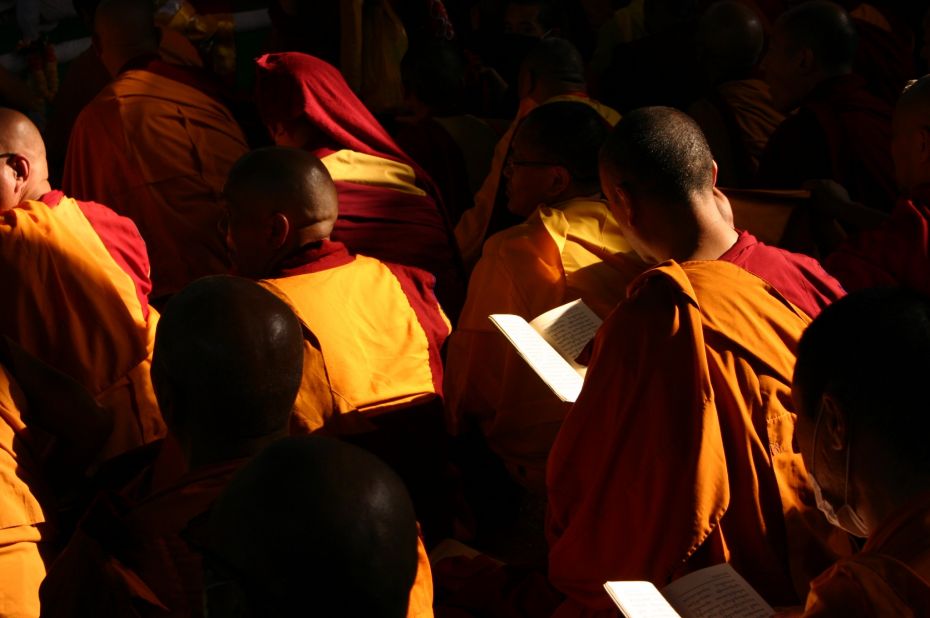
Monks attending the Kalachakra in Bodhgaya, India, January 2017. Photo by Cynthia Karena.
Are monasteries and nunneries necessary? Lama Zopa Rinpoche recently answered the question with a resounding “Yes!” and explained some of the benefits of monastic communities. The question was also examined by Ven. Tenzin Legtsok, an American monk in the geshe studies program at Sera Je Monastic University. He wrote a detailed response in an article called “Guardians of the Way: The Importance and Benefits of Monastics Living Together” published in the newsletter of the International Mahayana Institute (IMI), FPMT’s community of nuns and monks. Since Ven. Legtsok’s analysis complements the precious words of Rinpoche, Mandala has drawn on both sources to describe why monasteries and nunneries remain important in today’s world.
“When Prince Gautama first took up the life of a wandering mendicant,” wrote Ven. Tenzin Legtsok, “he initially sought instruction from several renowned teachers of the day. It is recorded that during this time he lived and practiced near these teachers among groups with other trainees. At the time of the Buddha, most of his ordained followers lived together in order to receive guidance from Shariputra, Maudgalyayana, and other senior disciples. Until today nearly all monastics in the Theravada and Chinese Buddhist traditions live within monastic communities. The vast majority of Tibetan and Himalayan monks and nuns live as part of one or another monastic community. Yet precious few communities of Western Buddhist ordained people have arisen.”
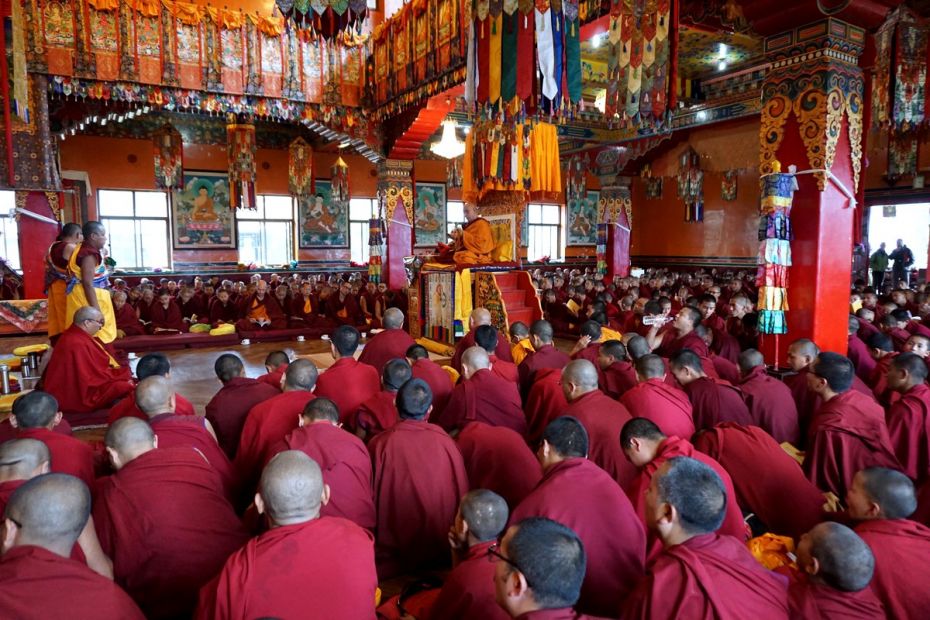
Jangtse Chöje Lobsang Tenzin Rinpoche leading prayers at Monlam, Kopan Monastery, Nepal, March 2017. Photo by Ven. Lobsang Sherab.
There’s the rub: Western monks and nuns may keep in touch online, regularly meet with other monastics, or stay at Dharma or retreat centers, but many do not live in “brick-and-mortar” monastic communities. This sometimes has to do with the lives of the individuals themselves and sometimes with a shortage of monasteries and nunneries. As well, modern Buddhism is largely oriented toward lay practice and Dharma centers, which means that lay support for monastics is at times in short supply. Unfortunately, not everyone sees the point of monasteries and nunneries nowadays.
Lama Zopa Rinpoche, however, does see the point, and has described more than once the benefits of monasteries and nunneries for Sangha, lay people, and the Dharma. In 2009, Rinpoche said, “A monastery means two things. One is having holy objects for people to purify the mind, collect extensive merit, and have realizations of the path to enlightenment. Second is especially for monks and nuns to live there in their vows, in retreat away from the city and the distractions to their vows.” His focus, therefore, was on two factors: first, the benefits to visitors—mainly lay people—who see holy objects, make offerings, and so on, and second, the need for a supportive place for monastics to live in their vows.
Rinpoche’s more recent advice, given in 2016, reiterated those two points as well as referencing a third: the important role monastic communities play in preserving the Dharma.
On the latter issue, Rinpoche explained: “The Buddha came approximately 2,800 years ago, and the Buddhadharma still exists. This is because of monasteries and the education they provide. In Tibet, the complete Buddhadharma existed, meaning the Lesser Vehicle teachings as well as the Mahayana sutra and Mahayana tantra teachings. These were taught by Buddha, came to Tibet from Nalanda, and were preserved and disseminated in full. If people had become monastics but just stayed in the fields or on bare mountains, like monkeys, then this would not have happened. It is entirely due to monasteries that this happened.” Thus Rinpoche underlined that not just individual ordained Sangha are needed, but also communities of Sangha living together.

Lama Zopa Rinpoche and Ven. Lozang Yönten, Russia, 2015. Photo by Ven. Tenzin Chodron.
Rinpoche then focused on the need for monastics to live in conducive circumstances and the benefits of them having this opportunity, saying, “Without monasteries, the Sangha would have no place to live together, no place to do practice, to study. They can’t just live on the bare mountains or in the fields, without any shelter. Monasteries are normally not in the city, but away from the city, away from distraction. And those living in monasteries are not just away from distractions but also have their monastery’s rules and the discipline of vinaya to protect their minds. The main purpose of monasteries is to subdue the mind, to keep the mind in peace, in Dharma, to keep away distractions, which are causes of attachment, anger, and so forth. So monasteries are built away from cities, in isolated places, away from obstacles. It is like this so monks and nuns can live in their vows better. Monasteries help them do this.
“In Tibet, the Nyingma, Kagyu, and Sakya put in place many monasteries. Then Lama Tsongkhapa came and established Ganden Monastery. His disciples established Sera Je and Mey, then Ganden Shartse and Jangtse, and Drepung Loseling and Gomang. These are just the main monasteries, but there are many others. In these monasteries, you can study sutra and tantra in depth, like the Pacific Ocean so, so deep, so vast. Even for Mongolians it was the best place to come and study. There were so many Mongolians studying in Tibetan monasteries and becoming geshes. They studied all of Lama Tsongkhapa’s teachings, the whole lamrim, and they knew the great Lamrim Chenmo by heart. Then they went back to Mongolia and created monasteries there, branches of Sera, Ganden, Drepung, and so on, which gave monastics there a place to practice and study, so those monastics didn’t have to live in the fields or on the bare mountains. The benefit was unbelievable, unbelievable, unbelievable.”

Debate at Sera Je Monastery. Ven. Tenzin Gache answers questions from his classmates Vens. Losang Tsering, Losang Dorje, and Jamyang Dorje, India, 2015. Photo by Sera Je A/V Dept.
Rinpoche then pointed out that monastic communities do not just preserve the Dharma and provide a place for monastics, but also help lay people directly and immediately. In this regard, he explained that, “In Tibet and Mongolia, those outside the monasteries were able to collect merit by coming to the monasteries and making offerings. By building the monasteries they collected so much merit. In this way lay people collected unbelievable merit by making offerings to the Sangha, requesting or doing practices, making offerings to holy objects, etc. Then they also sent many of their children to the monasteries to be educated. The Buddha said that building shelters for monks and providing for their needs creates eons of merit, and this is merit that increases and cannot be exhausted. In the Mindfulness Sutra it says that even in hundreds of eons one cannot come to the end even of explaining the merits and benefits, they are so unbelievable, unbelievable, unbelievable. Buddha said in that sutra that whoever has arranged for the needs of the Sangha will always have more and more virtue. That virtue can never be used up even in ten million thousand eons.”
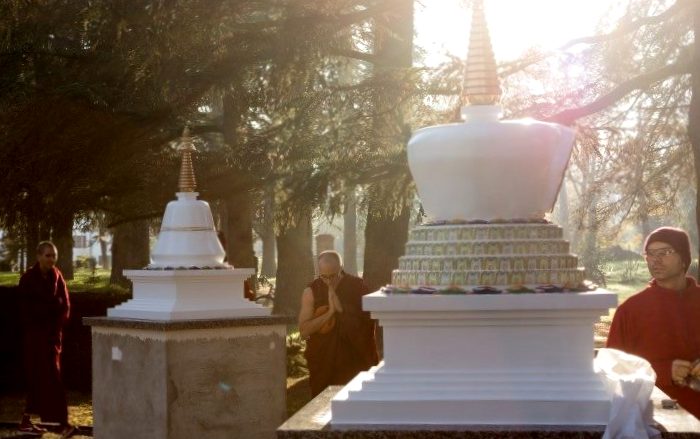
New stupas at Nalanda Monastery in France on their day of consecration, December, 2016. Photo from Nalanda Monastery via Facebook.
Rinpoche continued to describe the great merit that lay people can collect by helping to build monasteries or create holy objects, saying, “Here are some of the benefits if you help create monasteries, gompas, and holy objects such as statues, stupas, and scriptures, in which abide Buddha, Dharma, and Sangha. However many atoms the object has, for that many eons you become a universal king. And when there is a universal king in the world, there is so much good fortune for everyone. People are able to live in the ten virtues and there are other incredible, incredible benefits. And being a universal king is just along the way, because ultimately you will attain enlightenment. That means you exhaust all the mistakes and complete all the realizations, and you free numberless sentient beings from the oceans of samsaric sufferings and bring them to peerless happiness. That is the meaning of sang-gyä (Tibetan for “buddha”): the total cessation of all obscurations and the completion of all realizations.”
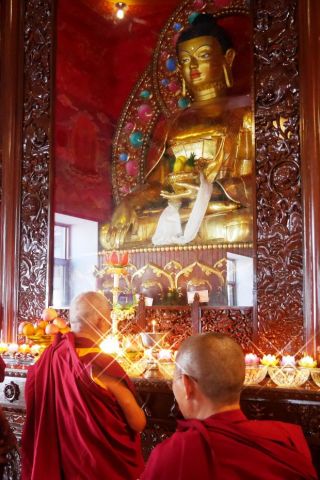
Lama Zopa Rinpoche pays respect to holy images at Kopan nunnery, Nepal, February 2017. Photo by Ven. Holly Ansett.
“As well,” he summed up, referring to both lay people and Sangha, “monasteries and gompas where there are holy objects of the Buddha, Dharma, and Sangha—statues, stupas, and scriptures—are called ‘abiding places’—nä-khang in Tibetan. What is abiding is the Buddha, Dharma, and Sangha. So an ‘abiding place’ is a great, great place to subdue the mind, collect extensive merits, and achieve enlightenment. Even the name nä-khang is incredible.” In this way, Rinpoche emphasized that monastic communities benefit everyone, lay and ordained.
Rinpoche went on to explain that Dharma centers for lay people also have many benefits, but they do not replace monasteries. He said, “Centers where there are resident teachers, where people come to listen to the Dharma, to study Dharma, to meditate, to collect merit, to purify defilements, to take refuge, to generate bodhichitta, and to dedicate practice for all sentient beings also have unbelievable benefits. There, you can learn compassion and bodhichitta. Each time you practice there, you help the six realms’ sentient beings by dedicating, not leaving out even one. Not one ant or one maggot or even one slug is left out; all your practices are dedicated for them. You practice Dharma there for them.” But Rinpoche did not suggest that centers have the same role in preserving and spreading the Dharma as monastic communities, or in giving ordained Sangha a conducive situation to study, practice, and live in their vows.
Rinpoche concluded by saying that his words were “just a drop, not much, just a drop of the benefits of monasteries” and passed on the following quote that he translated from a life story of the Buddha:
Abiding in the house there will be happiness
And one will have contemplation
And great insight and so forth
By offering monasteries and temples to ordained Sangha.
And this is admired by the buddhas.
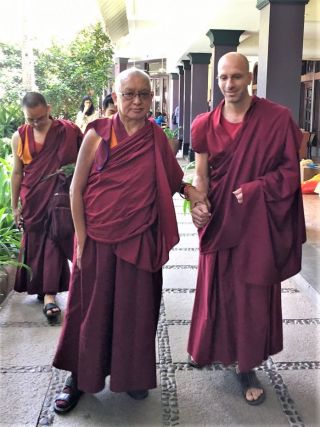
Lama Zopa Rinpoche and Ven. Tenzin Legtsok, Bangalore, India, December 2016. Photo by Ven. Holly Ansett.
Ven. Legtsok echoed Rinpoche’s themes in his article, which he wrote in response to discussions about whether virtual communities for Sangha can replace physical ones. He first described why living together in community is essential for training monastics and preserving the Dharma, writing, “Every instance of suffering ever experienced by any sentient being has arisen from ignorance grasping at an inherently existent self. … Knowledge of this wisdom realizing selflessness, ultimate truth, and how to use it to eradicate suffering from the root is extremely rare and precious. So long as there are groups of people in the world who keep the knowledge of this truth alive, there is a way for others to gain freedom from suffering. A passageway is held open. … When there are no longer people who keep this truth alive, then the door, the only door, from a realm of darkness into a realm of light, has closed.
“Buddhist teachings are unique in the clarity with which they define and explain how to train in wisdom realizing selflessness to overcome afflictive emotions, their stains, and even obscurations to omniscience. … Groups of monks or nuns who devote their lives to upholding this truth are … called the Sangha because, by living in the pratimoksha vows, they are similar to, and follow the way of life deemed best by the arya Sangha. Where such an ordained Sangha exists, ideally the teachings of Shakyamuni Buddha are upheld. Where the teachings of the Buddha are upheld, there is a way for people to come to know how to free themselves from suffering.
“Although this path is open to all, through the ages it has been the responsibility of the ordained Buddhist Sangha to devote themselves wholly to training in, realizing, and teaching this path to subsequent generations. Thus the existence of a Buddhist Sangha is of inexpressible importance not just for ordained people but for the entire world.”
Hence, wrote Ven. Legtsok, Sangha living in their vows are crucial to sustaining the Buddha’s teachings, so that everyone can continue to access them. But why, he then asked, must they also live together in monastic communities?
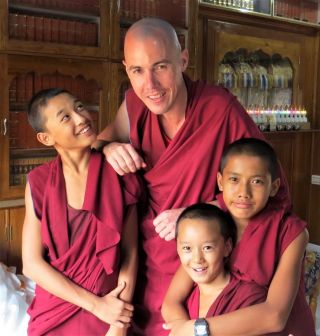
Ven. Jampa Khedrup with young house-mates, Sera Je Monastery, India, May 2016. Photo by Sonam Nyima.
“To fully inherit the torch of Dharma from previous generations,” he explained, “junior monastics must learn from knowledgeable elders. In order to make the Dharma available for future generations, elders must offer their guidance and insight gained through experience to juniors. This transmission requires a profound level of face-to-face communication among many people over extended periods of time. Moreover, transmission of wholesome values happens in an entirely organic fashion, based on juniors watching and learning from the uncontrived actions of dedicated elder monks and nuns. Individuals living alone lack access to such an organic process, and their growth will be stunted. If the continuity of this stream of communication declines and breaks, future generations will lack living examples of people wholeheartedly striving for liberation and enlightenment, not to mention those who’ve achieved it, and will thus find it extremely difficult to discover and believe in the possibility of liberation or the path to it.”
Speaking from his own experience of monastery life, Ven. Legtsok continued, “Some further advantages of being part of a monastic community are: we are directly part of something bigger then ourselves by contributing to the life of a community that has the potential to benefit many people in a profound way. We gain the companionship of friends who share our deep commitment to spiritual development in the Buddhist path. We have access to more teachers, teachings, and role models then if we live alone. When we have questions or wish to discuss our doubts, others with the relevant knowledge and experience are close at hand. As we develop, we have opportunities to support other monastics in their practice and studies.
“At different periods in our monastic life, the community we live in benefits us in different ways. As a newly ordained person it trains and informs us how to wear the robes, how to keep the vows, how to skillfully deal with different situations, and offers us role models of people who have been able to keep their vows well for a long time. When we engage in meditation retreats it helps provide for us. When we become weak with sickness or old age, the community looks after and nurses us. When we die, our fellow monks and nuns pray for us. In dependence on others in the community we even create causes to have close companions on our spiritual path in future lives.

Nuns of Chenrezig Institute. Back row from left: Vens. Lozang Tsondru, Thubten Damcho, Lozang Tseten, Lozang Rigsal and Lozang Wangmo. Front row from left: Vens. Lozang Tsultrim, Gyalten Tsultrim, Tenzin Palyon, Thubten Tongnyi and Thubten Pema. Chenrezig Institute Gompa, Australia, November 2016.
“When we are studying, a monastery or nunnery offers us the opportunity to study with more supportive conditions and fewer obstacles. Mundane tasks like shopping, cooking, cleaning, and maintenance, etc., are shared by all, freeing up much time and mental space. By studying the Dharma in a community, especially a large one, we are exposed to more well qualified teachers and students with a broad range of ideas and perspectives, deepening and enriching the quality of our learning. The greater our wisdom of hearing, the greater our wisdom of contemplation will become, and accordingly the greater will be our wisdom gained through meditation.
“Recognizing such benefits, monastic scholars of the past naturally formed major communities of study and practice, like Nalanda and Vikramashila in India, and the ‘Three Great Seats’ [Ganden Monastery, Sera Monastery, and Drepung Monastery] in Tibet. The great yogi saint, Shabkar, said that the Three Seats where the most powerful objects of offering in Tibet. His Holiness the Dalai Lama and Lama Zopa Rinpoche often comment that without the Three Seats and the two tantric colleges it would be nearly impossible to produce individuals with a broad, deep, and accurate understanding of both sutra and tantra. … To contribute to the thriving of such a community is profoundly meaningful. Having the opportunity to be part of one is something to treasure.”
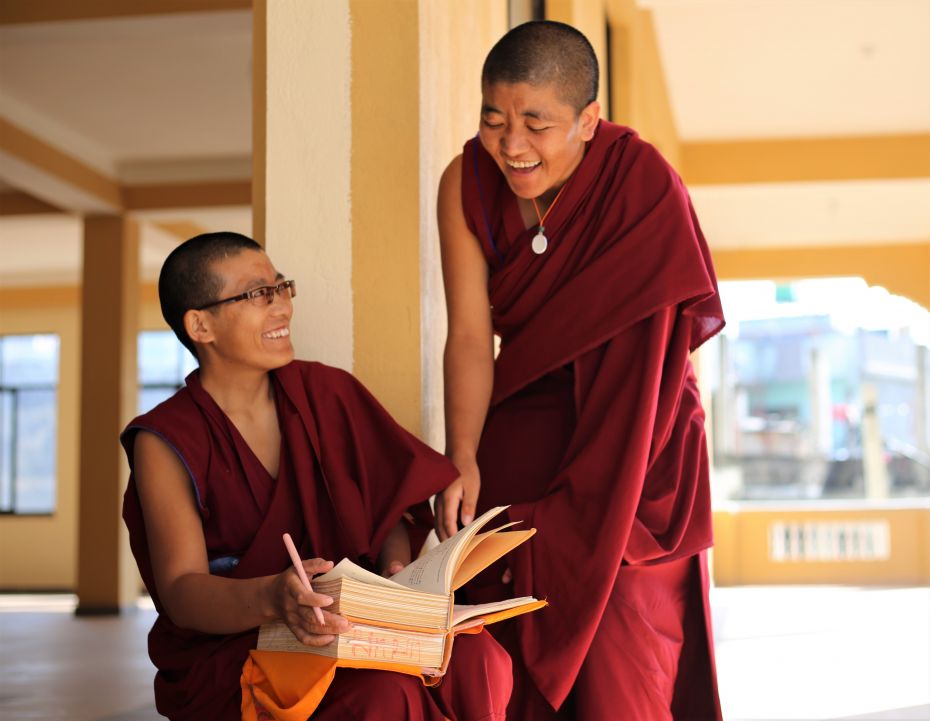
Kopan nuns Vens. Lobsang Rigzin and Lobsang Namdrol memorizing, 2017. Photo by Ven. Tenzin Tsomo.
It is not always easy to live in a monastery, admitted Ven. Legtsok, saying, “I suspect that because they are powerful virtuous objects, monastic communities cause uncommonly strong purification to happen!” He concluded on a personal note: “The first few years at Sera were one of the most difficult times in my life. Having stayed on despite the difficulties, now I sometimes think it is as close to a pure land on earth as I could find. There’s no other satisfaction like quietly sitting in my room in the late afternoon reading profound passages from a Dharma text, going to debate them in the evening with classmates, and then further reflecting on their meaning as we slowly chant the Heart Sutra and other prayers under the vast night sky. At such moments I often pray that in the future many others will be able to experience this way of life.”
Given the benefits of monastic communities, we can add our prayers to Ven. Legtsok’s—and ponder our own role in helping monasteries and nunneries to thrive.
Compiled and edited by Mandala associate editor Donna Lynn Brown.
Contribute to the needs of ordained monks and nuns through the Supporting Ordained Sangha Fund.
Mandala is offered as a benefit to supporters of the Friends of FPMT program, which provides funding for the educational, charitable and online work of FPMT.
- Tagged: advice from lama zopa rinpoche, donna lynn brown, in-depth stories, international mahayana institute, monasticism, ven. tenzin legtsok
24
In the Footsteps of Atisha: A Pilgrimage to Vikramashila
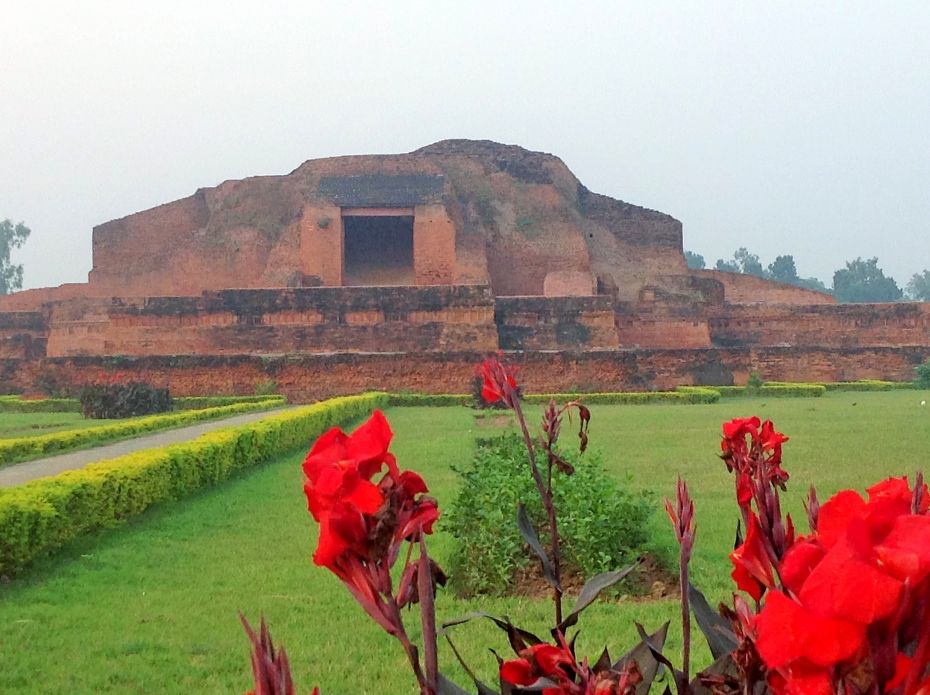
The main stupa of Vikramashila monastic university, destroyed approximately 1200 C.E. India, October 2016. Photo by Annie McGhee.
Pilgrimage needs faith. The more faith, the more happiness. Otherwise, you are just like a tourist looking at ruins. … When you go to these holy places it reminds you of impermanence. Once these places were great cities but now there are just stones. A thousand years ago these places were quite different. But even though there are just stones now these stones are so precious. — Lama Zopa Rinpoche
In October 2016, Ladakhi Lama (Ven. Thubten Tsewang), a former attendant of the great Khunu Lama Rinpoche (1894-1977), led a few people from Root Institute in Bodhgaya, India, on a pilgrimage. Ladakhi Lama, who used to live and teach in Mumbai, India, now resides in Bodhgaya. The group traveled to the ruins of Vikramashila, a one-time monastic university where the great master Atisha lived and taught. For centuries, Vikramashila and Nalanda were the two most important centers of Buddhist learning in India.
Annie McGhee reports on the trip:
I had long wanted to go to Vikramashila. I am passionate about pilgrimage to holy places, and I have been several times to the remains of the great monastic university of Muara Jambi in Sumatra, Indonesia, where Atisha spent twelve years with his precious teacher Serlingpa. So I feel a strong connection to Atisha, and Vikramashila, after all, is renowned as Atisha’s home monastery. Yet I had hesitated to go there on my own; travel in that part of India’s Bihar State can be unsafe. While staying at Root Institute, I made sincere prayers that I would find a way to go, and mentioned my hope to only two friends. I was overjoyed when suddenly Lama-la offered to lead a few of us there in an unofficial way. How exciting it was that not only would it happen, but also that Lama-la wanted to come, despite the distance and rough traveling conditions.
Vikramashila is located about 300 kilometers (185 miles) east of Bodhgaya, in what was once the famed kingdom of Magadha, where the Buddha lived. Leaving by jeep at 4 a.m., the journey on bone-jarring roads took us almost ten hours. We passed through desperately poor rural villages whose mud huts, clustered together, seemed to be crumbling back into the earth from whence they came. Clusters of cow dung chapatis, a source of fuel, clung to their walls. Young girls walked with babies on their hips. Between the heavy traffic of the towns, the more open roads of the countryside were lined with fields of rice, wheat, sugarcane, potatoes, and chili, all dotted with haystacks and brickworks. Huge oxen lumbered by, pulling carts loaded with impossibly high tiers of hay; small trucks brimmed with children and women dressed in a cacophony of multi-colored saris. Buses hurtled along, horns blaring, crammed with people, with many more sitting precariously on their roofs. Shops selling fruit and drinks appeared every so often, and the smoke from the charcoal braziers of chai stalls mingled with the ever-present dust. Old men with mahogany faces and hennaed hair gathered in little groups, chatting and smoking bidis. We saw a few small mosques with men in white haji hats signifying that they too had been pilgrims; in their case to Mecca.
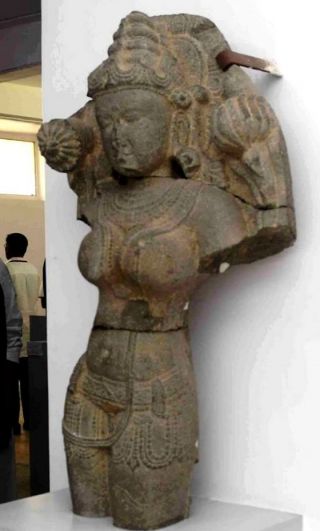
Tara statue at Vikramashila museum. Photo from Vikramashila museum via FB.
We arrived at Vikramashila around 2 p.m. and went immediately to the museum. There, we recovered from the road trip with a serene picnic on manicured lawns edged with flowers. We found the museum worth a visit. It displays hundreds of statues and other objects excavated from the site, from what looked like copper and stone malas to cooking implements to small metal statues of deities (predominantly Tara), very fine in craftsmanship and similar to old-style Nepali statues. One beautiful, nearly life-size Tara had been exquisitely carved out of polished black basalt, with the detail of her lower robes depicting mandalas interspersed with leaf and flower motifs. Sadly, the statue was headless and armless due to damage at the hands of the Turkish forces that conquered India and destroyed Vikramashila (as well as Nalanda) around 1200 C.E.
After a visit to the museum, we explored the grounds of the ancient university itself. As we entered, we saw the remains of many votive stupas. Lama-la quietly remarked that they might be all that was left of stupas that held the relics of the 108 arhats who resided at Vikramashila. We walked toward the main temple along a processional way where the remains of huge granite pillars, some over a meter (3 feet) in circumference, once supported the gatehouse roofs.
From there, we came to a vast quadrangle where the main temple once stood. The quadrangle was reputed to have been able to hold 8,000 monks. Around it on all four sides, excavations have unearthed the monks’ cells. There were 208 cells, fifty-two on each side, that opened onto a common verandah, which had steps descending into the quadrangle. We saw round tower-like projections on the buildings’ corners, and smaller projections on the sides, about 24 meters (80 feet) apart. Were these the “the golden spires shining in the sun” that ancient Tibetan accounts mention being sighted from afar by delegations approaching Vikramashila?
Within the quadrangle, the remains of the main central temple show it was a cruciform-shaped mandala. In its day, it was a multi-storied complex, around 14 meters (46 feet) in height by 23 meters (75 feet) in length, encircled by two levels of paths for circumambulation. Four open sides at the center of the mandala faced the four cardinal directions, and may have housed images of buddhas. Three of the sides were only partially excavated, so we sat on the only fully excavated side, the east, where there would once have been a statue positioned on the still-present wide brick platform. The faint remains of stucco told us that there might have been painted frescoes on the back wall, long gone now. We thought we could see an outline, faintly etched on the wall, of a very large buddha.

Ladakhi Lama offers a prayer at Vikramashila, India, October 2016. Photo by Inder Kaant.
Here we sat silently, contemplating the greatness of the masters who had come before us and shown us the way, and praying to be like them. Lama-la led us in refuge and bodhichitta prayers, and we recited the Heart Sutra, King of Prayers, Praise to Lama Tsongkhapa, Calling the Guru from Afar, and the long life prayers for His Holiness the Dalai Lama and Lama Zopa Rinpoche. One of our group was Pema Tse, the new principal of Maitreya School in Bodhgaya, and he recited a moving prayer he had composed about finding the meaning of life through teaching children. Finally, we recited Remembering the Kindness of His Holiness the Dalai Lama and the Tibetan People. This was composed by Lama Zopa Rinpoche in support of His Holiness’ wishes, the Tibetan people, peace and happiness in the world, and sentient beings attaining enlightenment. It was tremendously moving to contemplate and pray like this, led by Lama-la, in such an inspiring place!
We continued to explore, examining a large rectangular structure in the southwest corner of the monastery. Archeologists have identified this as the library. It had an ingenious natural air conditioning system, utilizing long, narrow reservoirs of water along the outside edges of the building. Cooling breezes would have blown over the water into the library via wall vents. As the manuscripts were written on mulberry or palm leaves, this would have helped preserve them in the monsoons and the fierce summer heat. The remaining broad foundations of the building suggest it may have had several stories. The library was destroyed by fire during the conquest; like Nalanda’s library, it is said that the fires burned for months. It must have held so many precious texts—how sad to see only stones remaining.
We saw other evidence of destruction. On the central temple complex, many areas of the double brick construction of the structure were still visibly blackened from the base to a height of 5 meters (16 feet) or more, showing the magnitude of the fire’s devastation. According to archeological reports, 15 cm (6 inches) of ash were found in some of the monks’ cells.
On the eastern side of the structure leading to the main complex we saw a terracotta frieze of numerous figures, but it was badly damaged and the figures portrayed unrecognizable. Again we felt sad: superb quality terracotta art flourished during the Pala era when Vikramashila was constructed, and it would have wonderful to see the frieze in those days. Sources say that large life-like statues of both Nagarjuna as well as Atisha were once found in the main temple complex here, but they are now gone. Carved reliefs of Lord Buddha and Avalokiteshvara created in the 8th century that were discovered here are now in the museum in Patna; a reminder to visit this museum, much nearer to Bodhgaya, another time.
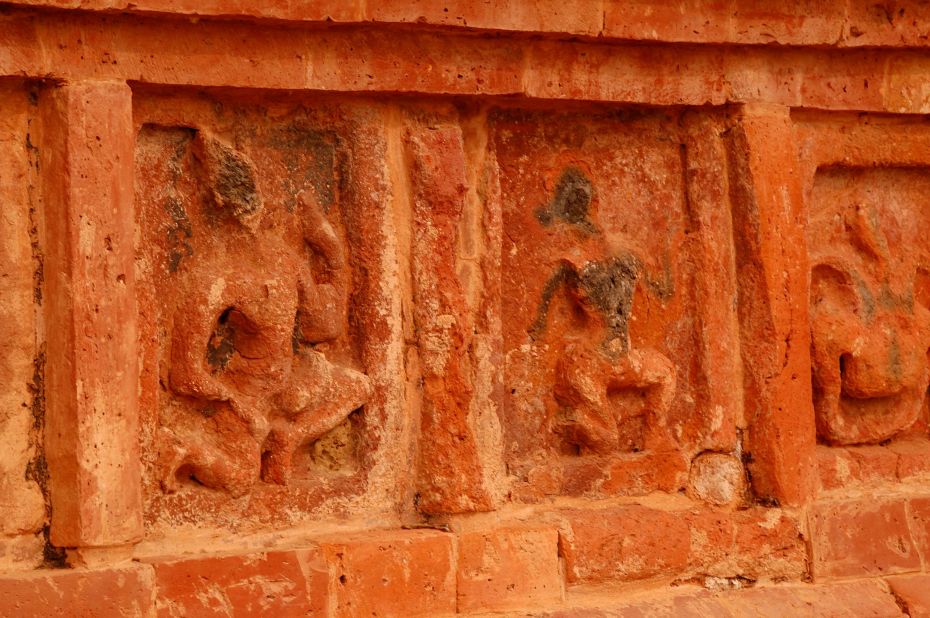
Vikramashila wall carvings. Photo by Saurav Sen Tonandada, Public Domain via Wikimedia Commons.
Adjacent to the former library, we came across an entrance to a man-made underground cave. It was around one meter (3 feet) square. Perhaps monks did retreat there in the dark, with the entrance to the cave sealed with a large rock, as they did in Tibet. According to a local man we spoke to, it has a secret passage to Bateshwar Temple, located beside the Ganges river 4 kilometers (3 miles) away. This is now a Shiva temple, but is said to feature Buddha statues as well as historic links to practitioners from Nalanda and Vikramashila. We didn’t have the time to explore it—next trip!

Ladakhi Lama circumambulating at Vikramashila, India, October 2016. Photo by Ven. Thubten Tsundue.
As sunset approached, crowds of local people arrived at the ruined monastery to enjoy the site and feel its blessings. It seems a shame that few pilgrims now visit Vikramashila, unlike Nalanda, which is much closer to Bodhgaya. Before leaving, we hung prayer flags in a small grove of trees behind the former library. Then, at 5 p.m., we reluctantly returned to our jeep as the gates closed, to drive to nearby Kahalgaon where we would spend the night before departing in the morning for Root Institute.
Being at Vikramashila was truly amazing—following in the footsteps of the great scholars and practitioners who preceded us; walking and sitting where they walked and sat, seeing where they studied and meditated and gained realizations. Their presence was still palpable. As Lama Zopa Rinpoche says, even the stones are blessed. Vikramashila’s sanctity struck me then and the feeling remains with me now. Going on pilgrimage is a reminder that holy places, with their precious blessings, still exist. And visiting the places where the holy beings we encounter in texts really lived and taught—what an inspiration!
Background: On the History of Vikramashila
In chapter 6 of Becoming Enlightened, His Holiness the Dalai Lama talks about Vikramashila, saying, “Most of the great Buddhist authors of Sanskrit texts were Nalanda scholars, and later when another great center, Vikramashila, formed, it used Nalanda’s texts and methods of study. … The great Indian figures from whom the four major Tibetan sects derive—Shantarakshita and Padmasambhava for the Old Translation sect of Nyingma, Virupa for the Sakya sect, Naropa for the Kagyu sect, and Atisha for the Gelug sect—were all great scholars at Nalanda or its derivative, Vikramashila. … In the eleventh century the Indian scholar-yogi Atisha, who was born in Bengal in a royal family and whose home institution of learning was Vikramashila, came to Tibet … [where he] composed Lamp for the Path to Enlightenment.”
Taranatha (1575-1634), a prolific writer and renowned scholar from Tibet, states in chapter 30 of his History of Buddhism in India, “King Dharmapala built Vikramashila in the north of Magadha, on the bank of the Ganga on the top of a hillock. The central temple had a human size statue of the Mahabodhi [temple]. Around it, there were fifty-three smaller temples of Guhyasamaja and fifty-four common temples, thus one hundred and eight temples.” Taranatha points out that, although it was the devout King Dharmapala who was responsible for the construction of Vikramashila, the inspiration came from the monk-scholar Haribhadra (700-770), a disciple of Shantarakshita. Historians agree that Vikramashila was consecrated in the late eighth century or early ninth century, after Haribhadra’s passing, by his disciple Buddhajnanapada. It became a center for both sutra and tantra, enduring for approximately four centuries.
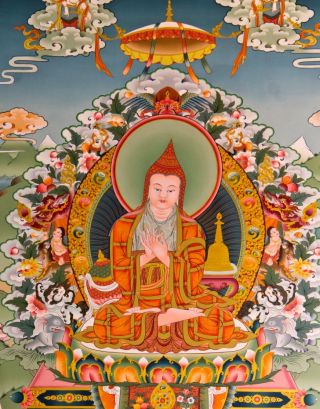
A painting depicting Atisha at Kopan’s Khachoe Chakyil Ling nunnery, Nepal, 2016. Photo by Harald Weichhart.
Atisha (982-1054) was Vikramashila’s most celebrated son. He had more than 150 teachers, and was famous as a teacher, debater, and composer of texts. One text he is known to have written at Vikramashila was A Song: Mind Deliverance from Rebirth. It was from Vikramashila in 1042 that Atisha, at the age of sixty, traveled to Tibet at the invitation of its king, Yeshe Öd. Atisha is said to have transported sixty loads of texts with his delegation on horseback to Tibet via Nepal, a journey across arduous terrain that took many months. As prophesied by Avalokiteshvara and Tara, his life was shortened by twenty years by going to Tibet, where he died at age seventy-two. Yet for Tibet, his teachings initiated a golden age of Dharma, particularly because of the popularity of his Lamp for the Path to Enlightenment. The work was written in Tibet particularly for Tibetans, and launched the tradition of lamrim or “stages of the path” literature.
Taranatha names nine prominent teachers from Vikramashila after Atisha, ending with the Kashmiri master Sakyasri (1127-1225). Sakyasri and other scholars fled Vikramashila just in time to escape the invasions that destroyed the monastery. Fortunately, by the time Vikramashila was burned, many Buddhist texts had been preserved in China and Tibet, so all was not lost.
Root Institute is planning a meditative pilgrimage to Vikramashila for December 16-19, 2017. For information, please visit www.rootinstitute.ngo.
Mandala is offered as a benefit to supporters of the Friends of FPMT program, which provides funding for the educational, charitable and online work of FPMT.
- Tagged: annie mcghee, in-depth stories, lama atisha, nalanda, pilgrimage, vikramashila
3
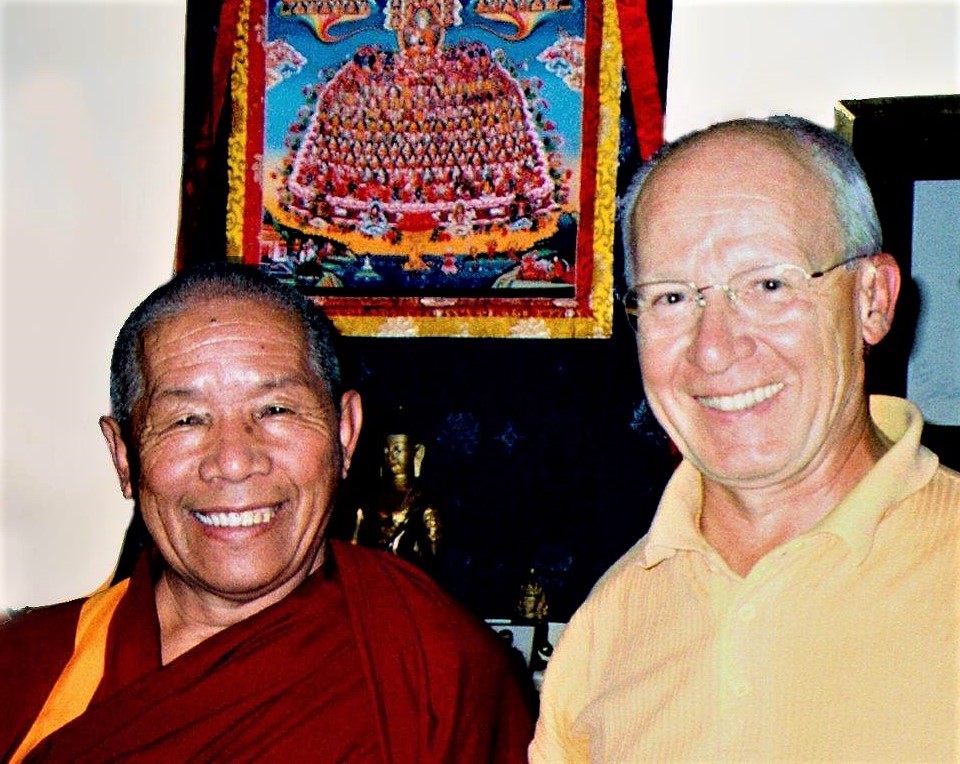
The late Khen Rinpoche Lama Lhundrup with Dieter Kratzer, Tara Mandala, Germany, 2004.
This is a German translation of the article Dieter Kratzer On Becoming a Teacher, published by Mandala online in January 2017.
Hier ist eine Übersetzung des Artikels Dieter Kratzer On Becoming a Teacher. Der originale Artikel im Englischen wurde von Mandala online im Januar 2017 veröffentlicht.
Dieter Kratzer ist ein bei der FPMT registrierter in-depth Lehrer, der bereits seit über 40 Jahren den Dharma lehrt. Er sprach mit der Herausgeberin des Mandala Magazin Donna Lynn Brown über seinen Werdegang als Lehrer seit den 1970er Jahren bis heute.
Dieter, wie hast du den Dharma kennen gelernt?

Dieter Kratzer hier bei seiner Abreise von Toronto, Kanada in 1973. Diese Reise wird ihn zum Kopan Kloster in Nepal führen. Bild mit freundlicher Genehmigung von Dieter Kratzer.
Ich verließ 1972 Kanada, wo ich gelebt habe. Von Europa nahm ich die Landroute über die Türkei, den Iran und Afghanistan, über den Khyber Pass nach Indien. In Dharamsala, traf ich auf den Dharma. Mein erster Lehrer war Geshe Ngawang Dhargyey in der „Library of Tibetan Works and Archives“. Ich lernte auch Lama Zopa Rinpoche kurz in Tushita kennen. Dann hörte ich von einem einmonatigen Kurs im Kopan Kloster in Nepal. Dort ging ich hin. Das war 1973. Ich lernte Lama Yeshe dort kennen und ich wußte sofort, ich war zuhause angekommen!
Im März 1975 wurde ich ordiniert von Lati Rinpoche und schon ein Jahr später erhielt ich die volle Ordination von Kyabje Ling Rinpoche. Ich lebte von 1973 bis 1977 in Kopan und in Dharamsala, ich praktizierte viel und war im Retreat.
Wie hast du angefangen zu lehren?
Eines Tages in Kopan, es war 1975, fragte mich Venerable Marcel Bertels , ob ich einen Vortrag über Guru Hingabe halten könnte? Die Idee stammte ursprünglich von Lama Yeshe. Ich fragte wann und er sagte: „Jetzt“! „Wie bitte, erwiderte ich?!“ Ich war geschockt aber eine Stunde später, saß ich vor 200 Schülern und hielt den Vortrag. Das war der Anfang. Ich war nervös, aber es schien den Menschen zu gefallen, das gab mir Mut.
Im Frühling 1976 wurde ich gefragt, ob ich einen Meditationskurs geben könnte, für 45 Schüler über 22 Tage lang. Zwei Nonnen assistierten mir Ven. Karin Valham aus Schweden und Elisabeth Drukier aus Frankreich. Ich hatte das Gefühl, ich kann mich auf sie verlassen, das gab mir Zuversicht. Zusammen konnten wir mit allen Schülern in deren Landessprachen sprechen, obwohl der Kurs in Englisch gegeben wurde.
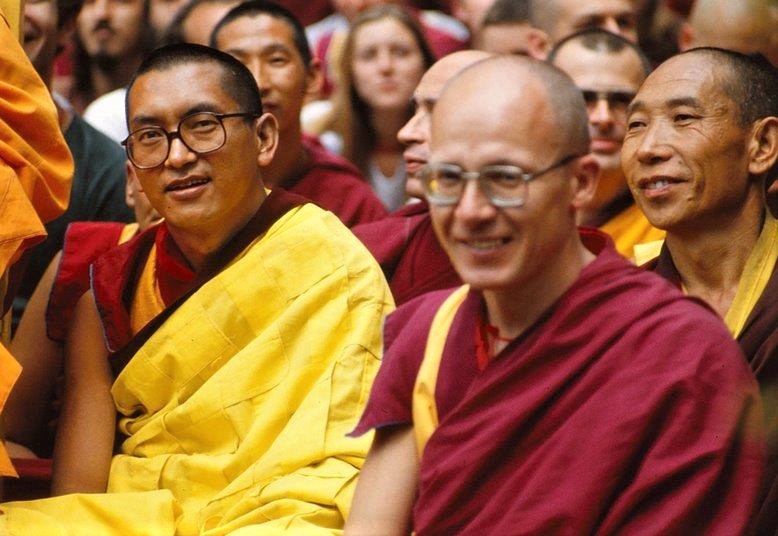
Lama Zopa Rinpoche und Dieter, 1976. Bild mit freundlicher Genehmigung von Dieter Kratzer.
Im Anschluß an den Kurs kam Ven. Nick Ribush auf mich zu und sagte: „Gut gemacht“! Ich antwortete: „Woher weißt du das? Du warst doch nicht mit dabei?“ Ven Nick lachte und sagte: „Mein Freund aus Australien hat den Kurs nicht verlassen, er blieb dabei“! Das war für ihn der Beweis.
Kurz darauf, gab ich einen weiteren Kurs. Dies waren die ersten Kurse in Kopan, bei denen ein Lehrer aus dem Westen, Schüler aus dem Westen unterrichtete. Es war wieder Ven Nick, der mich eines Tages fragte, wiederum hatte dies Lama Yeshe vorgeschlagen, ob ich nicht den nächsten November-Kurs geben möchte? „Warum nicht?“, antwortete ich. Lama Zopa Rinpoche war der Lehrer, ich führte die Meditationen seinen Empfehlungen folgend, und kümmerte mich um die gesamte Organisation des Kurses.
In den Jahren 1976-77 unterzogen sich 12 Nonnen und 15 Mönche, die Sangha, einem sehr strengen Training des Lam Rim und ich wurde gefragt, ob ich das Studienprogramm nicht entwickeln und leiten möchte. Bis heute habe ich die Notizen von damals aufbewahrt.
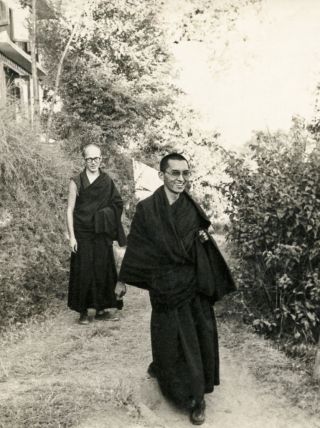
Lama Zopa Rinpoche mit Dieter Kratzer, Nepal, 1976. Bild von Dan Laine, mit freundlicher Genehmigung von Lama Yeshe Wisdom Archive.
Einmal fragte mich Ven Marcel ob ich ihm in Kathmandu bei der Unterstützung der Sangha dort helfen könnte. Aber Lama Yeshe protestierte, ich sei nicht da um Geschäfte zu leiten, sondern Kurse! Das war ein ganz klares Signal. Dann bat mich Lama Yeshe in den Westen zurück zu gehen.
So verließ ich Kopan 1977. Ich war bis fast Ende 1979 der Koordinator des spirituellen Programms am Manjushri Institut in England. Ich lehrte dort und in anderen Teilen Englands sowie in Oxfort, Cambridge und Leeds.
Wie bist du mit den kulturellen Dingen umgegangen? Ein deutscher Lehrer in England, der asiatische Weisheiten im Westen lehrt, ein Mönch unter Laien?
Meine Muttersprache war Deutsch, meine Dharma Sprache jedoch Englisch. So war es damals einfacher für mich, in Englisch zu unterrichten als auf Deutsch. Als ich später nach Deutschland zurück kehrte, nachdem ich so lange Englisch gesprochen hatte, fiel es mir schwer ganze Sätze auf Deutsch zu bilden, weil ich sie aus dem englischen übersetzte. Englisch war nicht das Problem für mich.
Was den tibetischen Buddhismus als Westler angeht: Ich hatte nicht das Gefühl, dass ich mich damals umstellen musste. Damals war es völlig okay exotisch zu sein. Das wurde erwartet wenn nicht sogar bevorzugt. Die Menschen suchten eine Veränderung der westlichen Kultur . Sie akzeptierten die Art des Lehrens, die ich von den Lamas gelernt hatte, vor allem von Lama Yeshe – er war mein Vorbild. Seine Art zu kommunizieren war unglaublich und es war mein größter Wunsch es ihm gleich zu tun.
Damals begann ich die Gespräche so: „Buddhismus – da geht es um dich! Es geht um deine Gefühle, deine Hoffnungen, deine Ängste. Es geht um deine Gedanken und wie du damit umgehst.“ Das hat die Menschen geöffnet mir zuzuhören. So schienen kulturelle Unterschiede nicht wichtig zu sein.
Später habe ich bemerkt, dass es doch kulturelle Punkte gab, die relevant waren, vor allem weil ich ein Mönch unter Laien war. Hier ein Beispiel: Ich verließ 1979 Manjushri und lehrte für einige Zeit in Frankreich. Dann bekam ich den Auftrag von Lama Yeshe: „Du gehst nach Deutschland und eröffnest ein Zentrum.“ So gründete ich das Aryatara Institut in München, wie es heute bekannt ist. Ich organisierte Kurse dort und hielt selbst Kurse ab.

Lama Zopa Rinpoche und Dieter, 1976. Bild mit freundlicher Genehmigung von Dieter Kratzer.
Da bemerkte ich erste kulturelle Gegensätze der asiatischen Tradition, die ich mir angeeignet hatte und den europäischen Sitten. Wir lebten zu siebt in einem Dharmazentrum auf dem Land: drei männliche Laien, drei weibliche Laien und ich als Mönch. Ich hatte bereits viele Retreats gemacht, einige Jahre, in Lawudo und Dharamsala usw – etwas das mir Lama Yeshe sehr empfohlen hatte. Daher hatte ich etwas mehr Dharma Erfahrung. Es wurde klar, als wir uns über Dharma in der Küche unterhielten. Das kam nicht sehr gut an bei den anderen. Ich war nicht erfahren genug. Ich hatte keinen Mentor um mich zu beratschlagen, ich war auf mich allein gestellt. Für die anderen war es eine Herausforderung einen Mönch um sich zu haben. Manche störten sich an meiner Kutte, manche nicht. Sie begannen mich für Kleinigkeiten zu kritisieren. Wenn ich z.B. schweigen wollte, fragten sie mich „Warum sprichst du nicht?“, wenn ich sprach, sagten sie: „warum sprichst du?“
Lama Yeshe empfahl mir Laienkleidung zu tragen, wenn ich in die Stadt ging, aber die anderen mochten das nicht. Und so ging es in einem fort.
Zu Lehren lag mir am meisten. In der deutschen Kultur kommt es gut an, wenn du den Menschen erklärst, warum du etwas machst. Das gibt den Menschen ein gutes Gefühl. Das verbindet die Kulturen. So habe ich viel erklärt: warum wir beten, was es bedeutet Mandalas zu legen, die Niederwerfungen, alles. Die Menschen verstanden und mochten es. Das Lehren war es, worin ich erfolgreich war. Es war mir auch am wichtigsten. Nur die gesellschaftliche Seite war schmerzlich.
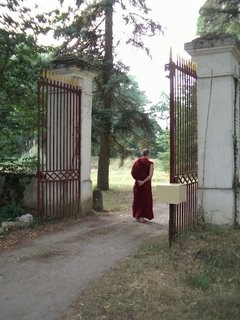
Die Tore des Nalanda Klosters, France
Nach mehreren Jahren verließ ich das Aryatara Institut und lebte im Nalanda Kloster in Frankreich. Dort war ich erneut der spirituelle Leiter des Programms. Ich sprach nur sehr wenig Französisch aber ich lehrte im Vajra Yogini Institut auf Englisch. Dort gab es keine kulturellen Hindernisse. Die Schüler klebten an meinen Lippen. Sie waren wie Schwämme, die alles aufsogen. Sie wollten wirklich den Dharma kennen lernen. Das machte das Lehren zur großen Freude für mich. Frankreich war für mich reinste Erholung nach Deutschland, ich war sehr glücklich dort.
Nach einigen Jahren im Nalanda Kloster, nachdem ich viel gearbeitet hatte, fragte ich Lama Yeshe ob ich nicht ins Retreat gehen könnte? „Komm Anfang nächsten Jahres nach Indien“, sagte er, „und du und ich meditieren zusammen“. Kannst du dir das vorstellen? Ich war überglücklich; dann wurde Lama Yeshe sehr krank und er starb im März diesen Jahres (1984). Das war sehr schwer für mich!
Ich kann mir vorstellen, dass der Tod von Lama Yeshe einen Lebensabschnitt des Dharma für dich beendet hat. Wie konntest du dich wieder einfügen und wie ging es weiter?
Ich bin nicht zur Bestattung von Lama Yeshe nach Amerika gefahren. Ich sprach mit Lama Zopa Rinpoche, der mit Lama Yeshe gesprochen hatte und Lama Yeshe hatte empfohlen, dass ich nach Indien ins Retreat gehen sollte. So bin ich gegangen. Lama wußte, dass ich weiterhin lehren wollte, aber ich benötigte eine Veränderung, um noch tiefer in die Praxis einzutauchen, damit ich, wenn ich wieder lehren würde, mehr zu geben hätte. Um zu lehren muss man wirkliche Erfahrung im Dharma haben – das ist sehr wichtig. Wir müssen Dharma werden! Ich verblieb im Retreat für fast zwei Jahre. 1986 beendete ich den Retreat. Lama Zopa Rinpoche sandte mich nach Singapore via Hong Kong.
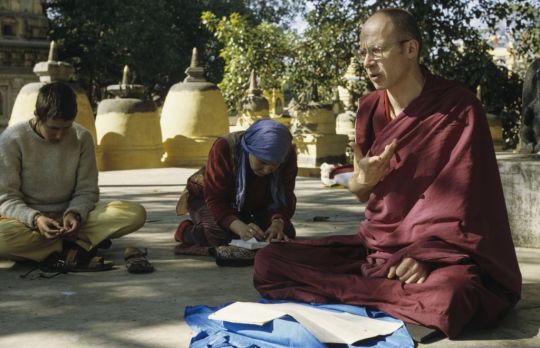
Auf Nachfrage von Lama Yeshe lehrt Dieter Kratzer über die Gelübte, Hauptstupa, Bodhgaya, India, 1982. Bild von Ina Van Delden, mit freundlicher Genehmigung von Lama Yeshe Wisdom Archive.
Was hast du in Hong Kong gemacht?
Ich unterrichtete dort für einige Monate westlichen Schülern. Anfangs lehrte ich nur im traditionellen Stil, aber das gefiel vielen Menschen nicht. „Exotisch“ war nicht mehr gefragt in dieser Zeit. So lehrte ich mehr und mehr im psychologischen Stil, was den westlichen Geist mehr traf. Das Ergebnis war großartig. Ich fing mit nur drei oder vier Schülern an und innerhalb von nur wenigen Wochen kamen über 40 Schüler. Mir wurde klar, während die Reinheit der Lehren beibehalten werden musste, es für Westler besser war, wenn die Erklärungen ihre Kultur und ihre geistige Haltung trafen.
Wie war es für dich in Singapore zu lehren?
Lama Yeshe sagte: „Wir müssen uns Richtung Osten erweitern“. Singapore bedeutet: chinesische Kultur, aber ich wußte nichts über die chinesische Kultur, gar nichts! Es begann sehr gut: Ich war ein Mönch, das gab mir automatisch Respekt. Die Schüler lernten begierig und bald schon kamen bis zu 150 Schüler zu jeden Vortrag.
Ich behielt hauptsächlich den traditionellen Denkansatz bei. Wenn ich z.B. über die vier edlen Wahrheiten sprach, zögerte ich nicht darüber zu sprechen, wie viel Leid wir erfahren. Aber ich experimentierte ein bisschen. Ich bemerkte, dass ich die niederen Bereiche wortwörtlich und psychologisch erklären konnte. Dasselbe galt für die Zufluchtnahme: ich lernte es wortwörtlich und psychologisch zu erläutern. Das bedeutet, dass jeder seine eigene Zufluchtnahme entwickeln kann; jeder kann die drei Juwelen in sich selbst entwickeln.
Am Ende lehrte ich nicht exakt denselben Weg, wie ich Westler lehrte, aber auch nicht komplett den traditionellen Weg.
In Singapore zu lehren war auf alle Fälle ein Erfolg. Und als der erste westliche FPMT Lehrer, der dorthin gesandt worden war, war es mir möglich maßgeblich an der Gründung des Amitabha Buddhist Zentrum teilzuhaben. Das fühlte sich gut an und tut es noch.
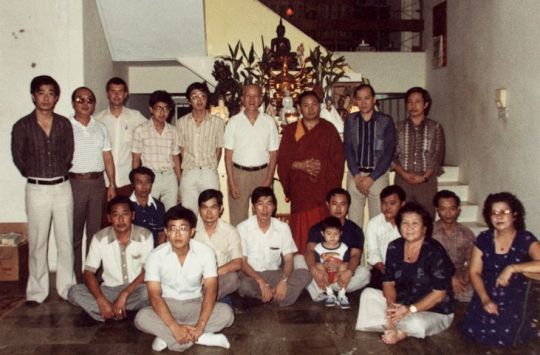
Lama Yeshe besucht Singapore, 1984
Aber persönliche Beziehungen waren schwieriger. Die Menschen dort waren sehr freundlich zu mir. Sie luden mich zum Essen ein, zu Ausflügen, sie zeigten mir die Umgebung – aber die kulturellen Unterschiede zeigten sich bald. Anfangs benahm ich mich wie ein Europäer. Aber ich bemerkte, dass ich beim Reden vorsichtiger werden musste, damit niemand sein Gesicht verlor durch das, was ich sagte. Als das passierte, bemerkte ich, dass diese Person nicht mehr mit mir reden und mich auch nicht mehr sehen wollte. Ich machte nicht viele Fehler, aber einige, das reichte um Probleme zu verursachen.
Meine größte Herausforderung war meine Mönchsrobe, welche mich „heilig“ erscheinen ließ. Klar, ich hatte einige Retreats gemacht und studiert, aber ich fühlte mich als eine normale Person mit vielen Schwächen. Wie mich die Menschen sahen und wie ich mich selber sah, war völlig unterschiedlich. Ich konnte das nicht miteinander vereinbaren. Einerseits war es schön als jemand besonderes gesehen zu werden, aber ich wusste, dass ich nicht so auf diese Art speziell war. Mein äußeres Ich war weit entfernt von meinem Inneren Ich, das machte mich sehr unglücklich. Ich wollte authentisch sein. Innerlich wie äußerlich derselbe. So habe ich ernsthaft über die Ordination nachgedacht.
Ausserdem begann ich mich mehr und mehr einsam zu fühlen. Nachdem ich z.B. 150 Schüler unterrichtet hatte und mich einer davon nach Hause gefahren hat, war ich ganz allein. Der Unterschied war immens. Zu dieser Zeit trat eine Frau in mein Leben, völlig ungeplant. Mein inneres Dilemma öffnete mich für jemanden, der mich sah wie ich wirklich war und sich um mich kümmerte, um meine Zweifel sowie um meine Werte.
Der Prozess meiner Einsicht um die Ablegung der Robe dauerte eine ganze Weile. Ich wollte immer noch unterrichten; das war mir am wichtigsten. So fragte ich Lam Zopa Rinpoche, ob ich auch als Laie Dharma lehren könnte? Er überlegte für eine Weile und sagte dann „Ja“.
Am Ende war mehr meine Orientierungslosigkeit der Grund, warum ich die Mönchsrobe ablegte. Aber meine Einsamkeit war der wahre Grund warum ich es tat.
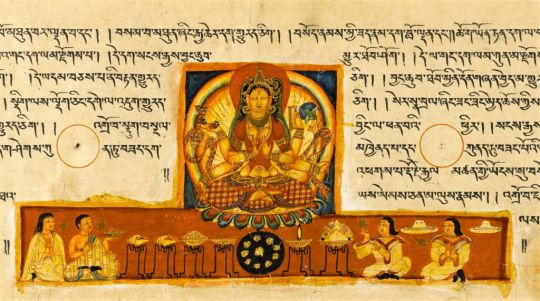
Prajnaparamita mit seinen Anhängern, Foliant von Shatasahasrika Prajnaparamita, Tibet, 11th century. Photo von Ashley Von Haeften. Flicker Creative Commons.
Wie hat das dein Leben als Dharma Lehrer verändert?
Ich lebte für einige Zeit in Frankreich. Dort kannte ich ein Paar, das eine kleine Meditationsgruppe leitete. Sie fragten mich, ob ich einen Vortrag halten könnte. Das hatte ich seit dem Ablegen meiner Mönchsrobe nicht mehr gemacht. Ich zögerte. Ich war unsicher, wie ich als Lehrer ohne Robe wirken würde? Sie baten mich es zu versuchen. So lehrte ich mit einem Mix aus Englisch und Französisch. Mein Französisch war nicht sehr gut. Und die Reaktion war überwältigend. Die Zuhörer waren sehr glücklich und noch besser, sie konnten mit meinen Worten und mir als Person Verbindung aufnehmen. Ich bemerkte, dass ich ohne Robe besser kommunizieren konnte. Als sie mir sagten, dass ich den Dharma so erklärte, dass er ihre Herzen traf, war das für mich der Durchbruch. Das war einer meiner Höhepunkte in meinem Leben als Lehrer. Es gab mir die Zuversicht, die innere Sicherheit, wieder zu lehren. Jetzt wusste ich, dass ich damit weitermachen konnte, was mir am wichtigsten war im Leben: den Dharma zu lehren.
Wie entwickelte sich dein nächster Lebensabschnitt?
Ich reiste und lehrte eine ganze Weile: durch Europa, Australien, verschiedene Plätze. Außerdem war ich für 15 Monate im Retreat in Osel Ling in den spanischen Bergen. Das war in den frühen 90er Jahren. Dann bat mich Lama Zopa Rinpoche zurück ans Aryatara Institut in Deutschland als Direktor und Lehrer zu gehen: eine wirklich große Aufgabe! Ich arbeitete sechzehn Stunden am Tag, sieben Tage die Woche. Ab und an war ich allein unterwegs. Ich lehrte verschiedene Gruppen; von einigen wurde ich eingeladen und ich lehrte auch am Aryatara Institut in München. Nach einigen Jahren des Reisens traf ich meine Frau Maria. Es war Liebe auf den ersten Blick! Phantastisch!
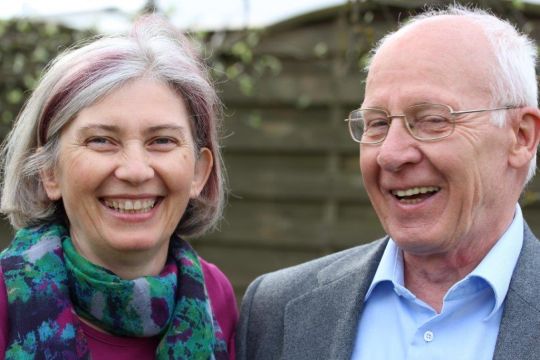
Dieter mit seiner Frau Maria. Bild mit freundlicher Genehmigung von Dieter Kratzer.
Ich schätze, das brachte weitere Veränderungen?
Ja. 1996 zogen wir in eine kleine Stadt in der Nähe von München. Ich lehrte bei uns zuhause, zuerst waren es nur zwei oder drei Schüler, aber die Zahl der Schüler wuchs rasch an. Wir bauten eine Meditationshalle groß genug für bis zu fünfzig Menschen. Mit dem Segen von Lama Zopa Rinpoche nannten wir es „Tara Mandala“. Wir kauften auch noch das Grundstück nebenan für ein Gäste- und Retreat-Haus. Khen Rinpoche Lama Lhundrup besuchte uns 2004 und schlug vor, dass wir Mitglied im FPMT werden. Anfangs waren wir eine FMPT-Studiengruppe und dann ein FPMT-angegliedertes Zentrum, das war 2008. Während der letzten zwanzig Jahre lehrte ich hauptsächlich dort.
Was hat dir geholfen, ein guter Dharma Lehrer zu werden?
Früher habe ich gedacht, weil ich fundiertes Wissen habe und gut vortragen konnte, wäre ich ein guter Lehrer. Es fehlte mir ein wenig an Demut. Ich bemerkte bald, dass es wichtig war, von meinen Schülern zu lernen. Sie zeigten mir, wo ich mich noch verbessern konnte. Einmal zum Beispiel, lehrte ich in England und wurde von Rob Preece, der ein FPMT-registrierter Lehrer und Psychologe ist, assistiert. Ich hielt einen Vortrag, wie Reinkarnation funktioniert. Im Anschluss kam Rob auf mich zu und sagte: „Dieter, das war Müll! Keiner hat verstanden, was du sagen wolltest!“ Ich war wütend. Aber auf meinem Zimmer überdachte ich die Situation. Obwohl die Lektion schmerzte, musste ich zugeben, dass er Recht hatte. Am nächsten Tag behandelten wir dasselbe Thema, aber ich erklärte es auf eine andere Art und Weise. Als ich in Robs Gesicht blickte, sah ich ihn lächeln. Ich war ihm sehr dankbar.
Ich begann also zu Lehren mit dem Gedanken alles wäre okay, aber Menschen wie Rob zeigten mir glücklicher Weise, wo ich noch an mir arbeiten musste. So habe ich mich als Lehrer weiter entwickelt.
Ich bin auch überzeugt, dass Lehrer ein lebendes Beispiel sein sollen. Der Lehrer muss die Lehre sein. Das bedeutet, nicht nur die Erfahrung des Dharma zu haben, sondern ein Leben zu führen, das zu Zuversicht anregt und die Basis formt für eine gute Beziehung zu anderen. Meine Frau Maria hilft mir sehr dabei. Wir sind seit über zwanzig Jahren ein Paar und wir leben sehr harmonisch miteinander. Sie unterstützt mich und ich unterstütze sie. Wir inspirieren andere Menschen, das macht uns glücklich und gibt uns die Kraft weiter zu machen.
Lama Yeshe sagte einmal: „Wo Energie ist, da ist ein Zentrum, wo keine Energie ist, kann kein Zentrum entstehen“. Ein Zentrum am Laufen zu halten ist nicht einfach. Es ist für einen Lehrer wichtig, an einem Platz zu bleiben, um für die Menschen da zu sein. Das unterscheidet uns von reisenden Lehrern. Sie haben keine so enge Beziehung zu ihren Studenten. Ein Beispiel zu geben für andere und gute Beziehung zu den Schülern sind beides wichtige Teile um den Dharma zu vermitteln. Lama Yeshe sagte einmal: „Wir möchten Qualität, nicht Quantität“. Das habe ich mir gemerkt. Für mich ist es am besten kleine Gruppen zu lehren und eng mit den Schülern zusammen zu arbeiten. So unterrichte ich kleine Gruppen zwischen zehn und fünfundzwanzig Schülern, mehrmals die Woche, das ganze Jahr über so dass ich die Menschen kennen lernen kann und sie sich auf mich verlassen können.
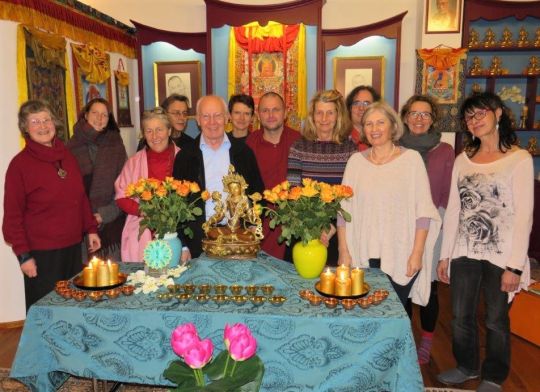
Dieter mit seinen Studenten im Tara Mandala, Deutschland. Bild mit freundlicher Genehmigung von Dieter Kratzer.
Ein weiterer Punkt wäre, obwohl ich wahrscheinlich einer der am längsten lehrende Lehrer im FPMT bin, bereite ich mich praktisch für jeden Vortrag neu vor, aus Respekt vor meinen Schülern. Ich bereite vorab den Inhalt vor, ich sammle meine Gedanken, ich konzentriere mich auf das Thema. Ich müsste das nicht. Ich kann heute zu fast allen Themen aus dem Effeff sprechen. Aber das mache ich nicht. Jeder Schüler, jede Gruppe ist anders. Ich öffne meinen Geist, und stimme mich ein. Ich kann mich in die jeweilige Gruppe hineinfühlen und so unterrichte ich dann. Ich denke, diese Intuition kommt davon, weil ich fest davon überzeugt bin, dass das was ich mache, dass Beste ist was es auf der Welt gibt. Es gibt nichts Schöneres als Dharma zu lehren.
Unterrichten ist meine Berufung und meine Begabung. Über die Jahre habe ich verschiedene Wege gelernt den Dharma zu lehren, damit die unterschiedlichen Menschen sich damit identifizieren können und danach leben können. Wenn ich unterrichte benutze ich bestimmte Wörter oder rhetorische Begriffe. Andere mögen das nicht bemerken, aber es hat manchmal Jahre der Entwicklung gebraucht, ein Thema in dieser besonderen Art und Weise zu behandeln Hier steckt sehr viel Arbeit, Reflektieren, und Erfahrung drin. Es war ein unglaubliches Geschenk 40 Jahre Zeit zu haben meine eigene Arbeit zu vertiefen, und mein Können als Lehrer zu verfeinen.
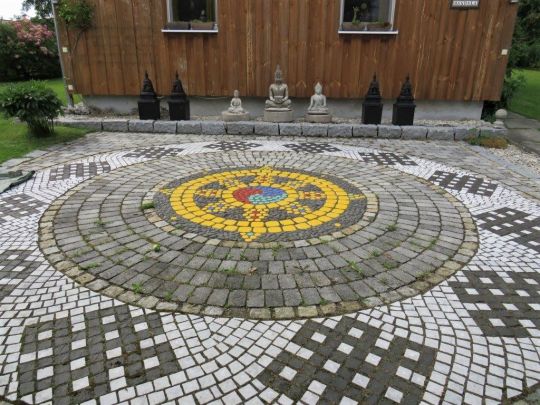
Der kopfsteingepflasterte Hinterhof of Tara Mandala, Deutschland. Bild mit freundlicher Genehmigung von Dieter Kratzer.
Was denkst du ist der beste Weg den Buddhismus auf den Westen zu übertragen?
Die Botschaft ist eine alte, aber sie ist immer noch aktuell und beschreibt den menschlichen Zustand. Die Botschaft muss weitergegeben werden, das bedeutet aber, dass sie so weiter gegeben werden muss, dass die Menschen sie verstehen. Egal welcher Kultur sie angehören.
Einmal als Lama Yeshe zu Besuch in Deutschland war sagte er: „Wenn du in Deutschland lehrst, lehre den deutschen Buddhismus!“ Er meinte, ich solle meine eigene Weisheit und Erfahrung nutzen, um meinen Unterricht der Umgebung anzupassen. Aber immer mit dem Wissen aufzupassen, die Lehre nicht zu verwässern und die Reinheit der Überlieferungslinie, die ich von ihm erhalten habe, zu bewahren. Das war eine Herausforderung, aber sehr befriedigend als ich feststellte, dass es funktionierte. Obwohl ich also meinen Unterrichtsstil je nach dem variiere, ich lehre immer die Worte Buddhas, wie Lama Yeshe mir das aufgetragen hat. Er war der perfekte Lehrer!
Grundsätzlich sind wir ja nicht Deutsche oder Tibeter, wir sind Menschen, die leiden. Die Gedanken der Menschen sind im Grund überall gleich. Ich sehe meine Rolle darin alles zu tun, das Leiden zu verringern.
Wie würdest du dein Leben als Lehrer derzeit beschreiben?
Wer hätte gedacht, dass ich den Dharma für 40 Jahre lehren würde? Ein Zentrum zu leiten und zu lehren, mit meiner großartigen Frau an meiner Seite, die Kinder aufwachsen zu sehen im Dharma, außerdem zwei Enkel zu haben, die sieben und drei Jahre alt sind und lernen zu beten und Niederwerfungen zu machen. Ich könnte nicht glücklicher sein! Ich könnte nicht mehr erfüllter sein!
Wenn ich auf die vier Jahrzehnte zurück blicke, weiß ich in meinem tiefsten Herzen, dass den Dharma zu unterrichten das größte Privileg ist, das einer Person zu Teil werden kann.
Ich verdanke es der Güte meines Lehrers Lama Yeshe, dass ich dies tun darf. Ich hoffe und wünsche mir, dass ich dies noch lange so weitermachen darf, solange ich dies körperlich und geistig machen kann. Ich habe fest vor es noch viele, viele Jahre zu machen!
Dieter Kratzer, jetzt 75, ist als “FPMT In-Depth” Lehrer registriert. 1973 hat er den Dharma gefunden und war einer der ersten Westerner, die Meditationskurse im Kopan Kloster in Nepal geleitet hat. Dieter hat jetzt 40 Jahre lang den Wunsch seines Gurus Lama Thubten Yeshe befolgt und die Arbeit ausgeführt, die ihm sehr am Herzen liegt, den Dharma zu lehren. 12 Jahre davon als Mönch. Heute ist Dieter Vollzeitlehrer im Institut Tara Mandala in Bayern, das er zusammen mit seiner Frau Maria vor 20 Jahren gegründet hat.
Der Text wurde aus dem Englischen von Katrin Veicht übersetzt und von Eva Sippl leicht überarbeitet.
Mandala Magazin ist einer der Vorteile, die man als Friends of FPMT Spender genießt. Friends of FPMT unterstützt Bildungs-, Wohltätigkeits-, und Onlineprojekte von FPMT.
- Home
- News/Media
- Study & Practice
- About FPMT Education Services
- Latest News
- Programs
- New to Buddhism?
- Buddhist Mind Science: Activating Your Potential
- Heart Advice for Death and Dying
- Discovering Buddhism
- Living in the Path
- Exploring Buddhism
- FPMT Basic Program
- FPMT Masters Program
- FPMT In-Depth Meditation Training
- Maitripa College
- Lotsawa Rinchen Zangpo Translator Program
- Universal Education for Compassion & Wisdom
- Online Learning Center
- Prayers & Practice Materials
- Overview of Prayers & Practices
- Full Catalogue of Prayers & Practice Materials
- Explore Popular Topics
- Benefiting Animals
- Chenrezig Resources
- Death & Dying Resources
- Lama Chopa (Guru Puja)
- Lama Zopa Rinpoche: Compendium of Precious Instructions
- Lama Zopa Rinpoche: Life Practice Advice
- Lama Zopa Rinpoche Practice Series
- Lamrim Resources
- Mantras
- Prayer Book Updates
- Purification Practices
- Sutras
- Thought Transformation (Lojong)
- Audio Materials
- Dharma Dates – Tibetan Calendar
- Translation Services
- Publishing Services
- Teachings and Advice
- Find Teachings and Advice
- Lama Zopa Rinpoche Advice Page
- Lama Zopa Rinpoche: Compendium of Precious Instructions
- Lama Zopa Rinpoche Video Teachings
- ༧སྐྱབས་རྗེ་བཟོད་པ་རིན་པོ་ཆེ་མཆོག་ནས་སྩལ་བའི་བཀའ་སློབ་བརྙན་འཕྲིན།
- Podcasts
- Lama Yeshe Wisdom Archive
- Buddhism FAQ
- Dharma for Young People
- Resources on Holy Objects
- Ways to Offer Support
- Centers
- Affiliates Area
- Teachers
- Projects
- Charitable Projects
- Make a Donation
- Applying for Grants
- News about Projects
- Other Projects within FPMT
- Support International Office
- Projects Photo Galleries
- Give Where Most Needed
- FPMT
- Shop
Translate*
*powered by Google TranslateTranslation of pages on fpmt.org is performed by Google Translate, a third party service which FPMT has no control over. The service provides automated computer translations that are only an approximation of the websites' original content. The translations should not be considered exact and only used as a rough guide.Karma is your experiences of body and mind. The word itself is Sanskrit; it means cause and effect. Your experiences of mental and physical happiness are the effects of certain causes, but those effects themselves become the cause of future results. One action produces a reaction; that is karma.







